

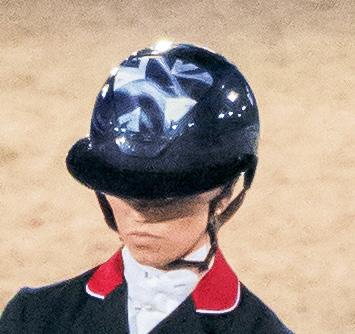
Host Nation Wins Dressage Team Gold at World Championships Herning 2022 Para-Dressage Bronze for Team USA (p. 56) The New 2023 Dressage Tests Explained (p. 28) Charlotte Fry and Glamourdale November/December 2022 Official Publication of the United States Dressage Federation GREAT DANES Renew Your USDF Membership (p. 21)
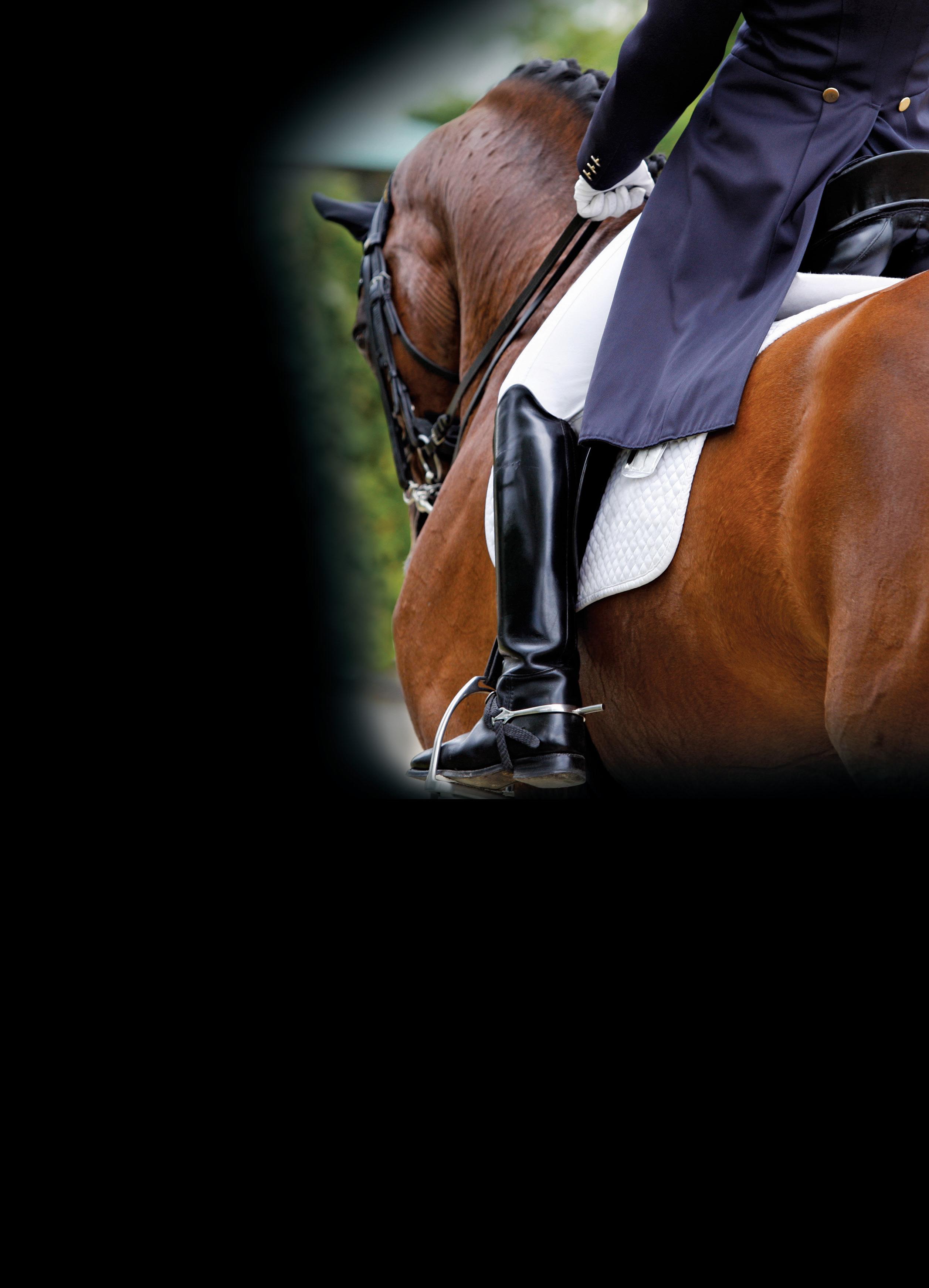

The Horse That Matters to You Matters to Us® KPPusa.com, 859-873-2974 Challenge: Optimizing performance Solution: Elevate ® Natural Vitamin E • Maintains healthy muscles, reducing soreness and stiffness. • Supports faster recovery after intense exercise. • Sustains a robust immune system. Satisfaction Guaranteed Simple Solutions, Scientifically Proven® USDF 2021-11

An official property of the United States Dressage Federation
YourDressage delivers exclusive dressage stories, editorial, and education, relevant to ALL dressage enthusiasts and is your daily source for dressage!
Look for these featured articles online at YourDressage.org
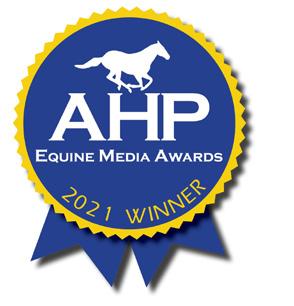
EDUCATION
“Pilates is for Both Horse & Rider”
Learn how these exercises can help you and your horse, with great tips and video examples from a rider who is also a Pilates guru.
COMPETITION
“A Lot of Work & a Little Budweiser”
A competitor in Region 8 shares about her sometimes mischievous pony Budweiser and their progress through dressage training.
ACHIEVEMENT
“Lessons Learned from a Horse Show Mom”
A Region 1 mother who grew up loving horses writes about passing this trait down to her young daughter, who now has a passion for dressage.
COMMUNITY
“Patience & Perseverance”
A Lipizzan enthusiast shares about her horse, Chester, overcoming injuries to rise to the top of the dressage ranks.
USDF CONNECTION
The Official Publication of the United States Dressage Federation
EXECUTIVE DIRECTOR Stephan Hienzsch (859) 271-7887 • stephh1enz@usdf.org
EDITOR Jennifer O. Bryant (610) 344-0116 • jbryant@usdf.org
CONTRIBUTING EDITOR Hilary M. Clayton, BVMS, PhD, MRCVS
EDITORIAL ADVISORS
Margaret Freeman (NC), Anne Gribbons (FL), Roberta Williams (FL), Terry Wilson (CA)
TECHNICAL ADVISORS Janine Malone, Lisa Gorretta, Elisabeth Williams
SENIOR PUBLICATIONS COORDINATOR Emily Koenig (859) 271-7883 • ekoenig@usdf.org
GRAPHIC & MULTIMEDIA COORDINATOR Katie Lewis (859) 271-7881 • klewis@usdf.org
ADVERTISING SALES REPRESENTATIVE Danielle Titland (720) 300-2266
USDF OFFICERS AND EXECUTIVE BOARD
dtitland@usdf.org
PRESIDENT GEORGE WILLIAMS 421 Park Forest Way, Wellington, FL 33414 (937) 603-9134
VICE PRESIDENT KEVIN REINIG, 6907 Lindero Lane, Rancho Murieta, CA 95683 (916) 616-4581
SECRETARY MARGARET FREEMAN 200 Aurora Lane, Tryon, NC 28782 (828) 859-6723
TREASURER LORRAINE MUSSELMAN 7538 NC 39 Hwy, Zebulon, NC 27497 (919) 218-6802
REGIONAL DIRECTORS
REGION 1 DC, DE, MD, NC, NJ, PA, VA
BETTINA G. LONGAKER 8246 Open Gate Road, Gordonsville, VA 22942 (540) 832-7611
REGION 2 IL, IN, KY, MI, OH, WV, WI
• president@usdf.org
vicepresident@usdf.org
secretary@usdf.org
• treasurer@usdf.org
• region1dir@usdf.org
DEBBY SAVAGE 7011 cobblestone Lane, Mentor, OH 44060 (908) 892-5335 • region2dir@usdf.org
REGION 3 AL, FL, GA, SC, TN
SUSAN BENDER 1024 Grand Prix Drive, Beech Island, SC 29842 (803) 295-2525 • region3dir@usdf.org
REGION 4 IA, KS, MN, MO, NE, ND, SD
ANNE SUSHKO 1942 CliFFord Street, Dubuque, IA 52002 (563) 580-0510 • region4dir@usdf.org
REGION 5 AZ, CO, E. MT, NM, UT, W. TX, WY
HEATHER PETERSEN 22750 County Road 37, Elbert, CO 80106 (303) 648-3164 • region5dir@usdf.org
REGION 6 AK, ID, W. MT, OR, WA
NOAH RATTNER 25033 SW Pacific Hwy, Sherwood, OR 97140 (503) 449-1274
REGION 7 CA, HI, NV
CAROL TICE 31895 Nicolas Road, Temecula, CA 92591 (714) 514-5606
REGION 8 CT, MA, ME, NH, NY, RI, VT
• region6dir@usdf.org
• region7dir@usdf.org
HELEN VAN DER VOORT 8 Boulevard West, ph4, Pelham, NY 10803 (917) 834-2635
REGION 9 AR, LA, MS, OK, TX
BESS BRUTON 5696 Piper Lane, College Station, TX 77845 (662) 702-9854
AT-LARGE DIRECTORS
ACTIVITIES COUNCIL
SUE MANDAS 9508 Bridlewood Trail, Dayton, OH 45458 (937) 272-9068
ADMINISTRATIVE COUNCIL
BARBARA CADWELL 324 Benjamin Street, Fernandina Beach, FL (715) 350 1967
TECHNICAL COUNCIL
SUE MCKEOWN 6 Whitehaven Lane, Worcester, MA 01609 (508) 459-9209
• region8dir@usdf.org
• region9dir@usdf.org
It’s YourDressage, be a part of it! Visit https://yourdressage.org/ for all these stories & much more!
• ald-activities@usdf.org
ald-administrative@usdf.org
ald-technical@usdf.org
USDF Connection is published bimonthly by the United States Dressage Federation, 4051 Iron Works Parkway, Lexington, KY 40511. Phone: 859/971-2277. Fax: 859/971-7722. E-mail: usdressage@usdf.org, Web site: www. usdf.org. USDF members receive USDF Connection as a membership benefit, paid by membership dues.
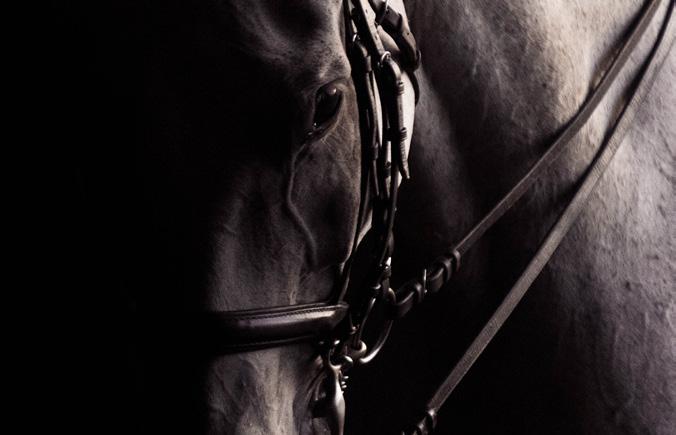
Copyright © 2022 USDF. All rights reserved.
USDF reserves the right to refuse any advertising or copy that is deemed unsuitable for USDF and its policies. Excluding advertisements, all photos with mounted riders must have safety head gear or USEF-approved competition hat. USDF assumes no responsibility for the claims made in advertisements. Statements of fact and opinion are those of the experts consulted and authors, and do not necessarily reflect the opinions of the editors or the policy of USDF.
The publishers reserve the right to reject any advertising deemed unsuitable for USDF, as well as the right to reject or edit any manuscripts received for publication. USDF assumes no responsibility for unsolicited material. All materials must be accompanied by a self-addressed, stamped envelope.
Questions about your subscription or change in address? Contact USDF Membership Department, 859/971-2277, or usdressage@usdf.org.
POSTMASTER: SEND ADDRESS CHANGES TO: USDF, 4051 IRON WORKS PARKWAY, LEXINGTON, KY 40511. Canadian Agree ment No. 1741527. Canada return address: Station A, P.O. Box 54, Windsor, Ontario N9A 6J5.
2 November/December 2022 | USDF CONNECTION
•
•
•
•
•
Features
Great Danes
Host nation wins dressage team gold; another Brit named Charlotte steals the show

By Jennifer O. Bryant
US Para-Dressage Powers up at World Championships
and medal count rise in Herning 2022
Kim MacMillan
NAYC Dressage Returns to Michigan
Top
Protection for the Dressage Horse
help
Katie Navarra
Our Cover
Charlotte Fry on Glamourdale
Columns
Inside USDF GMOs Work
By Helen van der Voort
Ringside
Deep Roots, Soaring Heights
By Jennifer O. Bryant
Departments
GMO
The First Regional Dressage Championships
By Penny Hawes
Clinic
The Aids Develop the Horse
By Beth Baumert
Rider
It’s All About the Fit
By Jennifer Mellace
The Judge’s Box
Introducing the 2023 Dressage Tests
By Gary Rockwell, Mike Osinski, Lilo Fore, Janet Foy, Kristi Wysocki, Nadine Schwartsman, and Janet “Dolly” Hannon
Salute
A Force of Nature
By Jennifer M. Keeler
My Dressage (Try to) Keep Calm and Carry On
By Robert Dover
to the top of the dressage world at the Ecco
World Dressage Championships Herning 2022. Story, p. 42. Photo by Jennifer Bryant.
Basics
Office Contact
Index
USDF CONNECTION | November/December 2022 3
4
6
16
20
24
28
38
72
8 Contact 10 Sponsor Spotlight 11 Collection 68 Rider’s Market 70 USDF Connection Submission Guidelines 70 USDF
Directory 71 Advertising
On
Britain’s
rocketed
FEI
42
56
Scores
By
60
North American youth competitors vie for prestigious medals 64 Leg
Do boots and wraps
or hinder? Experts weigh in By
USDF Connection NOVEMBER/DECEMBER 2022 Volume 24, Number 4 42
GMOs Work
From the “grass roots” to USDF governance, GMOs are an integral part of our dressage community
By Helen van der Voort, USDF Region 8 Director

Nearly20 years ago, my hunt er/jumper instructor encour aged me to take a couple of dressage lessons to “find my seat.” I soon fell in love with the connection I felt with the horse—something I had never experienced before.
I joined my local USDF groupmember organization (GMO) and started going to schooling shows, then to recognized shows. I’ve stuck with dressage thanks in no small part to the instruction, support, and friend ships that have come from my GMO.
GMOs are a national network of about 100 USDF-affiliated dressage clubs. In addition to the local oppor tunities they offer, GMO members and the clubs themselves can tap into an array of benefits provided by the USDF. Among them: marketing assistance, including access to USDF-created ads, national exposure on USDF’s online platforms; educational support, including eligibility to apply for GMO grants through USDF and The Dressage Foundation’s Violet Hopkins Fund; and eligibility to compete for USDF GMO awards.
When you join a GMO, you automatically become a group member (GM) of USDF. GMs receive discounts at the USDF store and with USDF partners, resources including the magazine you’re reading, access to online educational resources, and the opportunity to participate in various USDF awards programs, to name just a few. Visit the GMO section of the USDF website to see all the details.
Aside from all of the above, what’s so great about being a member of a GMO? What do these clubs offer? I surveyed a wide variety of GMO members across Region 8, including
trainers, riders, and judges. Here are some of their responses.
It is wonderful to support—and be supported by—a group of local dressage enthusiasts, regardless of one’s riding ability. GMOs can address members’ local needs and provide local advice. One person mentioned how helpful it was to join a GMO when she moved to a new area. Social and networking opportunities are equally important: For instance, one GMO offers a virtual happy hour during which members share book and video recommendations.
GMOs play a huge role in providing dressage educational opportunities. USDF relies on GMOs to host L programs and continuing-education programs for L graduates. GMOs sponsor schooling shows, which enable competitors to test themselves or to give new or green horses exposure to the show environment without the pressure and expense of a recognized show. Some GMOs participate in USDF’s Regional Schooling Show Awards program, and many offer their own year-end awards programs, as well. Clinics are a GMO
mainstay, from the traditional lessonstyle format to “fix-a-test” events and sessions on how to ride the new tests.
Volunteerism is at the core of every GMO. Most clubs’ activities cannot happen without volunteer support. In the case of dressage clubs, volun teering often has educational benefits, with scribes, clinic helpers, and others literally placed next to the action. Plus, it’s fun!
One member told me that she has enjoyed giving back to her GMO by taking on a leadership role in the organization. Another has found her leadership role to be an excellent networking opportunity. Successful GMOs reach out to their local communities to cast a wider net for prospective members and to provide equestrian education to the unini tiated. All highly recommend joining GMO management and specifi cally called out the need for younger members to provide new ideas. Our youth riders, as we know, are the future of our sport.
GMOs are critical to the appeal and growth of our sport. So many of us came to dressage through a local GMO, and increasing the membership of GMOs will be critical to our future. What’s more, GMOs play a critical role in influencing the direction of USDF and the dressage discipline in the US through repre sentation in the USDF Board of Governors and on the USDF Group Member Organizations Committee.
Many thanks to all who gave me insight into your GMO experiences. To learn more about USDF’s GMO system, check out usdf.org/clubs/gmo.
4 November/December 2022 | USDF CONNECTION
COURTESY OF HELEN VAN DER VOORT
Inside USDF


Deep Roots, Soaring Heights
Without a strong foundation, our sport couldn’t thrive as it does
WhenI sit down at my com puter to write this column, sometimes I know exactly what I want to say. The piece is mostly already composed in my head, and the writing is mainly a process of letting the words spill out of my fingertips and onto the screen.
Other times, I’m not so sure how I’m going to fill that blank page in front of me. As my cursor blinks expectantly, I find myself reviewing that issue’s lineup, looking for inspi ration or common threads.

The latter is what happened with the issue you’re reading. As I was casting about for ideas, I was struck by how this issue combines a celebration of the very apex of our sport—the achievements of the world’s elite at the Ecco FEI World Championships Herning 2022—with salutes to two pioneers in American dressage.
In her “Salute” to Janine Malone (p. 38), freelance writer Jennifer Keeler profiles the remarkable life and career of a woman who has created, volunteered for, and done nearly everything that concerns US dressage competition, judging, and sporthorse breeding. Janine is already a recipient of the USDF Lifetime Achievement Award; this December, she will be inducted into the Roemer Foundation/USDF Hall of Fame at the 2022 Adequan®/USDF Annual Convention in Lexington, Kentucky (USDF’s first in-person convention since 2019—can’t wait!).

Then, in her “GMO” column, freelance writer and longtime GMO volunteer Penny Hawes traces the origins and development of a one-of-a-kind regional dressage championships, Region 1’s Col. Bengt Ljungquist Memorial Championships.

The CBLMs are a GMO-driven championships that have retained their prestige and relevancy even with the popularity of the USDF Regional Championships program. They are named in memory of the late Swedish master who broke ground in educating US instructor/trainers and who coached the US team to its first Olympic dressage medal in 28 years, bronze in Montreal 1976.
The subject matter in this issue— from World Championships medalists to local riders and shows, and every thing in between—reminded me that no high-performance rider starts out in that lofty position. Every dressage enthusiast sprouts from the “grass roots.” Show me a Lendon Gray or a Katie Duerrhammer, and I’ll show you a kid mucking around with assorted nondescript equines, goofing off bareback and learning how to pick feet and clean stalls. Our top riders and trainers benefited from the programs in place at the time that they were coming up in the sport, and many of them have gone on to give back to dressage—financially, through service, or both.
It is important that those at the
top of the sport remember where they came from and make an effort to connect with and contribute to the dressage community in some way—and I’m not talking about through slick social-media accounts. I have seen the excitement and anticipation on the faces of USDF members as they stood in line at a USDF convention for the opportunity to meet their idols—the members of that year’s US dressage team—at an autograph session. That moment of connection, or that time when someone offered a horse to ride, a lesson, or some other opportunity, can make all the difference in a “grass roots” rider’s life, as well. As Janine Malone herself recounts, she was a hard-working kid with a love of horses and few resources when some members of her equestrian community recognized her drive and decided to offer her a leg up. Today she’s one of the most influential people in US dressage, and none of it would have happened had someone not reached out.
I hope you enjoy learning about all of the accomplishments highlighted in this issue, and I also hope to see you in Lexington at the USDF convention. Finally, I hope this holiday season brings you many moments of celebration and joy—and perhaps an opportunity for you, too, to give back to the sport and the horses we all hold dear.
Happy holidays!
Jennifer O. Bryant, Editor @JenniferOBryant
MICHAEL BRYANT
6 November/December 2022 | USDF CONNECTION
Ringside

Dealing with Laminitis

Thank you for the very informative, clearly written ar ticle “New Hope for Laminitis” (July/August).

Fortunately
I haven’t had to deal with laminitis, but what did strike me were the treatment similarities between laminitis and polysac charide storage myopathy (PSSM) type 1. I have a 12-year-old Quarter Horse who has tested positive with two copies of PSSM1 with which we seem to be successfully coping, but I wonder if one of the veterinarians would comment on it, especially as to whether laminitis is a concern with PSSM1 or PSSM2 horses.
Carol Moffatt Chesterfield, Missouri
Mark T. Donaldson, VMD, responds: This is a great question and observation. I am not aware of a link between PSSM and laminitis; however, the observation that the treatments are similar is because PSSM is a disorder of carbohydrate metabolism at the level of the muscle cell, and risk factors for laminitis are abnormalities in carbohydrate metabolism at a systemic level.
Regarding the task of icing lami nitic feet: My friend’s horse had a serious hoof injury and needed ic ing for long periods of time. Since we lived in a northern climate, she grabbed snow for the horse to stand on. What else is portable and easy to freeze? Reusable gel ice packs, which come in various sizes. My friend was able to wrap them around the hooves for hours, then easily replace thawed packs with refrozen ones. If your barn has a freezer, you can keep them on hand for immediate use. Another benefit: It was easy to see how quickly the packs thawed and where they were
thawing most rapidly, which helped to indicate how much heat was in the hoof and where the greatest con centration of heat was located.
Pat Czachowski St. Charles, Illinois
Please Keep the USDF Logo

I just had to respond to the recent letter ar guing that the USDF should change its logo (“Contact: USDF Logo Should Be Gen der-Neutral,” July/ August).
I love the USDF logo and hope it never changes. I’ve never been upset by the term horsemanship, as I take the word man to mean human Dressage is about the progress and journey between horse and human. I have never been offended by the fact that the USDF logo depicts a male rider; I actually never gave it a second thought.

It is a great logo in that it is clear and balanced as a piece of artwork, depicting an important part of a dressage test. I’ve designed a number of logos professionally, the first one being for a local combined-training club. Though that was many years ago, no one was concerned as to whether the rider in the logo was male or female. It just doesn’t matter!

We are in a sport that allows us all to compete equally, as one human and one equine. Can we just embrace that?
Penny Timoshevick Aguila, Arizona
USDF Connection welcomes your feedback on magazine content and USDF matters. Send letters to editorial@usdf.org along with your full name, hometown, and state. Letters may be edited for length, clarity, grammar, and style.
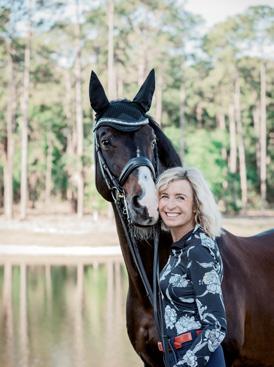
8 November/December 2022 | USDF CONNECTION
Contact Build Fitness for the Upper Levels with Dr. Hilary Clayton (p. 20) Develop Confidence & Strength with Charlotte Bredahl (p. 28) The Latest on Laminitis (p. 54) Charlotte Jorst and Kastel’s Nintendo July/August 2022 Official Publication of the United States Dressage Federation PRESERVE YOUR HORSE’S LONGEVITY Custom- Fit Boots For over a century, the Dehner name has been proudly worn by young and old alike. Feel for yourself the comfort and fit that have made us one of the most sought after boots in the business! Log on today to view our full line of boots and shoes Tel: (402) 342 7788 * Fax: (402) 342 5444 www.dehner.com Made in the U.S.A


Official Supplement Feeding System of USDF
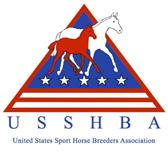





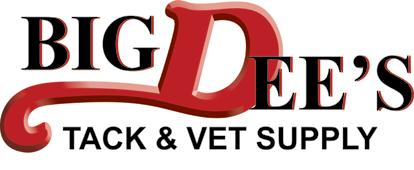
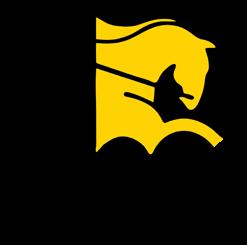

THANK YOU FOR SUPPORTING USDF Official Equine Insurance Provider of USDF Title Sponsor Great American Insurance Group/USDF Regional Dressage Championships Supporting Sponsor US Dressage Finals 800-553-2400 www.platinumperformance.com 800-303-7849 www.dressageextensions.com 402-434-8585 www.dressagefoundation.org 800-611-6109 www.dressagearena.net 800-324-2142 www.bigdweb.com 502-585-3277 sterlingthompson.com Official Joint Therapy Sponsor of USDF Title Sponsor Adequan®/USDF FEI-Level Trainers Conference Annual Convention and Awards Presenting Sponsor US Dressage Finals 800-458-0163 www.adequan.com
Presenting Sponsor Great American Insurance Group/USDF Regional Dressage Championships Supporting Sponsor US Dressage Finals Official Supplier Great American Insurance Group/USDF Regional Dressage Championship Jackets 800-461-8898 www.smartpakequine.com USDF Breeders Championship Series THANK YOU TO OUR SPONSORS.
Collection
Bits and Pieces from USDF and the World of Dressage
IN THE FRAME
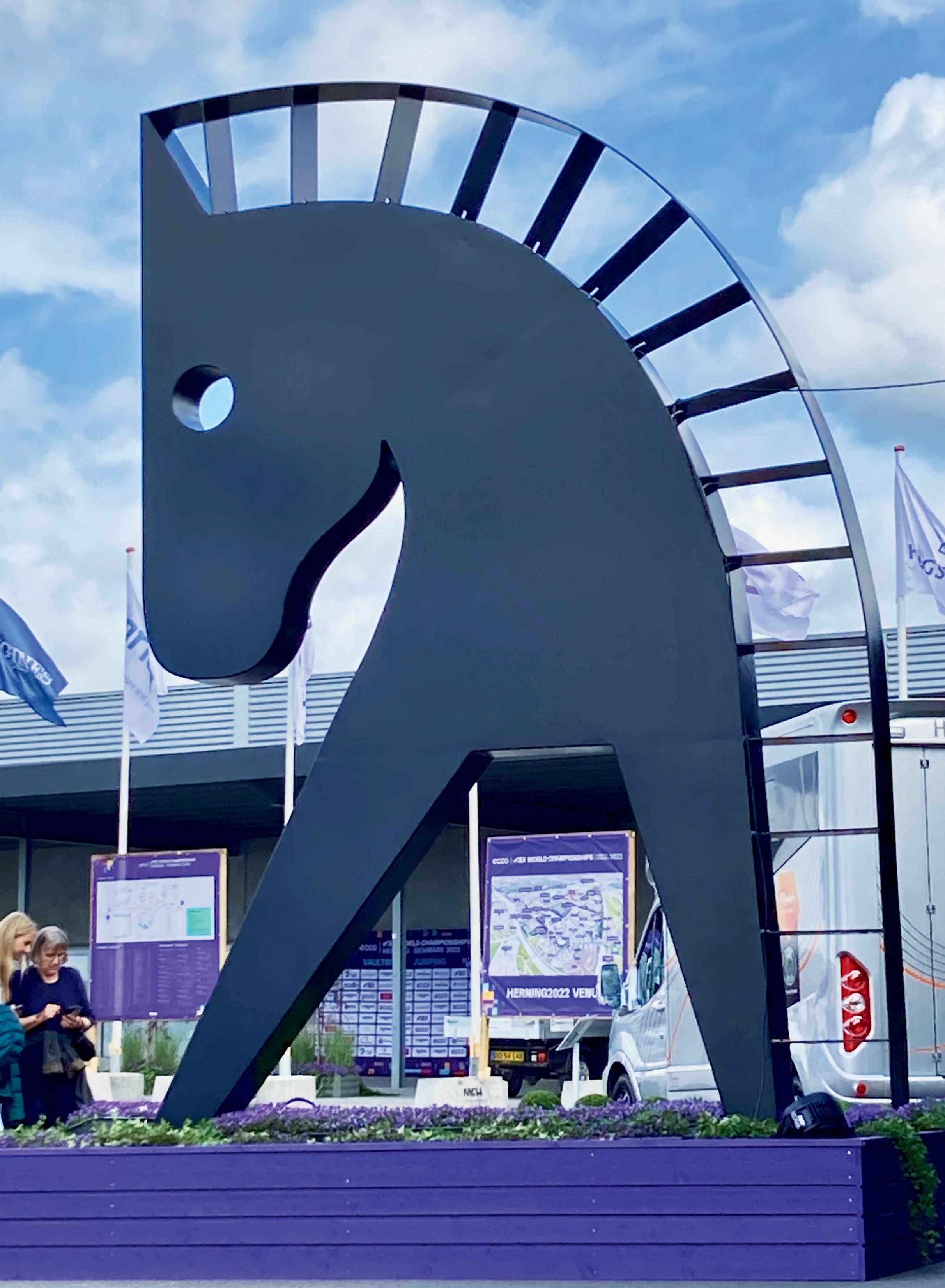
USDF CONNECTION | November/December 2022 11
★ USPEA Elects Interim President ★ 48 Hours Features Barisone Attempted-Murder Case ★
JENNIFER BRYANT
This giant horsehead statue depicting the logo of the 2022 Ecco FEI World Championships in Herning, Denmark, made for a favorite spectator photo op. Our coverage of the Herning 2022 dressage and para-dressage competitions begins on page 42.
PARA-DRESSAGE
USPEA Elects New Interim President, VP
Former United States Para-Equestrian Association (USPEA) secretary and vice president Christina “Tina” Wentz, of Richardson, Texas, has been elected the organization’s interim

president, the USPEA announced in August. Carole Lee Laulis, senior staff instructor and volunteer coordinator at Thorncroft Equestrian Center in Malvern, Pennsylvania, was elected USPEA vice president.

The elections were held following the death in June of USPEA founder and president Hope C. Hand (read her obituary in the September/October issue of USDF Connection).
Wentz has personal ties to the para-dressage sport: Her son, Jonathan Wentz, who died in 2012 of a heart condition at age 21, had just weeks earlier competed at the London Paralympic Games as a member of Team USA. Tina Wentz has volunteered in para-equestrian sport since 1997, serving as a US national classifier and then on the board of the USPEA since its founding in
2009. She is also an FEI international classifier, the head US para-dressage selector for FEI World Champion ships and Paralympic Games, a past member of the US Equestrian (USEF) International Disciplines Council, and a current member of the USEF ParaEquestrian Sport Committee.
Laulis has been with Thorncroft Equestrian Center for more than 30 years. She is a PATH Intl. certified therapeutic-riding instructor, a USEF para-dressage silver-level coach, and head coach for Special Olympics Team Pennsylvania.

The USPEA (uspea.org) is the national USEF para-equestrian affiliate organization. Its mission is to help develop, promote, support, and sustain US para-dressage athletes, with a focus on emerging competing athletes.
FINANCIAL AID
The Dressage Foundation (TDF), Lincoln, Nebraska, has received a $5,000 grant from the USA Eques trian Trust to support its Young Rider International Dream Program.
TDF’s Dream Program, the brain child of US Olympic dressage bronze medalist Michael Poulin, sends a handful of promising young riders to a famous dressage destination—tradi tionally Europe, and more recently Wellington, Florida—on a chaperoned tour with behind-the-scenes access to notable trainers, facilities, and compe titions for an immersive educational experience. Learn more about the program at DressageFoundation.org.
The grant was one of 15 awarded in 2022, for a total of nearly $70,000. The USA Equestrian Trust, Lexington, Kentucky, is a private foundation whose mission is to assist nonprofit organizations in preserving or enhancing the quality of equestrian sport in the US. For more information
and to learn how to apply for a grant in 2023, visit TrustHorses.org.
Young Dressage Pros Receive TDF Grants
Kevin Hadfield, Mendon, Massachu setts; and Jaclyn Pepper-Millard, Petaluma, California, each have received a $5,000 grant from The Dressage Foundation’s (TDF) George Williams Young Professional Fund, TDF announced in August.
The fund, established in 2019 in honor of USDF president and US national dressage youth coach
George Williams, provides grants to instructor/trainers aged 25-35 toward the pursuit of continuing-education opportunities.
Hadfield, a dressage pro since 2019, plans to use the grant money to attend the USDF Instructor/Trainer Program and for intensive training with high-performance rider Olivia LaGoyWeltz. Pepper-Millard, an instructor since 2012, also plans to attend the USDF Instructor/Trainer Program and will work with 2020 US Olympic dressage team silver medalist Sabine Schut-Kery.
12 November/December 2022 | USDF CONNECTION
COURTESY OF USPEA; ICTORIAL TALES
PHOTOGRAPHY/BETHANI CHADBOURNE; EMILIE JAME
Collection
DEDICATED: New USPEA interim president Tina Wentz
TDF Receives USA Equestrian Trust Grant for ‘Dream Program’
LEG UP FOR YOUNG PROS: Grant recipients
Kevin
Hadfield and Jaclyn Pepper-Millard
USDF BULLETINS THE NEAR SIDE
Attention, 2022 Awards Recipients
Rider and year-end awards will be mailed to recipients in January 2023. Please contact the USDF office if you have not received your award by February 28, 2023
Last Call to Nominate for the 2022 USDF Regional Schooling Show Awards Program
The USDF Regional Schooling Show Awards Program offers annual awards and regional rankings for USDF group members. Four award divisions (open, junior/ young rider, adult amateur, and non-professional) are available. Nominate now on the USDF website under Awards: Regional Schooling Show Awards. The deadline to nominate and submit scores for 2022 is December 21!
L Program Accepting Faculty Applications
Faculty-member applications for the renowned USDF L Education Program are now being accepted. To be eligible, applicants must meet the following requirements:
• US Equestrian “S” dressage judge for two or more years
• Experience teaching in a classroom/lecture environment
• Willing to serve on the USDF L Program Committee and to assist in working toward the committee’s goals. Please contact the L Program Committee liaison at lprogram@usdf.org for an L faculty application and additional information.
MEET THE CERTIFIED INSTRUCTOR/TRAINER
Susan Snethkamp, Melbourne Beach, Florida
Susan Snethkamp is a USDFcertified instructor/trainer through Second Level with more than 30 years of experience. She has earned her USDF bronze, silver, and gold medals; is a USDF L graduate with distinction; and holds a master’s degree in education with a commu nication, IT, and physical-education degree.

How I got started in dressage: I got started in dressage in England in the 1970s and then studied under Jim and Sharon Rowe. Later, Carole Grant and Jan-Ove Olson were my mentors. I had a successful showing career; one high point was when my horse Turbo and I were first alternates for the US Olympic Festival in 1993.
I wanted to get certified because: My love for teaching is why I became a USDF-certified instructor/trainer. I believed we needed a system for trainers in the US. I signed up as soon as I learned about the opportunity.
What surprised me the most about the process: The wealth of knowledge being shared.
Tip: My tip for prospective trainers is to be open-minded. No matter how much you know or have already done, you have to empty the glass before you can fill it.

Contact me: kampdressage@ gmail.com or (586) 747-3185.
—Alexandria Belton
USDF CONNECTION | November/December 2022 13 COURTESY OF SUSAN SNETHKAMP
OPEN TO LEARNING: Snethkamp
DRESSAGE AT LARGE
Barisone Case Featured on TV’s 48 Hours
The US dressage world got a splashy albeit sordid dose of national attention when the CBS crime-and-justice series 48 Hours turned its cameras on the case of Olympian Michael Barisone, who in 2019 was charged with the attempted murder of his then student and farm tenant Lauren Kanarek and her boyfriend, Robert Goodwin.


As reported in this magazine’s July/August issue, in April of this year after a three-week trial, Barisone was found not guilty of attempted murder by reason of insanity. Kanarek had been shot twice in the chest. During the trial and in an interview with 48 Hours, Barisone claimed to have no memory of the incident, which left Kanarek in intensive care for 19 days
and Barisone himself hospitalized with injuries apparently sustained while scuffling with Goodwin.
Viewers of the September 17 segment, entitled “The Shooting of Lauren Kanarek,” heard audio from several 911 calls and saw disturbing images of Kanarek hospitalized on a ventilator, post-surgery close-ups of her wounds, and images of a battered and bloodied Barisone, handcuffed to his hospital bed.
The segment laid out the two opposing sides of the story, with both parties’ lawyers reiterating their arguments, which portrayed Kanarek as either a victim of gun violence by an untruthful Barisone, or a jealous and vengeful woman who mounted a campaign of harassment and threats against the trainer, to the point that he cracked
psychologically. As in the trial, several prominent equestrians went on record to vouch for Barisone’s character and to comment on the degree to which the ordeal had affected him mentally. Among those appearing in the 48 Hours segment were US Olympians Michael Poulin, Phillip Dutton, and Boyd Martin.

48 Hours’ report ended with the news that on September 7, a judge ruled that Barisone must spend at least six months at a New Jersey psychiatric hospital, with his next hearing set for March 2023. The criminal trial is over, but a lawsuit by Kanarek against her former trainer and his countersuit against her are ongoing.

For more on the segment, go to cbs.com/shows/48_hours.
—Jennifer Bryant
14 November/December 2022 | USDF CONNECTION Collection
TANGLED WEB: CBS’s docu-series 48 Hours brought the attempted-murder case against US elite dressage competitor Michael Barisone to a national audience. Stills from the segment show (clockwise from top left) Barisone in his first interview since his arrest in 2019; undated footage of Barisone competing; the shooting victim, Barisone’s former student Lauren Kanarek, in the saddle; and an interview with US Olympian Michael Poulin, who defended Barisone’s character.
Circle of Friends
CIRCLE OF FRIENDSCIRCLE OF FRIENDS
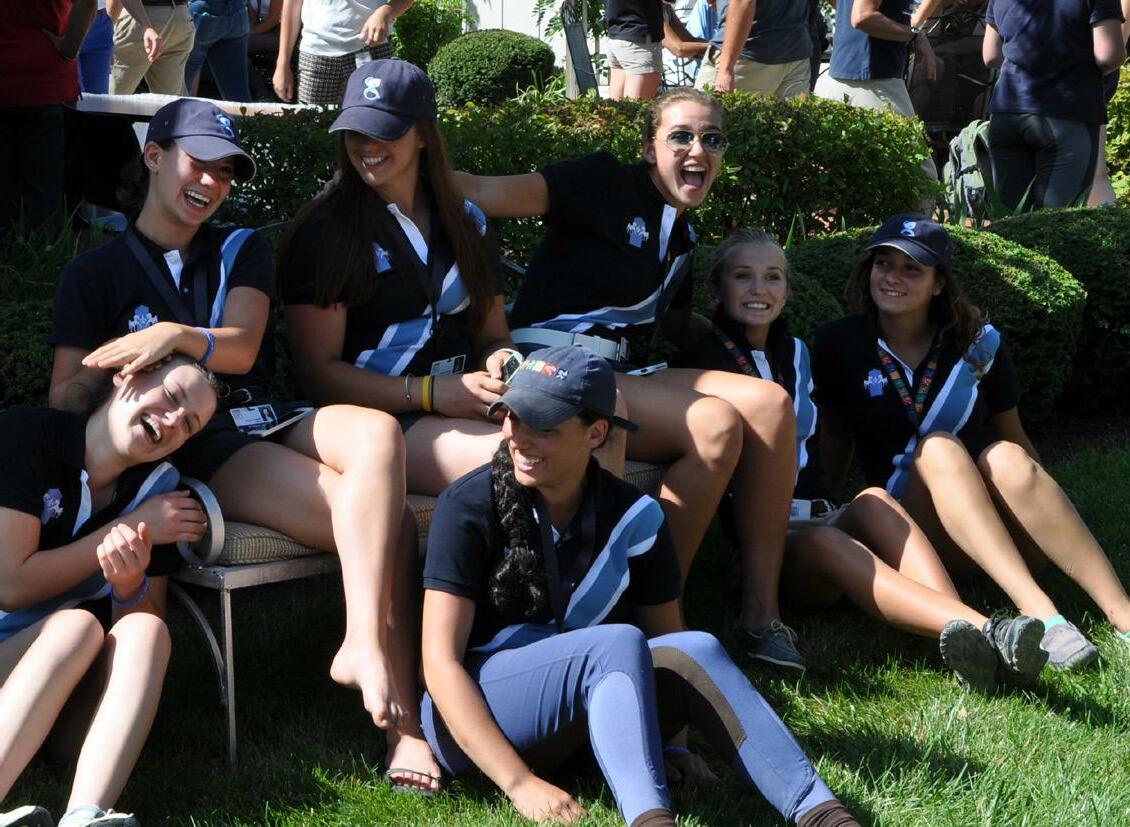
Monies collected through the Circle of Friends have made it possible for USDF to offer over 30 educational programs and 2000 annual awards, while furthering the organization’s mission of education, recognition of achievement, and promotion of dressage. By donating to the Circle of Friends, you are not only supporting these endeavors, but also your ‘friends’ throughout the dressage community. Visit USDF’s secure online giving site at www.usdf.org/donate. Questions? Please email us at donate@usdf.org or call 859-971-2277.
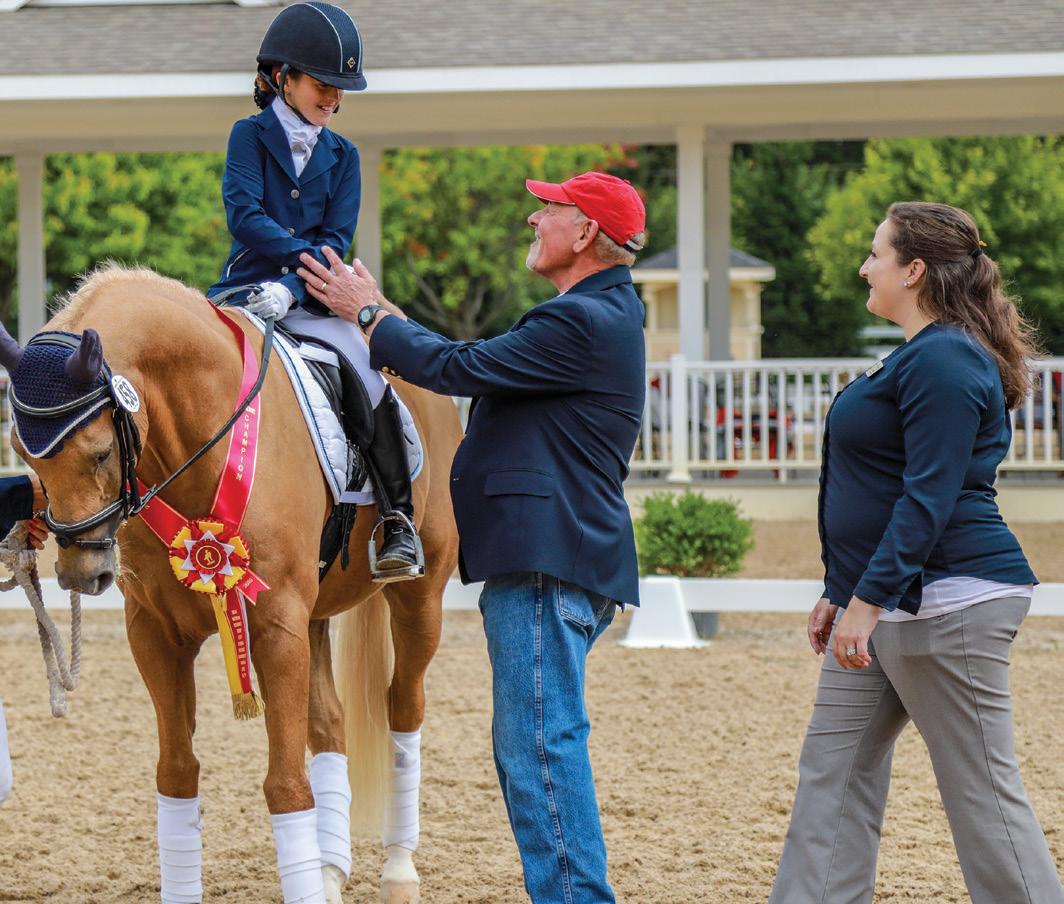


Your Sport...Your Com munity...Your
The First Regional Dressage Championships

Even in a crowded competition calendar, Region 1’s Col. Bengt Ljungquist Memorial Championships are still going strong
By Penny Hawes
Everyfall in USDF’s Region 1, the tradition of a unique dres sage championships continues.
Predating the USDF Regional Championships program, it’s the Colonel Bengt Ljungquist Memo rial Championships (CBLMs). Open only to members of participating USDF group-member organizations (GMOs), the CBLMs celebrated their 40th anniversary this year.
To mark this milestone and to find out why the CBLMs continue to flourish even alongside the Great American/USDF Regional Cham pionships and other major compe titions, we spoke with the event’s
A Swedish cavalry officer, Ljungquist (1912-1979) competed in five Olympic Games for his native country. You might be surprised to learn that at only one (Tokyo 1964) did he compete in dressage; at the other four, the versatile sportsman competed in fencing, the sport for which he was actually more famous. Ljungquist was also the Swedish dres sage reserve rider for the 1960 Rome Olympics and a six-time Swedish national dressage champion.
A lifelong rider, Ljungquist was born into a military family and joined the Swedish army after secondary school. His military service included
dressage trainer and instructor. Dur ing a trip to the US, he was offered a position teaching dressage at the Foxcroft School in Virginia. He and his wife moved to the US in 1970, and in 1974 Ljungquist became the US dressage-team coach, a posi tion he held until 1978. Under his leadership, the US dressage team won the gold medal at the 1975 Pan American Games, team bronze at the 1976 Montreal Olympics, and a fourth-place finish at the 1978 World Championships.
International competitor and future FEI “O” (now 5*) dressage judge Linda Zang invited Ljungquist to train out of her Idlewilde Farm in Davidsonville, Maryland, and in the late 1970s Idlewilde was a major training hub for many of the top US dressage riders of the day.
A strong advocate for the education of US dressage judges, Ljungquist helped to develop a training program for the Po tomac Valley Dressage Associa tion (PVDA). The PVDA program became the model for most judges’ training programs in the US, culminating in the creation of the renowned USDF L Education Program. Another of Ljungquist’s enduring legacies is the modern classic Practical Dressage Manual, published in 1976.
founder and with more recent stew ards of the competition, who are determined to take the CBLMs to the half-century mark and beyond.
The Namesake
The history of the CLBM champi onships begins with the late Col. Ljungquist.
posts as commander of the Royal Horse Guards in Stockholm begin ning in 1995, with duties including organizing the equestrian events of the 1956 Stockholm Olympics.
After the Swedish cavalry became mechanized, Ljungquist retired from the army and began a second career as a highly respected
For his contributions to Ameri can dressage, Ljungquist was inducted into the Roemer Founda tion/USDF Hall of Fame in 1998.
Creating a New Legacy
A non-horseman was the driving force behind the establishment of the championships that honor one of the world’s most prominent horsemen.
16 November/December 2022 | USDF CONNECTION PICS OF YOU GMO
REGIONAL SPIRIT: Region 1’s GMOs enjoy participating in the Col. Bengt Ljungquist Memorial Championships, a unique regional tradition. Pictured is Maryland-based FEI-level trainer/rider Fellcitas von Neumann-Cosel winning the 2012 Grand Prix title aboard the Lusitano stallion Tonico do Top.
After moving from western Pennsylvania to Maryland in 1980, Dr. Sam Barish—whose wife at the time was a dressage enthusiast—be came involved with the PVDA. He joined the PVDA board within the year (and later went on to become USDF president).

Barish learned that the only championships available to dressage riders at the time were run by the American Horse Shows Association (AHSA, now US Equestrian), and he thought the barriers to entry were steep, besides which, the lowestlevel riders couldn’t participate.

“AHSA did not have Training Level in the championships,” Barish says, “and they were expensive. You had to be a member, your horse had to be registered, the owner had to be a member, and you needed to attain multiple qualifying scores. You had no real input.
“I thought, ‘We have all these dressage associations. Why don’t we put a championship together where the dressage associations can set the rules and make all the decisions, and have Training Level and make it simple?’”
Barish worked with Gail Larson, then president of the Virginia Dres sage Association (VADA). Represen tatives of six Mid-Atlantic dressage associations met, created rules, and
USDF CONNECTION | November/December 2022 17 USDF ARCHIVE
THE MASTER: Col. Bengt Ljungquist in an undated photo
organized the inaugural champion ships, which offered divisions from Training through Fourth Level at Prince George’s Equestrian Center in Upper Marlboro, Maryland, in 1982. Given Ljungquist’s status as “probably the most highly respected dressage trainer and coach in the US at the time” and the fact that he’d passed away just three years earlier, “we named the championships to honor him,” Barish says.

As Barish had intended, the qualifying procedure was simple: “You just had to be a member of one of the participating dressage associations, compete in one of the qualifying competitions, and send the qualification forms to the cham pionship secretary. The top three places—with a certain minimum qualifying score—were eligible, and we had the first championship.”
Most of those participating GMOs are in Region 1. To qualify for the CBLMs’ 2022 edition, competi tors had to be members of one of the following: Commonwealth Dressage and Combined Training Association (DCTA), Delaware Valley Combined Training Association, East Coast Regional Dressage Association, Eastern States DCTA, French Creek Equestrian Association, Internation al Equestrian Organization, Lehigh Valley Dressage Association, Mary land Dressage Association, North Carolina DCTA, Orange County
Dressage Association, Oley Valley Combined Training Association, Potomac Valley Dressage Associa tion, South Carolina DCTA, Virginia Dressage Association, or Western Pennsylvania Dressage Association.
Barish, of Rockville, Maryland, himself managed the CBLMs from 1983 through 1995. His succes sor was Margaret Freeman, who’s currently the USDF secretary and a USEF “S” judge living in Tryon, North Carolina. According to Free man, the CBLMs’ founding “was all Sam. He felt we needed a truly regional championship.”
Surviving and Thriving
Freeman notes that “once the USDF Regionals came along, they didn’t kill the CBLMs at all. Both are very healthy, and I think it speaks to how Sam and the USDF regional direc tors made an effort to space them apart.” She says that “a significant part of the discussion at the annual fall USDF Region 1 meeting was trying to schedule the Great Ameri can Insurance Group/USDF Region 1 Championships, the CBLMs, and Dressage at Devon with two weeks in between each. It’s a very different situation from every other region.”
After managing the CBLMs for “a year or two,” Freeman handed the reins to Bettina Longaker, of Gordonsville, Virginia. The current CBLM president and USDF Region 1 director, Longaker has managed the show ever since and has done “a fabulous job,” Freeman says.
A Different Kind of Championships
“The CBLMs are so different be cause they are a peer-to-peer com petition,” says Longaker.
Around 1990, she explains, the CBLM Training Level division had something like 44 horses. One of the judges, the late Col. Donald Thackeray, “had a blast, but he also said it was getting kind of unwieldy, and maybe we would want to look at a way to split it.”
As Longaker recalls, it was her late mother, Isabel “Dee Dee” de Szi nay, “who made the suggestion that the levels should be split by the rid ers’ experience.” The rationale: “We had some adult amateurs who were Grand Prix riders; so if we went the adult-amateur route [dividing levels into adult-amateur and open divisions, as is done in the Great American/USDF Regional Cham pionships], that wouldn’t keep our ‘normal’ adult amateurs from having to compete against upper-level rid ers. But if we went by their experi ence level, it meant that upper-level riders would only compete against other upper-level riders. That was the thinking behind it, and we’ve kept it through the decades.”
The innovative classification sys tem debuted in 1990. Training Level CBLM competitors rode in either Section A, for those who had never competed above Second Level; or Section B, for those who had. First Level followed suit in 1992. Sec ond, Third, and Fourth Levels were similarly split in 2003, with differ ent qualifications for Sections A and B. Prix St. Georges, the most recent division to split, did so in 2007.
Another change to preserve the peer-to-peer aspect of the champi onships, initiated around 2014, ad dressed a similar issue for younger riders. As Longaker explains, “It wasn’t fair for young professionals to be going against twelve- and thir teen-year-olds.” Juniors now have their own CBLM classes at Training through Second Levels, and Young Riders at those levels must compete in the senior divisions.
The CBLMs further distinguish themselves from the Great Ameri can/USDF Regional Championships by using a different test of the level. Instead of using Test 3, CBLM com petitors qualify and compete at Test 2 of their desired level.
Another distinctive aspect of the CBLMs: Its pas de deux division, instituted in 2004, is the only one of its kind offered at a regional dres
18 November/December 2022 | USDF CONNECTION COURTESY OF SAM BARISH
GMO
REALITY: Dr. Sam Barish (right), creator of the CBLM championships, congratulates a winner in an undated photo
DRESSAGE DESTINATION: The CBLMs are a fixture on many competitors’ show calendars. Pictured is North Carolina-based FEI-level instructor/trainer Stacey Hastings on the KWPN gelding Fernando, owned by Kelly Grigg, after winning the 2021 CBLM Fourth Level Senior Rider Division B championship.
sage championships. (A quadrille division, also introduced in 2004, lasted only two years before it was dropped from the CBLM roster.) Another CBLM-only offering is a Training Level Freestyle champion ship, introduced in 2013.
The sources of the CBLMs’ prize money are unique, as well. GMOs pay an annual membership fee in order for its members to be eligible to participate, and each show that offers CBLM qualifying classes pays a small daily fee, Longaker says. As a result, riders pay no qualifying fees.

What’s more, to be eligible, only the rider has to be a member of a participating GMO; no owner mem berships or horse registrations are required. But “they still have to be able to make a legal entry,” says Lon gaker: “They’re going to have to have a USDF Horse ID (HID) number; and if the owner is different from the rider and not a member, then they need to pay a nonmember fee. But for the CBLMs, riders only need to have a group membership in one of the participating GMOs, and not a USDF participating membership.”
Springboard to Success
The list of past winners of CBLM championship titles reads like a Who’s Who among US dressage riders. Many have been judges, USDF-certified instructor/trainers, and even international competitors. Olympians Jessica Ransehousen, Lendon Gray, and Carol Lavell have all won CBLM titles.
FEI-level instructor/trainer Stacey Hastings, of Mount Ulla, North Carolina, has been compet ing at the CBLMs for more than 20 years. She says that “ back in the day, the BLMs were just as big as Regionals, with just as many nice prizes and a lot of publicity for the winners. Currently, the BLMs are pretty close to us, so it ’s not too hard on the horses. Also, we have two weeks between shows. They get rest after the BLMs, and they are ready to go to Regionals.”
Former USDF Region 1 director and VADA president Alison Head, a USEF “S” judge now living in Aiken, South Carolina, also has a long his tory with the CBLMs.

“My very first big CBLM win was the Prix St. Georges in Richmond” in 1989, Head recalls. The show “wasn’t yet fancy, but at the time it meant the world to me. After that, I competed in many CBLMs over the years on many horses, and as Region 1 director and president of VADA also became actively involved with running the shows.”
During her tenure as USDF regional director, Head says, “What stood out to me…was that this show was something our GMOs could give their members. We worked on it together, and almost all the GMOs participated in some way. It was a great way to have something region al that was ours. And the goal, which I think it still achieves, was for it to be a real championship show, yet remain accessible and welcoming to the GMO members.”
Anniversary Celebration
Presenting the CBLMs in their 40th-anniversary year was the North Carolina Dressage and Combined Training Association (NCDCTA), which hosted the 2022 edition as part of its Harvest Moon Dressage show in Raeford, North Carolina, in September.
“We’re having a big celebration!” NCDCTA president Lynn Kerin said before the show. Festivities were to include an exhibition by the NCDCTA Junior/Young Rider group during the Saturday-evening wine-and-cheese party, a dog show, coolers for CBLM champions monogrammed with the show’s 40th-anniversary logo, and more, she said.
Barish attributes the CBLMs’ continued popularity, in part, to the fact that “it’s kind of a homegrown thing. It’s not run by a national or even a regional organization; it’s just a group of regional dressage associa tions that are doing it.
“What thrills me,” he says, “is that 40 years later, it’s still going strong.”
For more information about the CBLM Championships, visit cblm.org.
Qualification Form
dates: September 2
TRADITION: For 40 years the CBLM championships have been fostering cooperation and dressage excellence among Region 1’s GMOs and their members
www.CBLM.org to verify
Penny Hawes is a writer, rider, and coach from Virginia and a longtime CBLM Championships volunteer.
USDF CONNECTION | November/December 2022 19
COURTESY OF STACEY HASTINGS
Qualifying
�, 20�� � ��������� ��� ���� Please check
your qualification status Only Riders who have NOT qualified will be individually notified Email mail this form to th how is to insure that qualify it is YOUR responsibility to
Clinic
CONVERSATIONS ON TRAINING
The Aids Develop the Horse
Transforming the young horse’s body into a “harmonious arc” with US young-horse coach Christine Traurig. Second of two parts.
By Beth Baumert Photographs by SusanJStickle.com
In the last issue, I shared the first part of a wonderful, insightful conversation about training young horses with 2000 US Olympic dres sage team bronze medalist and cur rent Markel US Equestrian (USEF)
Dressage Emerging Young Horse Program coach Christine Traurig (“Clinic,” September/October).

to create the ideal situation for the young horse to thrive in a beautiful balance. Traurig had so much train ing wisdom to share that we decided to continue our conversation in this issue. But first, let’s review her previ ous main points.
• A young horse’s confidence and comfort in the environment are a
and developed in his training.”
• When the horse is in what she calls “basic self-carriage,” he maintains his head and neck in a good pos ture. The rider’s hands, in contact with the horse’s mouth through the reins to the bit, teach the horse that the contact does not carry the head and neck.
• Following the establishment of basic self-carriage, engagement and the increased development of collection (carrying power) result in a greater degree of self-car riage. The height and elevation of the forehand (including the with ers, the sternum, the neck, and the poll) are “relative to” the de gree of engagement and “through ness.” Riders need to understand that a high poll is not, in itself, a desirable thing unless it relates to hindquarters that contribute to the elevation of the forehand.
• The horse’s natural balance is on the forehand because his con formation is such that he carries more weight on the front end than on the hind end. However, in training the young horse, we try to develop a “horizontal bal ance” in which the forehand and the hindquarters each carry 50 percent of the horse’s weight.
The southern-California-based trainer talked about the importance of suppleness—what the Germans call Losgelassenheit, or literally the “letting-go-ness” of tension—and how transitions and half-halts work
reflection of his trust in the rider. Traurig said: “When a horse takes a deep breath and walks into my arena on a long rein, that is a statement in itself—about the way the horse has been started
• The horse’s hind legs have both pushing power and carrying power (engagement), and the rider should have control over the ratio of each. Engagement encompasses both.
• Carrying power and collection are developed through half-halts, transitions, and tempo changes.
20 November/December 2022 | USDF CONNECTION
CONFIDENT START: Fontenay, a Hanoverian gelding (Fürst Jazz – Dakota, Don Frederico) owned by Dr. Cesar Parra and ridden by Katryna Evans, was the USEF Four-Year-Old champion at the 2021 US Dressage Festival of Champions
• To half-halt, the rider closes the leg into a contact that presents a degree of restraint and is then immediately released.
• Every downward transition cultivates the understanding of half-halts. Every upward transi tion rehearses the understanding of pushing power and thrust.
• Riders and trainers of young horses must be committed to the tempo they are transitioning from and to, so that the horse stays willingly and calmly in front of the rider’s driving aids. For example, in a transition from canter to trot, the horse shouldn’t fade in the canter, then drop into a trot that lacks suf ficient forward energy. Transitions without tempo control allow the horse to get behind the leg.
• The proof that you have relax ation and suppleness is that the energy flows forward through the horse’s body and then is recycled back through the body.
• The feel in the rider’s hands should be even “in relation to their function.” That is, the inside rein should feel laterally supple, and the outside rein should feel longitudinally elastic in contact to the horse’s mouth.
Now that we’ve reviewed the ma jor takeaways from our first install ment, let’s resume our conversation with Christine Traurig.
Beth Baumert: Christine, we ended our conversation in the last issue with a discussion of the ideal feel in the rider’s hand. Can you tell us more about the rein aids?
Christine Traurig: I believe in train ing rein aids and leg aids together because they must work together and support one another. In the process of discussing this, we will see why work on circles is so important.
Let’s start with the aids as we use them on a 20-meter circle. There are four fundamental types of leg aids. They are:
• Driving aids, which ask the horse to go forward on the line
of travel (in this case, a 20-meter circle)
• Bending aids, which create cur vature in the ribcage
• Yielding aids, which ask the horse to move laterally away from the aids
• Guarding aids, which prevent the hindquarters from falling out off the line of travel.
The horse needs to understand these four leg aids in relation to contact and the rein aids.
The basic rein aids are:
• The inside rein, which directs the horse. The flexion indicates the direction (in the case of our 20-meter circle, toward each circle point).
• The outside rein, which asks the horse’s shoulders to follow the direction indicated by the inside rein. The outside rein, along with the supporting leg aid, have the effect of turning the horse.
Here’s how these aids work with a young or green horse.
On a 20-meter circle, we have to steer and navigate the horse from circle point to circle point. To ac complish this, the leg aids support the two rein aids.
First, the inside rein directs the horse on the circle line, and a degree of driving leg (both inside and out side leg) ensures that he follows the inside rein. Supported by the out side leg, the outside rein makes sure that the horse’s shoulder follows that same 20-meter circle line. When the horse can reliably follow the reins, then he can learn about bending. In the process, he learns that bending and turning go together. Until the horse clearly understands this basic principle, the rider should not intro duce counter-bend.
(As an aside, when you introduce bending, it’s critical that you don’ t lose the accuracy of the geometry from circle point to circle point. Otherwise it doesn’t work.)
That simple concept—that bending has direction and that you can ask the shoulders to follow the
TIME TO RENEW FOR 2023!
Your 2022 membership expires November 30!
Renew by 12/31 to receive the 2022 Yearbook.
SPECIAL OFFER: Renew your USDF Participating Membership
online by December 31, 2022 to receive a $25 electronic gift card from SmartPak!
Only members who renew by 6/1/23 are guaranteed a printed copy of the 2023 USDF Member Guide.
Important Reminder
You must have a Participating Membership to be eligible and qualify for most year-end award and championship programs. (See the website for detailed program information and eligibility requirements.)
attached envelope
USDF CONNECTION | November/December 2022 21
YOUR CONNECTION TO DRESSAGE EDUCA TION • COMPETITION • ACHIEVEMENT Renew online at usdf.org/join or use the
direction of flexion and bend—is the fundamental concept on which the future dressage training is based. That exact same logic continues to apply as the horse learns shoulder-in, half-pass, and, later on, the pirouette: He learns that bending has direction and that his shoulders follow the direction of the flexion and bend.
For example, in shoulder-in, the shoulders are placed in front of and around the horse’s inside hind leg, which now enables you to ride the inside hind leg forward to the center of gravity—which is the basis of col lection.

And from this introduction to col lection, can we now talk about a concept that I’ve seen your men tor, the German master Johann Hinnemann, teach? He’s persis tent in requiring that the horse’s withers and sternum come up in, for example, every canter depart.
Yes, let’s talk about the horse’s hind legs and the arc of the top line. In order for the hind legs to come under, the back has to come up. And for the horse to bring his back up, he has to be supple enough that the neck “falls down” in a relaxed, stretching position longitudinally (because of the nuchal ligament from the poll) so that he can lift his sternum using the thoracic-sling muscles between the front legs, which are part of the support that lifts the withers.
This lifting exhibits itself opti cally as a harmonious arc from the hindquarters to the bit, but it’s also a feeling that the horse gives the rider.
This topic could be an article unto itself, but here are the main concepts. When you think about that harmonious arc as a bridge of the top line, the two ends—the pillars to that bridge—are the hind legs and the bit. The withers come up not only because the rider directs the neck and the poll up, but also because the horse has developed the proper muscle groups to bring its sternum up, to lift the thoracic part
of its back, to round the lumbar area of its back, and to use its sacroiliac joint. And let’s not forget to men tion the abdominal muscles, which are so important in supporting the spine and not allowing the weight of the belly to have a negative gravity effect.
The rider should always want to feel that the horse’s hind legs are organized. You should always know where they are and what they are contributing. When you have a horse that by nature wants to be long in the body with his hind legs out behind him, you have to, as soon as possible, ensure that the hind legs stay rela tively closed up under his buttocks so as to contribute to that harmonious arc through the top line.
At one point during the USEF/ USDF Dressage Emerging Young Horse Clinic in Florida last winter, you said that you have to have a horse that’s “pushable.” Can you say a bit about that concept? In all of the great horsemanship books, the authors say you have to get to the point that you can push your horse. Unfortunately, in the English language, the word “push” is very negative, so instead I say “influenceable”—that you can influ ence the horse’s effort in a good way. Again, it’s related to the horse. The hotter the horse, the more comfort able with the leg the horse has to be. The colder the horse, or the more resistant to the leg and late in react ing the horse is, the more sensitive the horse has to be to the leg aids.
Later on in the training, we say that the connected horse is on your leg aids, on your seat, and into a positive contact. Then if he’s “push able,” it means that your leg aids can influence the forward effort of his hind legs, as well as the suppleness in his body while bending. When the horse “lets go” (relaxes), he “lets you in,” and it is a wonderful feeling. So “pushable” doesn’t have to do with force. It is influence that the horse sensibly reacts to.
TEST OF TRAINING: The FEI Young Horse tests are designed to show the correct physical and mental training and development of the horse. Madeleine Bendfeldt rides the Hanoverian mare Sonata MF (Sir Donnerhall – Duet MF, Don Principe, bred by Maryanna Haymon) in the Six-YearOld division at the 2021 USEF Dressage Festival of Champions.
Can you talk about the develop ment of cadence?
The first thing that you must have in order to develop cadence is a very clear rhythm. Then you have to have push, impulsion, and suspension. Cadence has suspension. When you can wrap up all of these qualities in moments of half-halt, you feel “light-footedness”—spring off the ground. Cadence is a light-footed feeling, but it is based on those preexisting conditions. Through the engagement of the hind legs, half-halts direct the energy up ward, accentuating the tempo and rhythm with springy impulsion. I always say: Let the transitions and the tempo changes within the gaits work for you! One can never do enough transitions.
During the clinic, you said, “You can never be doing nothing— ever.” Can you explain what you meant by that statement?
I definitely don’t mean that you should override your horse. I mean that the rider must not just go around aimlessly. Have a goal. What
22 November/December 2022 | USDF CONNECTION Clinic
ever the format—is it a serpentine? Is it a leg-yield? Shoulder-in? What are you doing and why? You have to be goal-oriented in your riding.
Riding young horses is very demanding because you want to be the best possible teacher for your horse and to give him the very best chance to understand. At times, riders of young horses have to be willing to go with the flow because young horses’ reactions can be quite exuberant. You have to be support ive and accommodating so you don’ t get in the horse’s way. It takes physi cal condition, elasticity, finesse, and good timing on the part of the rider. You also have to be brave, fair, and experienced with young horses.
Christine, you’re extremely well educated in dressage theory. How has your understanding of theory helped you in your riding, train ing, and teaching?
Talent without academic knowledge gives you only a 50% chance for success. Education starts with the breeder, the rider, and later with a coach and a trainer. Whatever your role, you have to be committed to informing yourself and educating yourself academically. The whole system is very simple in relation to the scale of training [the pyramid of dressage training]. That’s the fun part, and I see it unfold on an every day basis when I teach. It’s not easy because every horse is a bit different, but the logic and simplicity of the training scale are always right there.
There’s a reason behind the order of the qualities in the scale of train ing. You have to educate yourself to understand that reasoning. Then you have to gain experience train ing and riding horses to understand how you can slightly modify that scale of training in relation to your horse’s age, conformation, tempera ment, and stage of training.
How do these concepts apply to the FEI Young Horse tests?
It is important for people to un
derstand that the FEI Young Horse division is not about the big, extravagant mover strutting his stuff around the arena. The tests are designed to show the correct physical and mental training and development of the horse, with the goal of its becoming an FEI horse. For example, does the horse under stand the introduction of taking the weight on the hind legs? There are areas within the tests where the horse is asked to show the ability to do so, and also to show accep tance of the aids that introduce that concept.
In the Five-Year-Old test, for example, there’s a transition from counter-canter to walk. The horse walks for three or four steps and then canters on again. That walk needs to be clearly established because it shows that the horse can take the weight behind yet still works over its back from back to front, and still wants to go forward to canter. So I always advise riders that—even if it takes you a step lon ger—be sure that you establish the walk because it is a testimony to the training. It is not about how quickly you get back to canter. These tests, when ridden well, showcase correct training.
When we look at young horses, we always envision the scale of training, and we think about the future—regardless of whether we have a four-year-old or a seven-yearold. The older your horse, the more of that envisioned future you hope to have developed.
You’ve been the coach for the Markel USEF Dressage Emerging Young Horse Program since 2015. Can you say a few words about the program?
The Young Horse program is an important foundation program that guides horses into the pipeline of the USEF programs to the pinnacle of the sport, which is why I’m so pas sionate about it. Just as the youth program is the foundation for the
human side of it, the Young Horse program is the foundation for the equine side of it.
The program is designed to identify talent in horses and give strategic guidance, training, and educational opportunities to the rid ers developing these horses so they establish a strong foundation that takes them into the Developing Pro gram, the Pre-Elite Program, and then the Elite Program. If done cor rectly with best intentions, the aim is to develop a competition horse with a strong foundation that should then be able to produce performanc es at the FEI levels, and then further down the path, to have the potential to contribute to medal positions for the United States Equestrian Team.
The Young Horse program is fabulous, and I am very proud to be part of it.
Meet the Expert
BethBaumert
is a USDFcertified in structor/train er through Fourth Level, a USDF L program graduate with distinc tion, and the author of When Two Spines Align: Dressage Dynamics and How Two Minds Meet: The Mental Dynamics of Dressage She is the current president of The Dressage Foundation. For many years she owned and operated Cloverlea Dressage in Columbia, Connecticut, and served as the technical editor of Dressage Today magazine. She divides her time between Connecticut and Florida.

USDF CONNECTION | November/December 2022 23
It’s All About the Fit
The right sports bra can make all the difference in the saddle
By Jennifer Mellace
OK,ladies, let’s talk sports bras. Not the “over the shoulder boulder holders” of the past, but thoughtfully-designed apparel made from functional mate rials that provide maximum comfort and support where it’s needed.
But first, a quick quiz. Were your current bras professionally fitted? Or are you more like the majority of women—myself included—who go to the department store, guess
breast movement and overstretching of delicate connective breast tissue?
“For women of all shapes and sizes, when breasts are poorly sup ported, they can move up and down and side to side up to three and a half inches per high-impact step, causing discomfort and even damage,” says Joy Haizen, managing director for Anita International USA, a leading lingerie and sports-bra manufac turer headquartered in Germany.
portant experience to find the correct sports-bra size,” says Haizen.
Women are notoriously poor at determining the correct size for themselves. The most common mistake is choosing bras that are too big in the band and too small in the cup, says Alison O’Neill, owner of the lingerie boutique and brafitting specialty store Beneath It All, Somerville, New Jersey (with a win ter location at the World Equestrian Center in Ocala, Florida, and a few pop-up shops in Wellington, Florida, during the winter show season).
“Women want to be comfortable and are terrified of back fat,” O’Neill says, “so they always buy bras that are too big in the band.” Problem is, “the band should provide the overwhelming majority of support.” Especially for a high-impact sports bra, “It needs to be firm-fitting—not torture, but comfortably firm. You’re going to know it’s there.”
A rider herself, O’Neill compares a new properly-fitted sports bra to a pair of new tall boots:
a size, try on a bunch of bras, and then choose the one that’s the most comfortable or that shows the least amount of back fat?
If the latter approach sounds familiar, then consider this your wakeup call. Did you know that wearing a properly fitted, supportive sports bra during high-impact athletic activities (we’re looking at you, sitting trot) is crucial, not only for optimal comfort but also for protection against painful
“Wearing a supportive sports bra can actually reduce high-impact breast movement up to 78 percent.”

Size Does Matter
When it comes to bras, and sports bras in particular, one size or style most decidedly does not fit all.
“Body volume, breast shape, tissue density, and the spacing of the breasts on a woman’s chest wall are some of the reasons why fitting is such an im
“If you buy boots in the exact height you need and they zip up eas ily, you’ll have a problem in a couple weeks. It’s the same with a bra. It will take time to break it in. When you remove your bra, there will be some red marks or grooves. This is normal. Whether it’s one day old or three months old, this is normal.”
On the up side for those with aching shoulder muscles from tight bra straps, O’Neill emphasizes that a well-fitted bra should put minimal pressure on the shoulders.
“Support doesn’t come from the straps of the bra. If you crank on the straps, you will get tension in your neck and grooves in your shoulders over time.”
24 November/December 2022 | USDF CONNECTION SHUTTERSTOCK Rider
READY FOR ACTION: A properly fitted, supportive sports bra is as essential a part of your riding wardrobe as your breeches, boots, and helmet
How to Find Your Best Fit
Ifyou can, start with a visit to a specialty lingerie shop. “A professional fitting is so important for proper fit,” says Alison O’Neill, owner of the boutique Beneath It All in Somerville, New Jersey. “‘One size fits most’ in bras just doesn’t work. It’s like breeches: Just because your friend wears brand X breeches doesn’t mean that’s the right brand for you. My best-selling bra might not be for everyone.”

And if there’s no fitter in your area? “The ideal situation is to get fitted in person by a qualified local fitter; however, a secondary option could be to get virtually fitted,” says Anita International USA managing director Joy Haizen. “If neither of these options is available, Anita offers an online fitting guide.” (Many other bra manufacturers and online lin gerie specialty retailers do, as well.) Haizen cautions shop pers to use fitting guides (including the one she shared with USDF Connection) as a starting point only, stressing that taking measurements isn’t an exact science and that bra styles and sizing vary among manufacturers and even individual models.
DYI fit tips. Start by calculating your band size. While wearing a regular well-fitting bra of any brand, wrap a measuring tape tightly around your ribcage, just below the bustline. Refer to the chart below to convert your underbust measurement to the corresponding band size (expressed in inches in US and UK sizing). For comfort, some women choose a band size that’s an inch or two bigger, but Haizen reminds readers that sports bras intended for high-impact activity must fit fairly tightly to offer proper support.
Next, measure loosely around the widest part of your bust. Subtract your underbust measurement from this num ber to determine your approximate cup size (the greater the difference, the larger the cup).
“Remember, this might not be 100 percent accurate for everyone,” Haizen says, “as all breasts are different, and you might have to try different sizes.”
Now it’s time to try on some bras! Follow these guide lines from Haizen to help determine whether your selected style and size fits correctly.
• The band should be level across the back, parallel to
the floor. A new bra should fit snugly on the loosest or middle row of hooks, and two fingers should fit under neath the band. If the band rides up, try a smaller band size or lengthen the straps.
• The cups should be smooth and wrinkle-free. All of your breast tissue should be centered, level, and completely contained within the cup. If you can see breast tissue spilling from the top or bottom or at the underarm of the cup, try going up a cup size. If there is gaping at the top of the cup or wrinkling across the front of the cup, start by checking the band to ensure that it fits snugly on the loosest or middle hooks. You may need to go down a band size, a cup size, or both to eliminate puckering.
• If your breasts are asymmetrical (they are, in 90 percent of women), then fit the bra to the larger breast and adjust the strap as needed to better fit the smaller breast.
Remember: In a properly fitted sports bra, the band, not the straps, does the (ahem) heavy lifting.
“The band is the foundation of support,” says Haizen. “Check the sliders on the back straps and/or the position of the front adjustable straps. The straps should be adjusted so the breasts are comfortably lifted and compressed to a secure position that eliminates excessive up-and-down movement. Adjust so you can fit two fingers underneath each strap in order to make sure they are not digging into the shoulder muscles.”
USDF CONNECTION | November/December 2022 25 COURTESY OF BENEATH IT ALL; CHART COURTESY OF JOY HAIZEN/ANITA INTERNATIONAL USA
FROM FLIRTY TO SPORTY: Specialty shops like Beneath It All sell everything from everyday garments and special-occasion lingerie to high-impact sports bras for serious athletes
Underbust measurement in inches 26-28 28-30 30-32 32-34 34-36 36-38 38-40 40-42 42-44 44-46 Band size 30 32 34 36 38 40 42 44 46 48 Difference between breast measurement and underbust measurement in inches 3.9-4.7 4.7-5.5 5.5-6.3 6.3-7.1 7.1-7.8 7.8-8.7 8.7-9.5 9.5-10.2 10.2-11.1 11.1-11.8 11.8-12.6 12-6-13.4 Cup size AA A B C D E F G H I J K Anita’s bra measurement and size guide. Chart shows European cup sizing.
DIFFERENT FITS FOR DIFFERENT SHAPES:
Better Fit, Better Ride
Many dressage riders spend count less hours and money taking lessons and working to improve their equita tion. But those same devotees may not realize that wearing an ill-fitting sports bra can actually be a detriment to one’s riding.
FEI-level dressage trainer and competitor Lauren Sprieser, who owns Sprieser Sporthorse in Marshall, Virginia, is a longtime believer in the female equestrian’s need for a good sports bra.
“As a bigger-busted person, I’ve always preached the gospel of ‘Your bra needs to fit’ to women I meet in clinics,” says Sprieser, “because I’ve seen how an unrestrained set of boobs can wreak havoc on a rider’s posture, a rider’s ability to sit the trot, and more.”
Yet even Sprieser discovered that she needed help in finding the right fit. After she met Beneath It All’s O’Neill in Wellington, Florida, one winter, the two met for coffee to discuss holding a bra-fitting session at Sprieser’s farm. “On my way out the door, she said, ‘Hey, by the way, you’re in the wrong size bra,’” Sprieser says. “She hadn’t seen me ride; she hadn’t seen me with out a shirt on; she could just tell by a quick glance.”
O’Neill encouraged Sprieser to try the same bra in a different size. “It was life-changing. I was instantly more comfortable, and I think more elegant,
in the saddle. As a professional rider I had pretty much always struggled with back pain, but in the different size, my pain went way down.
“The proper fit has really helped me feel like I can stretch tall in the saddle,” Sprieser continues. “My previous size had me feeling suffi ciently stable, but having my boobs up higher on my body, for lack of a better descriptor, let me feel like I could open my front instead of curling up.”
Need Meets Niche
It was her own equestrian passion— coupled with her anatomy—that led O’Neill to her successful business venture.
An episode of the BBC’s Body Image documentary series entitled “My Big Breasts and Me” caught the attention of the hunter/jumper rider, who is a larger-breasted woman herself. “I was fascinated and learned a lot,” says O’Neill, who began researching bra-fitting and found a local expert to give her a proper fitting.
To her surprise, “Finding the correct sports bra changed my rid ing forever,” O’Neill says. “I didn’t realize that this would be part of my bra-fitting experience. I rode a horse who would stop [at jumps]. My trainer would say, ‘Stop tip ping forward.’ What I learned after being properly fitted was that I was squeezing in with my elbows to sup port my bust, which caused me to round my shoulders and tip forward. After wearing a bra that allowed me to hold my shoulders where I didn’t feel so vulnerable, most of the stops were eliminated.”

The revelations led O’Neill to open her shop in 2012, and today Beneath It All offers high-end lingerie for all occasions as well as, of course, sports bras, all in a wide array of band and cup sizes. O’Neill and her staff fit customers with varying needs, but the store owner maintains a special interest in fitting and educating female equestrians.
“I’m a hunter/jumper person,
but I’ve had a strong response from dressage riders,” she says. “These riders understand that the founda tion is what you build from, and you accelerate from there. If you have a weak foundation at the walk, you will have holes in your trot work, too. If you have a bra that doesn’t fit, it’s impossible for your show coat to be the best fit, as your bust isn’t properly supported and likely is not sitting in an optimal position to match the darts of the coat.”
Time for a Change?
If you’re a woman who spends hours in the saddle, it’s important to pay attention to your foundation gar ments. And keep in mind that bras don’t last forever.
“It’s important to have a vari ety of bras and enough bras,” says O’Neill. “Wearing a bra for ten hours a day in the heat and your sweat takes a toll. The elastic in bras will wear out.”
“I’ve brought Alison into my farm twice now for fittings,” says Sprieser, “and universally, the participants describe the experi ence as life-changing. I think that, as women—particularly us bustier women—there’s a bit of a stigma to really addressing the physical chal lenges regarding our breasts: that they can truly affect our balance and posture. But if you’re putting time and energy into your horse’s equip ment to allow him to use his body to the best of his ability, there’s no reason not to prioritize the same of your own equipment, and a bra truly is equipment in a high-impact sport like riding.”
Jennifer Mellace is a published au thor who writes about topics ranging from health and wellness to lifestyle and business. She lives in Frederick, Maryland, with her husband, two children, and three dogs. Visit her website at MellaceWrites.com.
26 November/December 2022 | USDF CONNECTION COURTESY OF ANITA INTERNATIONAL USA
Rider
Besides ribcage and breast size, breast shape, density, and even spacing can affect bra fit







































































































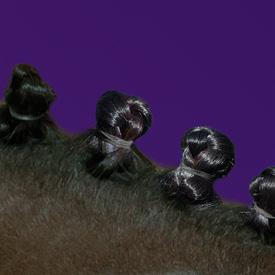
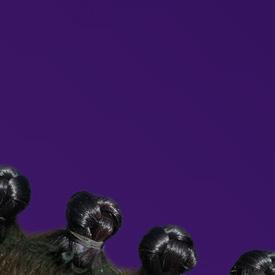


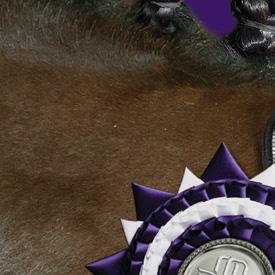
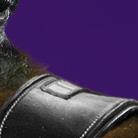
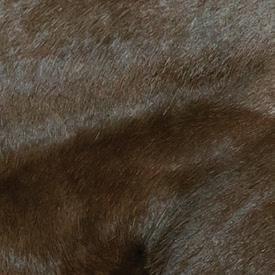

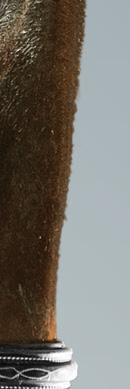
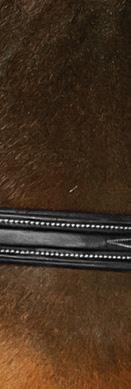
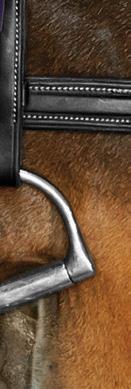
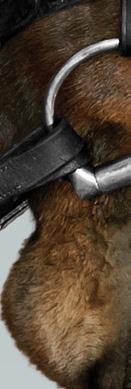

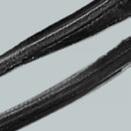

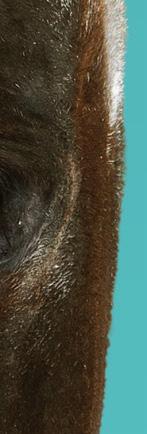


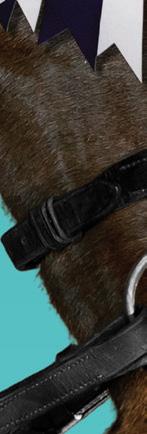






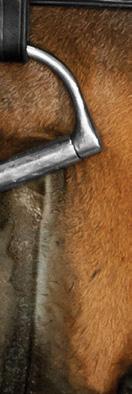




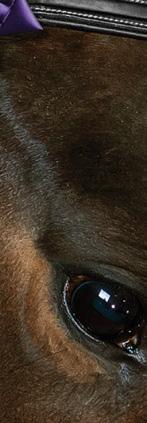
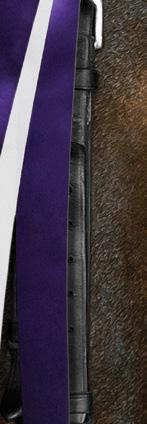
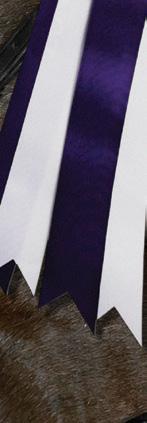


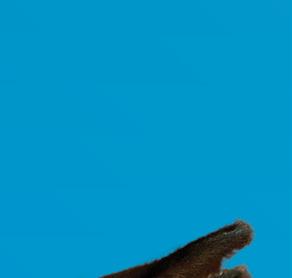

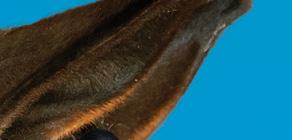



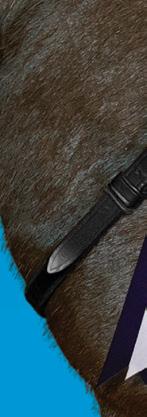













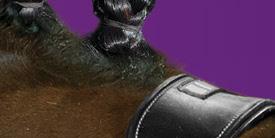




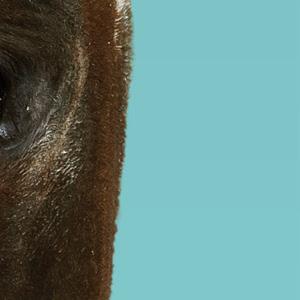


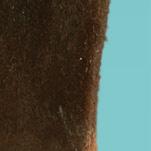



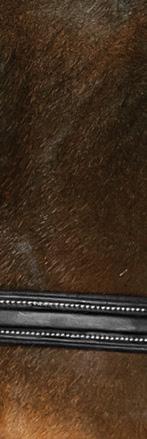

























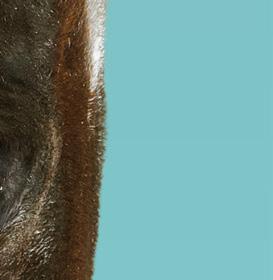
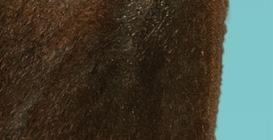







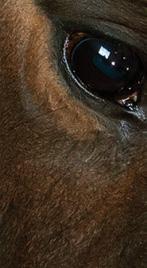





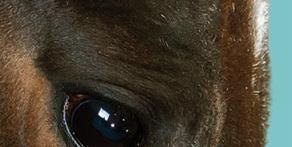

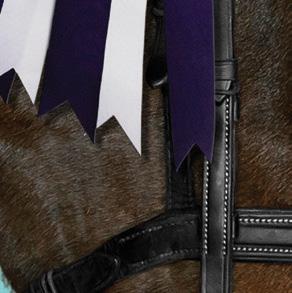

















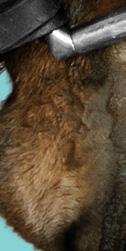


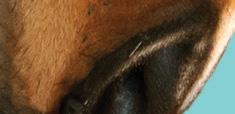



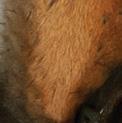


























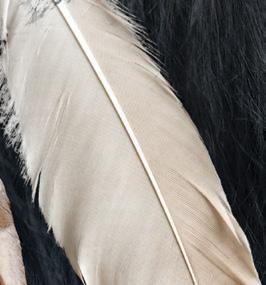








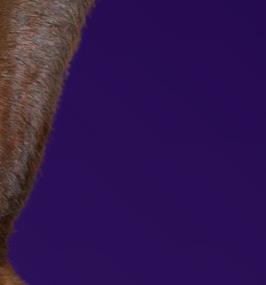

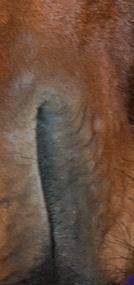











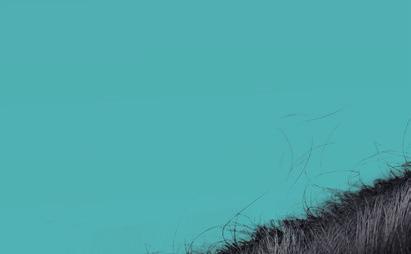




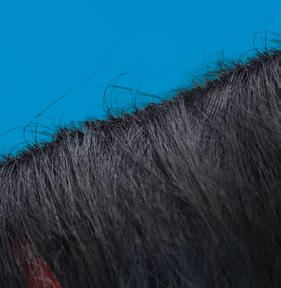


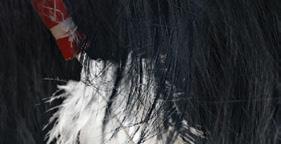










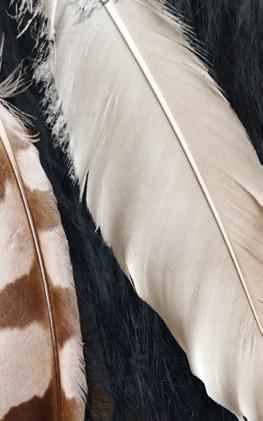


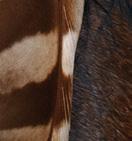














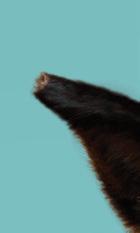


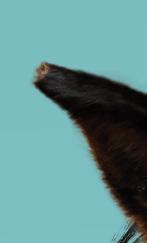










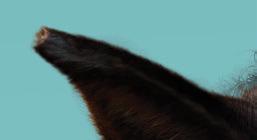





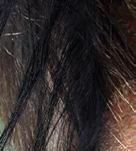


















FEATURING A GLIMPSE OF THE GREAT HORSE TRIBES OF THE PLAINS OUR HEARTS O UR HERITAGE APRIL 4-8 This event is designed in partnership with the Bluebird Cultural Initiative to celebrate the traditions and powerful history of the great horse tribes of the plains and honour their invaluable cultural heritage. OMAHA, NEBRASKA USA • CHI HEALTH CENTER TICKETS & TABLES AVAILABLE ON TICKETMASTER.COM • OMAHA2023.FEI.ORG
Introducing the 2023 Dressage Tests

The new USDF/USEF tests take effect December 1. Get the scoop on the changes from the horse’s mouth—the test writers themselves
By Gary Rockwell, Mike Osinski, Lilo Fore, Janet Foy, Kristi Wysocki, Nadine Schwartsman, and Janet “Dolly” Hannon Photographs by Jessica Farren Photography
Every four years, the USDF Test Writing Committee releases updates to the USDF and US Equestrian dressage tests (dressage-seat equitation, dressage sport-horse breeding, freestyle, and Introductory through Fourth Levels).
The Revision Process: An Overview
By Gary Rockwell
For more than a year before the USDF Test Writing Committee begins work on a new set of tests, we welcome suggestions from mem
sues regarding ridability, visibility for the judge (especially if there is only one judge at C), and time limits.
We also considered the move ments that we felt are not gener ally ridden well, and in some cases changed the test directives to clarify the intent.
This year, the “single loop” received a new description, and the test sheet will include a diagram. Because the single loop was often ridden as a sharp turn before the corner letter, it often appeared as a diagonal line. We now describe finishing the corner and then start ing a curved line, changing uniform bending at the quarter line.
In the review process, the Test Writing Committee also considers the progression of the tests and the current and proposed USEF and FEI dressage rules. Our goal is to de sign tests that give competitors the best opportunity to showcase their horses and their riding.
Equitation Updated
By Mike Osinski
Two years ago, USDF appointed a Dressage Seat Equitation (DSE) Task Force to review and update rules and patterns of the DSE tests. As a member of the task force, I served as the liaison to the USDF Test Writing Committee.
The current (2019) tests are in use through November 30, 2022, and the new 2023 tests take effect December 1, 2022. To explain what’s changed and why, six committee members each contributed a section on a specific topic.
bers, riders, trainers, and judges. We receive many ideas and review each of them. We also receive requests not to change some of the tests because the current ones ride very well.
Decisions to make changes to the 2019 tests generally resulted from is
One of the task force’s accom plishments was to come up with language clarifications that also re moved references to specific rules so as to avoid potential future confusion if rules are revised and renumbered.
The DSE test sheets were rede signed to include left and right cat egories as well as language changes that reflect the new test cycle.
28 November/December 2022 | USDF CONNECTION The Judge’s Box
HERE THEY ARE: The 2023 USEF/USDF dressage tests take effect December 1, 2022.
Pictured
are new-test demo pair Lindsay
Burgner on Midsummer NIght’s Dream.
We created new patterns for test ing competitors’ riding ability. These new patterns are designed to supple ment current existing patterns, which are still available for use, as well as a “judge’s choice” to make up unique patterns within standards.
Purpose of the Levels
By Lilo Fore
The Test Writing Committee made some changes to the “purpose of the level” text that appears on each USDF/USEF dressage test sheet.
Introductory Level. We revised the purpose of this level with the goal of making it friendlier and less intimidating to beginner riders and those starting out in dressage. We want to invite riders to join this sport, and we know how vital it is for new dressage riders to under stand the goals of this beginning level. Introductory Level is our basic level—but not less important!
The Intro Level purpose state ment now reads: to introduce the rider and/or horse to the sport of dressage, confirming that they are beginning to develop an understand ing of correct dressage basics. The horse should be ridden freely forward in a steady tempo and clear rhythm, accepting contact with the bit. An understanding of test accuracy and geometry should be demonstrated.
• Understanding the correct dressage basics is of foremost importance. Dressage can be a little intimidat ing, but please don’t be put off.
• At this level, riders should allow horses to move freely forward with a steady tempo and a clear rhythm. Regardless of the horse’s breed or type, dressage judges want to see a four-beat walk, a two-beat trot, and a three-beat canter. We want riders to know that this is more important than being fancy!

• Acceptance of contact with the rider’s hands is the start for the horse. Later on in the training we’ll want the horse to be truly on the bit, but at this point we would like to see the horse accept a connec
tion: confident enough to hold the bit in a steady way without feeling trapped and while being allowed to reach forward to the rein.
• Even in the beginning, horses and riders must learn about correct geometry and lines of travel. Every time the horse is allowed to drift or to wander about through the arena, the rider is giving up one of the most important training tools throughout all levels. The ben efit of paying attention to correct geometry is that you learn to guide your horse and to keep him be tween your leg and rein aids to the best of your ability. Doing so also improves the horse’s confidence because he doesn’t have to guess where you want to go next. Riding without secure, accurate geometry is like wandering through town without knowing the street names or your intended destination.
Training Level, judges expect more precisely ridden circles, transitions (including proper preparation), and other figures.
Training Level. As riders will notice, the correct basics are always mentioned and will never go away in any purpose of any level. The purpose statement now reads: to confirm that the horse demonstrates correct basics by showing suppleness both laterally and longitudinally, moving freely forward in a clear rhythm with a steady tempo and readily accepting contact with the bit. Correct geometry and lines of travel should be shown.
Let’s look at the key elements of this purpose statement in more detail.
• Correct geometry is stressed. At
Longitudinal suppleness is a new and important requirement. There is slightly different wording than the prior purpose of Train ing Level, but only because we want riders to pay attention to the importance of developing lateral and longitudinal suppleness. These will influence the quality of the free walk and the development of the correctly executed “stretchy circle.” First Level. There were a few significant changes to the wording of the purpose of this level, which now reads: to confirm that the horse dem onstrates correct basics and, in ad dition to the requirements of Train ing Level, has developed improved balance, lateral suppleness, and throughness, as well as the thrust to perform lengthenings of stride. The horse should be on the bit.
•
Key elements of this purpose statement are:
• Horses and riders must now show improved balance.
• The horse should show a slightly higher degree of lateral supple ness. First Level tests contain more complicated gymnastic exercises, which makes lateral suppleness more challenging.
• The word throughness is added to the the purpose of First Level. Throughness will be from this level on a very important part of the training, as it influences the quality of the transitions within and between gaits.
• The purpose now also states that the horse should demonstrate the thrust to perform lengthen ing of strides, to indicate that the thrust needed to perform these forward-going transitions is a part of throughness.
• One very important new clarifi cation is that judges now expect the horse to be on the bit, not just accepting of the bit. The horse should become more confirmed
USDF CONNECTION | November/December 2022 29
PONY POWER: Charlotte Green and the Welsh cross Comanche focus during their Intro B demo test
The Judge’s Box
in the connection from hind quarters to front.
Second Level. Second Level in troduces collected and medium gaits. The purpose statement now reads: to confirm that the horse demonstrates correct basics and now begins to ac cept more weight on the hindquarters as the collected and medium gaits develop. A greater degree of straight ness, throughness, and balance are required to perform the movements with ease and self-carriage.
• More weight must be distributed onto the horse’s hindquarters as the collected and medium gaits develop. If the hindquarters do not become more weight-bearing, the horse’s forehand and shoulders are without the needed support system to manage the increased difficul ties of this level.
• The Second Level horse should demonstrate a greater degree of straightness, suppleness, and throughness. In addition, the bal ance needed for the more difficult exercises of this level must improve in order to enable the horse to perform with ease and to show the development of self-carriage.
Third Level. The new purpose is to confirm that the horse demonstrates correct basics while maintaining consistent uphill balance and self-car riage. Increased engagement facilitates clear differences in collected, medium, and extended gaits with well-defined, balanced transitions. Movements should be accomplished with harmony and ease due to the increased balance and collection. The horse must demon strate a greater degree of throughness, suppleness, straightness, and bending.
• The development of uphill balance and self-carriage is stressed.
• Increased engagement facilitates clear differences among collected, medium, and extended gaits, coupled with well-defined transi tions.
• The rider’s skills must also con tinue to develop. The rider must be sufficiently competent and sit sufficiently well to enable the horse
to develop increased impulsion. Without impulsion, there cannot be increased engagement.
• Lateral and longitudinal supple ness must now become more confirmed.
• A higher degree of throughness must be achieved.
• Movement then can then be ac complished with harmony and ease due to the increased balance and collection. Fourth Level. The purpose statement for this level now reads: to confirm that the horse demonstrates correct basics and has developed suffi cient throughness, suppleness, balance, and impulsion to perform with ease the exercises at this medium level of difficulty. The horse has established consistent self-carriage and lightness through improved connection, engage ment, and collection. The movements and transitions are performed with greater straightness, impulsion, and cadence.
• Throughness. The horse should demonstrate the combination of suppleness, balance, and impul sion needed to perform the exer cises with ease.
• Adjustability between and within gaits should be more confirmed. This includes being able to execute transitions with subtle aids.
• More complicated lateral move ments are now required, so the rider should be able to demon strate a greater degree of supple ness without losing balance.
• Increased impulsion is needed to develop greater engagement, col lection, self-carriage, and lightness through the improved connection. Also, the development of cadence is now possible as all the above requirements are being developed.

Overview of the Test Changes: Four-Year-Old Through Third Level
By Janet Foy
Here is a summary of what’s changed in the actual test patterns
themselves for the 2023 test cycle. I’ll focus on the USEF Four-YearOld through Third Level tests.
Four-Year-Old. The trot work stays the same. A longer line (now H-P) has been added for the free walk, and there is less medium walk. This longer line will allow horses more time to relax. This also flops the canter patterns. The canter departs are now between letters (A and K; A and F), and the stretching circle is on the left rein due to the canter work’s being reversed.
Developing Prix St. Georges. No changes.
Developing Grand Prix. No changes to the test pattern. There are, however, now two collective marks:
1. Implementation of General Principles (freedom and regular ity of the gaits; engagement of the hindquarters; elasticity of the steps; suppleness of the back; straightness; acceptance of the bridle; self-car riage)
2. Harmony of Presentation (at tention and confidence of the horse; harmony in the presentation of the rider/horse combination; rider’s position and seat; discreet and effec tive influence of the aids).
Training Level. Test 1: The transition to medium walk (move ment 6) is now between letters so it is more gradual.
Test 2: No changes.
30 November/December 2022 | USDF CONNECTION
DEVELOPING PRIX ST. GEORGES: Amanda Olson rides Seraphims (St. Moritz Junior x Sir Donnerhall I)
SHALLOW LOOP: This friendlier figure has replaced the three-loop width-of-arena serpentine in Training Level Test 3. Pictured are Training 3 demo pair Claire Darnell and the KWPN gelding Matthew S (Geniaal x Fidermark).
Test 3: The serpentines, width of the arena, have been removed and the shallow loops have been restored (H-X-K and M-X-F). This will be more inviting and easier for horses at this level.
First Level. Test 1: Canter lengthenings have been removed, as we felt that it is too early for the horse to show clear transitions.
Test 2: Prior to the leg-yields, the horse will now turn up center line rather than using the half-circles. This will give the horse and rider a bit more time to prepare for the leg-yields.
Test 3: The movements remain the same; however, the order of gaits is now trot, canter, walk, trot, canter. The committee felt that the canter work in the previous Test 3 was too long and required too much strength for a horse at this stage of training. With Second Level and collection coming up, we did not want horses to learn to run through the canter work.
Second Level. Test 1: This test has been shortened at the end with the removal of the last can ter depart. Both canter leads have already been shown from the walk, so this was unnecessary. The trot is at the same place (at P), but the last medium will be from K to R.
Test 2: The medium trot has been put before the lateral work to help get the horse thinking forward.
The shoulder-in pattern follows. The rein back has been removed. The rest of the test is unchanged.
Test 3: No changes.
Third Level. There were no changes to these tests, except that all flying changes now have double coefficients. The committee liked how the tests were being ridden and judged and had no suggestions for improvement.
Changes to the Fourth Level Tests and the DSHB Score Sheets
By Kristi Wysocki
Fourth Level Test 1: The shoulderin was moved from the center line to the rail to make it a little less challenging. Now that the degree of difficulty of these shoulder-ins has been reduced, the double coefficient is shifted to the trot half-passes instead.
Test 2: The extended canter is now placed before the working pirouettes to help the rider create more activity in preparation for the pirouettes. The trot half-passes no longer have double coefficients, but the canter half-passes now have double coefficients.
especially the canter tour. The major change is the removal of the canter half-circles in true and countercanter. The canter tour is now somewhat similar to that in Third Level Test 3. The canter half-pass is ridden to the center line, fol lowed by a diagonal line. The canter half-pirouette is then asked for on that diagonal line. This more “open” line for the canter half-pirouette is designed to help the horse have an easier time in executing the move ment with ease.
In the trot, the shoulder-ins have been moved to the rail (they were previously on the center line), and they are no longer double coeffi cients. Be aware that the transitions into and out of the extended trot are now double-coefficient movements. This change was made to make rid ers more aware of the importance of these transitions.
Dressage Sport Horse score sheets. A significant modification was made to the Materiale score sheet, with the directives being revised to better clarify what is and is not allowed. The judge is allowed to ask for basic gaits only, not for any movements (stretch circles, legyield, lateral work, halts, and so on). Lengthenings at the trot and canter are allowed only with four- and five-year-olds. If a three-year-old is in the same class as four- and fiveyear-olds, then lengthenings are not allowed.
REDESIGNED TEST: Fourth Level Test 3 should now be more user-friendly, with changes including canter half-pass to the center line, followed by a diagonal line with a half-pirouette. Jessica Wisdom rides the Dutch Warmblood Falcon (UB40 x Flemmingh).
Test 3 has been modified signifi cantly to make it more user-friendly for both horse and rider. It is much shorter than the previous version,
An explanation about dividing large classes has also been added. Prior to the class, show manage ment should divide classes with 12 or more horses into groups. Man agement can assign times for each group to enter the ring. Horses are judged in groups of six or fewer at a time. The entire class is then placed as a whole. No more than six horses at a time should be allowed to canter at the same time.
The Dressage Sport Horse Pros pect score sheet was modified to include a Four-Year-Old Prospects division for four-year-old mares,


USDF CONNECTION | November/December 2022 31
The Judge’s Box
geldings, and stallions. We added this newer division to give four-yearolds the opportunity to compete as dressage sport-horse prospects in addition to four-year-old mares and stallions competing as breed ing stock. The Dressage Sport Horse Four-Year-Old Prospect division classes must be judged using the DSHB Sport Horse Prospect score sheet. Note that four-year-old mares and stallions may compete in either or both of these divisions.
Making the Dressage Tests More Horse- and Rider-Friendly
 By Nadine Schwartsman
By Nadine Schwartsman
Three years ago, when Gary Rock well asked me if I would be interest ed in joining the USDF Test Writing Committee, I accepted enthusiasti cally. I have loved dressage tests ever since I was a little girl riding in Germany, and the opportunity to be involved in writing them was incred ibly exciting to me.
I have ridden every test from Training Level to Grand Prix on multiple horses and also have clients competing at all levels. My primary goal as a committee member was to make the 2023 tests as horse- and rider-friendly as possible. Here are a few of my thoughts on the changes at each level.
and H, rather than at C. It’s a small change, but it’s one that I believe will give riders more time to prepare a smoother transition, especially on greener horses.
Test 2 remains unchanged. In the past this test has been criticized as being too long, but as a rider of young horses I have always appreci ated this test. It flows well and gives me more time in the show ring with less-experienced horses to build their trust and confidence.
You will see the biggest changes at this level in Test 3. The threeloop serpentine has been replaced with a single loop, which allows the horse to remain in better balance while still showing changes of bend. In the 2019 version of the test, the transitions from working canter to working trot to medium walk came up quite quickly, often resulting in unbalanced transitions. This issue has been addressed by placing the transition from working canter to working trot on the H-X-F diagonal at X, followed by the medium-walk transition at A. This new sequence will also prepare horses and riders for some of the movements in First Level, such as the change of lead through trot on the diagonal. The new diagram of the shallow loop on the score sheet is a great added visual resource.
First Level. The lengthening of stride in canter has been removed from Test 1. This gives horses and riders the opportunity to develop a more balanced canter in the 15-me ter circles of Test 1 before demon strating the lengthening of stride in Tests 2 and 3, thus allowing for a more gradual increase in difficulty throughout the level.
fluid finish. The canter down the long side to the trot transition at E in the 2019 version was lengthy and not necessary in a Second Level test.
Test 2 received the most changes at this level. Medium trots before each set of lateral work allow the horse to gain impulsion before he is asked to demonstrate collection. In the 2019 version, all lateral work was done consecutively after the ini tial center line. This was too much collection without the ability to go forward in between, and it often resulted in labored lateral work. The medium trot on the last center line has also been removed, making for a less-overwhelming test.
Test 3 remains unchanged. It’s a lovely, balanced test with good flow and symmetry.
In Second Level as well as Third, the direction to “shorten stride in walk” before the canter transitions has been removed, and before the turn on the haunches it has been replaced with “collect.” As a trainer, I’m always striving to preserve the purity of the walk. I believe that these changes are a great step in the right direction. Now riders can focus on preparing for the transition or for the turn on the haunches instead of on shortening the walk.
Third Level. Not much changed at Third Level in this test cycle. The most notable difference is that the flying changes now have a coefficient of 2 starting with Test 1. As a rider and trainer, I appreciate that this brings focus to the flying changes, which are an integral part of Third Level and a necessary stepping stone to moving up the levels successfully.
LAYING THE FOUNDATION: Training Level remains the bedrock of correct gymnastic development. Pictured are demo pair Lindsay Burgner on Midsummer Night’s Dream.
Training Level. In Test 1 the transition from working trot to medium walk is now between C
In Test 3, the canter work has been divided for better balance, as the previous canter tour was quite long. Both leg-yields are now ridden toward the judge at C, which enables the judge to better assess the con nection and flexion.
Second Level. In Test 1, the end was shortened to allow for a more
Fourth Level. This saw the most changes of any level. Our goals were to make Fourth Level more attractive to riders and to increase test utilization. Fourth Level is an important bridge between Third Level and Prix St. Georges. I hope that the new tests will encourage combinations that confirm the skills needed to move up to the FEI levels successfully.
32 November/December 2022 | USDF CONNECTION
Test 1 has always been a favor ite of mine. Small changes, such as moving the shoulder-in from the center line to the long side, were done with the intention of allowing for better balance in the shoulder-in along the rail.
In Test 2, the extended canter has been placed before the can ter working pirouettes. With this change, the horse/rider combination can gain more impulsion and activ ity in preparation for the collection required in the working pirouettes.
Test 3 has been completely rewritten. The most notable change is the removal of the half 10-meter circles at canter and counter-canter, which I never found particularly pleasant to ride or helpful in my training. They have been replaced with a fluid pattern of a half-pass to the center line, a half 10-meter circle after 12 meters of straightness, to a diagonal on which a half working pirouette in canter is ridden. I find this pattern quite inviting to the de veloping horse, who is still learning to maintain balance in these move ments.
The shoulder-in has also been moved to the rail in this test. This makes the tests more consistent with the requirements of the Prix St. Georges, as now the first shoulder-in on the center line will be required in the Intermediate I.
HELPING THE YOUNGSTERS: The first canter transition in the USEF Four-Year-Old test will now be performed between letters, which should bolster young horses’ confidence. Rachel Marie demonstrates the Four-Year-Old test aboard the Oldenburg mare Debutante (Benidetto x Don Frederico).

Bringng the New Tests to Life
Special thanks to Donida Farm, Au burn, Washington, for the use of its beauti ful facility to film the new 2023 dressage tests; to on-site organizer Gwen Blake and off-site organiz er Janet Foy; and to our film narrators and techni cal experts, FEI 3* judge Kari McClain and FEI 4* judge Mike Osinski.
We couldn’t have done it without the following talented demonstration riders and horses. Thank you for lending USDF your time and talents over two scorching-hot days in July 2022!
CALLING ALL BREEDS: The USDF film and photo shoot featured a wide array of breeds and types. Pictured are Training Level demo pair Michelle Newman and the Friesian/Gypsy Vanner cross Spott On.

Gwen Blake and the Hanoverian Enigma (Scudaria x Furstin de Charry)
Lindsay Burgner and the pony Midsummer Night’s Dream (by Fürst Class)
Claire Darnell and two mounts: the KWPN Matthew S (Geniaal x Fider mark) and Harrold S (Vivaldi x Fidermark)
Nina Diaz and the Lusitano/Dutch Warmblood cross Fahdi DE C Charlotte Green and the Welsh cross Comanche Carrie Gregory and the Hanoverian Hummer Thyme (by Sir Gasperon)
Dannelle Haugen and the Arabian HM Nahar ++++// (by Akma D Day+++/)
Tabitha Hopp and the half-Arabian Diamond Bey (Diamondhead x Win chester Bey)
Teresa Leahy and the Dutch Warmblood Dominique (by Sandreo)
Rachel Marie and four mounts: the Oldenburg Debutante (Benidetto x Don Frederico), the Arabian/Hanoverian cross Serena M, the Oldenburg First Dibs (by Fürstenball), and the German Riding Pony Hermes (North Forks Cardi x HS Wistar)
Lucy Matulich and the Oldenburg mare Sophera CR (by Sempatico)
Kristin Miller and the Norwegian Fjord Bergen Saundra (by Heljos Solar)
Christine Murray and the Oldenburg Incandescent (Danciano x Sem patico M)
Michelle Newman and the Friesian/Gypsy Vanner cross Spott On (Ga briel x Gries Tjeerd)
Sophia Nimon and the Lipizzaner Maestoso II Gabriola (by Maestoso II Ambrosia)
Amanda Olson and the Hanoverian Seraphims (St. Moritz Junior x Sir Donnerhall I)
Sarah Cohen Steadman and the Oldenburg First Romance (Fürst Ro mancier x First Class)
Jessica Wisdom and the Dutch Warmblood Falcon (UB40 x Flemmingh).
USDF CONNECTION | November/December 2022 33
The Judge’s
Young Horse and Developing Tests. As somebody who shows a lot of young horses every year, the revision that I am most excited about is the seemingly minor change of the first canter transition in the USEF Four-Year-Old test from at the letter to between two letters. This will allow us to better prepare and support our young horses, preventing tension and mistakes that can compromise a youngster’s confidence in the ring. I also really appreciate the longer free walk, which allows for optimal space to present the young horse’s walk.
There are no changes to the Devel oping tests except that the collective marks were updated to match the FEI tests’ new collectives. The collective marks going forward will now be the
implementation of general principles and harmony of presentation. I be lieve that emphasizing the importance of harmony can only be a win/win for both horses and riders.
Gary Rockwell, chair of the USDF Judges Committee and the USDF Test Writing Committee, is a USEF “S” judge and a retired FEI 5* judge from Wellington, Florida. Equita tion is one of the judging special
ties of FEI 4* judge Mike Osinski, Lacey, Washington. USEF “S” judge Lilo Fore is a retired FEI 5* judge and a longtime USDF Instructor/ Trainer Committee co-chair from Santa Rosa, California. Janet Foy, of Colorado Springs, Colorado, is an FEI 5* dressage and young-horse judge. Kristi Wysocki is an FEI 4* dressage and young-horse judge, USEF sport-horse judge, and long time USDF Sport Horse Committee chair from Coupeville, Washington. Nadine Schwartsman is a USDF bronze, silver, and gold medalist and an FEI-level trainer/competitor from Eagle, Idaho. Janet “Dolly” Hannon, of Arvada, Colorado, is a USEF “S” judge and chair of the USDF Free style Committee.
Changes to the USDF Freestyle Score Sheets
By Janet “Dolly” Hannon
TheUSDF Test Writing Working Group, with input from the USDF Freestyle Committee, has made some major changes to the USDF freestyle score sheets for the 2023 test cycle.
The main changes are to the artistic marks and their coefficients. These are now more in line with the FEI artistic marks: with the mark for rhythm, energy, and elasticity (REE) moved from the technical side of the score sheet to the artistic side.
With a few exceptions for degree of difficulty, all artistic marks now carry a coefficient of 4 for REE, choreography, and degree of difficulty (which varies according to the level).
At all levels, the music score now has a coefficient
of 2, as does the interpretation score. This is a reduc tion from previous test cycles.
The chart below shows the coefficients for the artistic marks.
Coefficients have been added to most walk scores, and more coefficients have been added to key move ments at the various levels. Be sure to look at the score sheets to see where coefficients have been add ed, as these have an impact on the technical marks.
In addition, competitors and choreographers should review the bottom of the score sheet to see what ele ments are “clearly forbidden” (usually anything from a higher level, including transitions) and what elements are considered “additionally allowed movements or transitions.” This information is critical in ensuring that your freestyle stays within the rules and guidelines.
34 November/December 2022 | USDF CONNECTION
Collective Mark Training Level First Level Second Level Third Level Fourth Level Rhythm, Energy, & Elasticity 4 4 4 4 4 Harmony 4 4 4 4 4 Choreography 4 4 4 4 4 Degree of Difficulty 1 2 3 4 4 Music 2 2 2 2 2 Interpretation 2 2 2 2 2 New Freestyle Coefficients for Artistic Collective Marks
Box
Here to
Have you set your dressage goals, made a plan, but need financial help?

Thanks to many generous donors, financial support may be available for your dressage education. Grants are available for:

Adult Amateurs Youth Instructors Judges FEI Riders Western Dressage Riders Breeders Show Management Technical Delegates USDF GMOs Nonprofit Groups And More!
Visit www.dressagefoundation.org or call (402) 434-8585 for grant information and to make a donation to help the sport you love!
Grant Recipient Leah Majkrzak By Red Pony Photography
Help

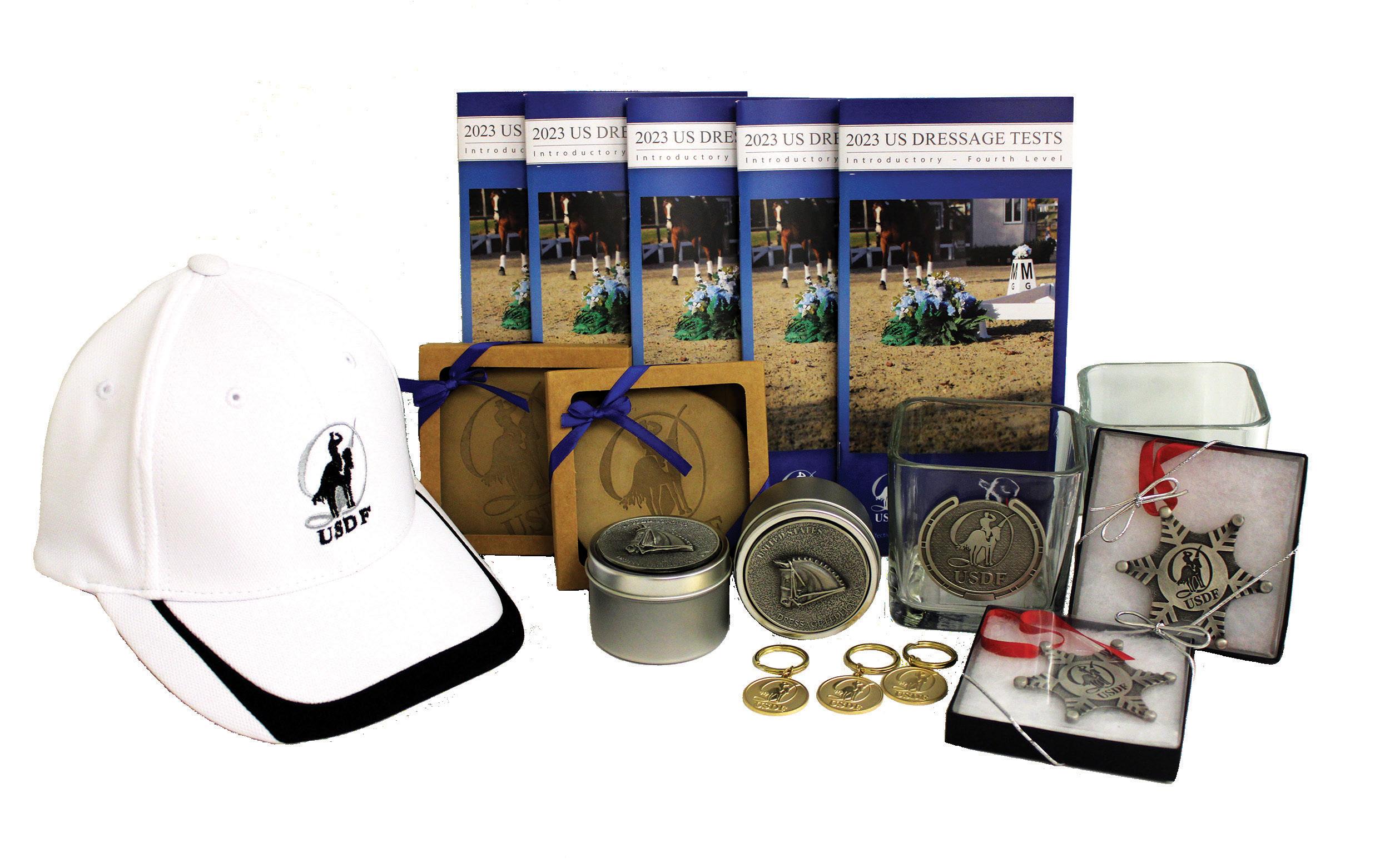
FOR THOSE FON OR THOSE ON USDF Coaster Set –$14.95 www.usdf.org/store order online at USDF Baseball Cap –$19.95 Horse Head Trinket Tin –$29.95 Holiday must-haves from USDF!


THE “NICE” TLIST HE “NICE” LIST Snowflake Holiday Ornament –$19.95 USDF Vase –$29.95 www.usdf.org/store order online at 2023 US Dressage Test Booklet –$9.95 USDF Keytag – $4.95
A Force of Nature
For more than 50 years, Janine W. Malone has worked to create a better future for the sport she loves
By Jennifer M. Keeler
Theresimply are not many people who have given more to the sport of dressage than her.”
That’s how USDF president George Williams describes his longtime friend and colleague Janine W. Malone, whom he first met more than 30 years ago when he was asked to join what was then known as the American Horse Shows Association (AHSA) Dressage Committee.
and I have the deepest respect and admiration for her.”
Over more than six decades of involvement in equestrian sport, Malone, of Zebulon, North Caro lina, has embraced so many roles it’s almost impossible to list them all. To many, she’s the undisputed dres sage “rules queen” with an unrivaled store of historical knowledge, atten tion to detail, and an innate under standing of how seemingly minor
sylvania). Malone is also a highly respected sport-horse breeder, US Equestrian (USEF) judge, USEF dressage technical delegate, and FEI steward. She’s been a champion and leader for horse sports in scores of volunteer roles, including longtime tenures as USDF Region 1 director and USDF secretary; a USEF Board of Directors member; and a mem ber or chair of a multitude of FEI, USEF, and USDF committees, task forces, and working groups.
In recognition of her tireless efforts and contributions, Malone received the USDF Lifetime Achievement Award in 2014 and in 1998 was the inaugural recipient of the USDF Volunteer of the Year award. USEF recognized her with its Sallie Busch Wheeler Trophy for distinguished service to the equine industry. She has also received the US Hunter Jumper Association President’s Distinguished Achieve ment Award.

What would motivate someone to dedicate so much of her life to a sport she loves? For Malone, it comes down to two words: Pony Club.
Equestrian Opportunity
“She had such wonderful in sights, a wealth of knowledge on many topics, and gave me great advice,” Williams says. “Having sat on many committees with her since then, I am of the opinion that Janine would have been brilliant at any thing she put her mind to. We are lucky that one of her primary inter ests was—and and still is—dressage,
rule changes can have a major and sometimes unexpected impact on dressage competitions.
But Malone is so much more. She’s been a driving force behind popular dressage shows such as the CDI Raleigh in North Carolina, an event she organized for almost 20 years, as well as the US Dressage Fi nals and Dressage at Devon (Penn
As a girl, Malone and her sister roamed the mountains and valleys of western North Carolina aboard their first ponies, Scamper and Shadow. When they began taking lessons over the summer at a local riding club and Malone wanted to start jumping, her father bought her first “English” saddle: a thickflapped $50 Argentinian model from a tack shop in Asheville.
“With that saddle, I learned to jump properly, and from there we upgraded to horses and became in
BOB TARR
38 November/December 2022 | USDF CONNECTION
Salute
DOUBLE LEGACY: Janine Malone (left) was instrumental in creating the US Dressage Finals national-championship competition. She also donated the Janine Westmoreland Malone
Perpetual Trophy, awarded to the Finals’ Prix St. Georges Adult Amateur champion. She’s pictured with USDF executive director Stephan Hienzsch and USDF president George Williams at the trophy’s unveiling at the 2015 US Dressage Finals.
BRYANT; COURTESY OF JANINE MALONE; SUSAN SEXTON
volved in Pony Club, which is where I first learned about dressage,” Malone says. “You have to remember that the sport of dressage was pretty rudimentary in this country at that time; but interestingly, I remem ber I took my ‘B’ Pony Club rating under [the late Roemer Foundation/ USDF Hall of Fame member and respected dressage judge] General Jonathan Burton. I enjoyed jump ing and even won a Maclay class as a teenager, but as time went on I became increasingly involved in dressage. I loved the detail of it and the methodical process of training. I think it fit my mindset and was just more interesting to me.”
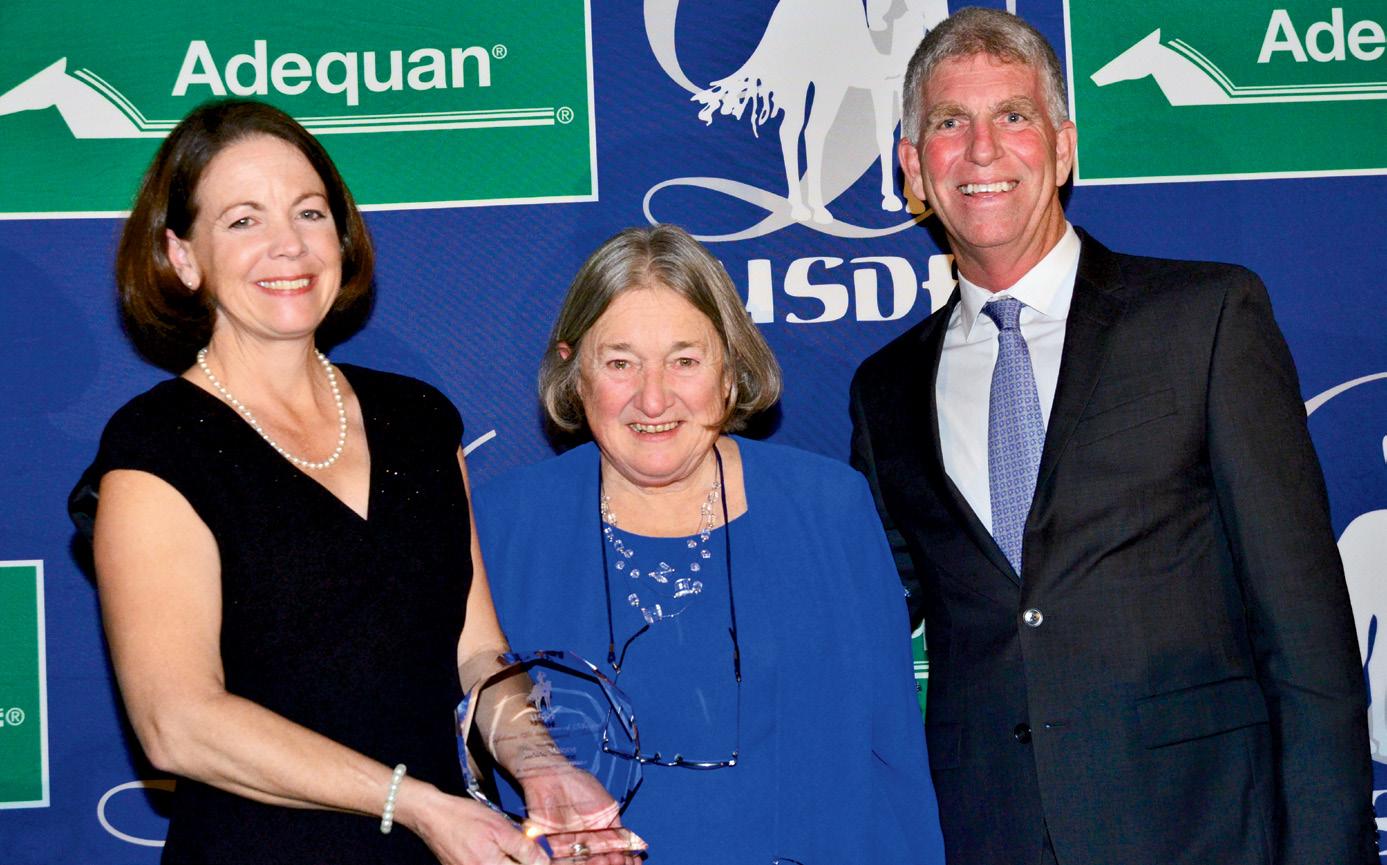
Malone became heavily involved in Pony Club, first as a rider and later as a volunteer, trainer, and coach, all the way up to the national level. She says her achievements were secondary to the chief lesson Pony Club imparted: the importance of giving back and volunteering.
She herself got a life-altering leg up from the local equestrian com munity.
“Back in the 1960s, there were some people in the Asheville area who were very generous in their sup port of local young equestrians like me,” Malone says. “I was just a poor kid from the mountains, and they
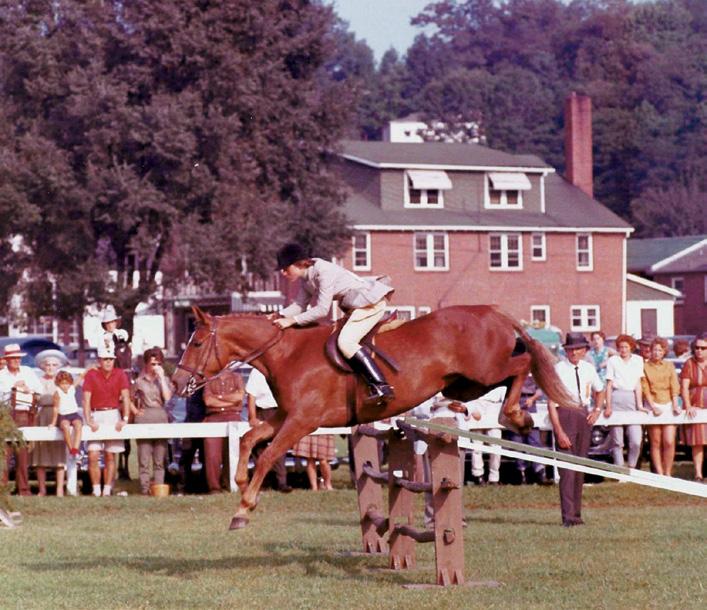
may have felt a little sorry for me at Pony Club camps, but it’s because of those opportunities they gave us that I’m where I am today, and I never forgot it. I didn’t grow up with the social advantages that others were lucky to have, but I worked hard. After I got my ‘A’ rating and started teaching, it was important to me to continue to be involved and bring on the next generation and make sure others received opportu nities like I did. Volunteerism is a mindset, and even more than that, it became a way of life for me.”
Young Equestrian Professional
After college and marrying her husband, the late John Malone, in 1969, Malone and her family settled on 57 acres in Zebulon that they christened Rosinburg Farm. Malone rode, competed, and also taught local equestrians. She also ventured into sport-horse breeding, focusing on Hanoverians, and showed a few of her talented youngsters. She also started managing local horse shows.
“When you’re young, you have plenty of energy and can do all of these things!” Malone says with a laugh. “Back then, running horse shows wasn’t a business like it often is now. Most shows benefited either the community or a specific charity
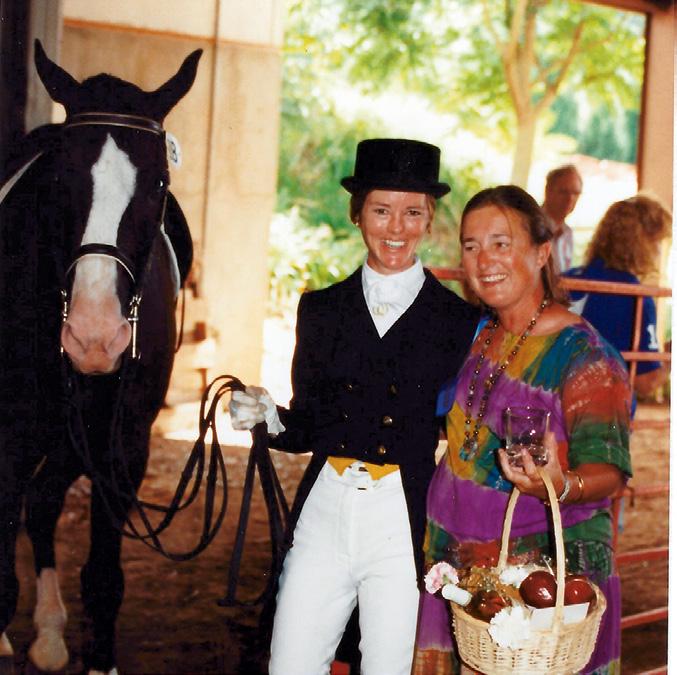
and were run by a committee with volunteer staff, and they always needed help. It was through running horse shows that I became passion ate about rules, because I always wanted to make sure my events were run correctly.”
With dressage still a burgeon ing sport in this country, Malone literally had to go the extra mile to pursue her own goals in the saddle. “I would trailer nine hours one way to Atlanta to train with Elizabeth Lewis, who was the very first USDF gold medalist,” she says. “I was will ing to work as hard as I needed to learn more, but there just weren’t the opportunities and relatively easy access to good coaching or even competition that we often take for granted today. For instance, if you go to a show today, it’s not uncommon for the small tour to be the largest
USDF CONNECTION | November/December 2022 39 JENNIFER
WELL-DESERVED: Receiving the USDF Lifetime Achievement Award in 2014 from then USDF Historical Recognition Committee chair Anne Moss and USDF president George Williams
PONY CLUB DAYS: Jumping Sugar and Spice in a Labor Day show in Canton, North Carolina, around 1962
HELPING HANDS: With trainer Elizabeth Lewis (left) at the 1992 CDI Raleigh
division. But when I started out, just having an FEI ride at a show was an anomaly. I never even saw a Grand Prix ride until the mid-1970s, and I was fascinated.”
One of Malone’s fondest memo ries from that era was a trip to the US Equestrian Team headquarters in Gladstone, New Jersey, where Lewis was trying out for the US dressage team for the 1976 Montreal Olympics.
“Elizabeth needed a groom, so I loaded up my own horse and went with her to Gladstone for a few weeks for training with [then-US dressage team coach the late] Col. Bengt Ljungquist,” Malone recalls. “I wasn’t paid; I just wanted to observe and learn, and we all stayed in the dorms there. That’s where I met [future 1976 US Olympic dres sage team bronze medalist] Hilda Gurney, who drove herself all the way across the country from Cali fornia with two horses, one of which was [her Olympic mount] Keen. I even got a couple of lessons while I was there with both Hilda and Col. Ljungquist, both of whom were incredibly generous, and it was an unforgettable experience.”
Raising the Competition Bar
Another pivotal trip with Lewis that year would also leave a lasting impression.
“The first CDI I ever attended was in York, Pennsylvania, in
1976, and we also went to Devon. They were two of the first CDIs in the country, and I was intrigued,” Malone says. “I was already running some horse shows by that time, and I decided that I wanted to hold a CDI closer to home in Raleigh.”
The CDI Raleigh became a fix ture on the Eastern dressage circuit for years.
“We didn’t have the fanciest facil ity there at the state fairgrounds,” Malone says, “but it ended up being very popular because people could count on it to be well run. We of fered quite a bit of prize money for the time, and it turned into both a national and World Cup qualifier. I managed it for almost 20 years, but it took so many hours to run because things weren’t done as ef ficiently as now: For so many years we didn’t have computer software, so everything was done by hand. But that also is how I got connected and became friends with [the late] Patsy Albers when she was my show secretary, and in turn I became her assistant for Devon.”
As Malone’s volunteer roles grew, she decided to hang up her own tack.
“I always knew I wanted to be involved in equestrian sport at the top level. I knew where my talents were, and they weren’t necessarily in the saddle,” she laughs. “After I had my two children, my riding slowed down and finally stopped. Time constraints just made it too hard to keep up to the standard I expected of myself.”
Malone threw herself further into her work as a competition offi cial. She was part of the very first “r” dressage judges’ training program in 1975, run by the AHSA (now US Equestrian, or USEF). USEF “R” judges’ licenses in both dressage and dressage sport-horse breeding followed, as did licenses as a USEF dressage technical delegate and an FEI steward.
Involvement in sport governance was her next foray, as Malone began

serving on numerous USDF com mittees. When the late US dressage judge Edgar Hotz asked her to join the AHSA Dressage Committee, she immediately began working on rules, an area that would become her passion.
“I have 25 years of rules archived on my computer, and of course I have many more than that because we weren’t doing things on the computer before the 1990s,” Malone chuckles.
Bettering the Sport
From freestyles to Regional Cham pionships, competition management to continuing education, over the last 40-plus years Malone has served on local, regional, and national committees addressing almost every aspect of dressage.
“The sport is so much more de tailed now, and I’m so pleased to see how the number of opportunities and programs available has grown throughout the years,” Malone says. “Young-horse programs, dressage equitation, so many championship programs—none of these existed just 20 years ago.”
One of those opportunities is not only the legacy project Malone is most proud of, but also one of the toughest battles she’s waged: the US Dressage Finals.
“I can’t even remember the years and years that I spent advocating for a USDF national champion ship, which is now known as the US Dressage Finals,” Malone says. “So many people said it couldn’t or shouldn’t be done, but from the very beginning I believed in the concept and felt that I just had to convince enough people.
“Through all the years, all the meetings, all the feasibility studies, I never lost faith,” she continues.
“Other breeds and disciplines had big national-championship events and made them work, so I knew that it could be successful for dressage, as well; we just needed to wait for the right time. So when it finally
40 November/December 2022 | USDF CONNECTION USDF ARCHIVE
GETTING INTO GOVERNANCE: Malone (left) as North Carolina DCTA president in 1976
Salute
FIXTURE: USDF conventions wouldn’t seem complete without Malone (pictured in Denver 2008)
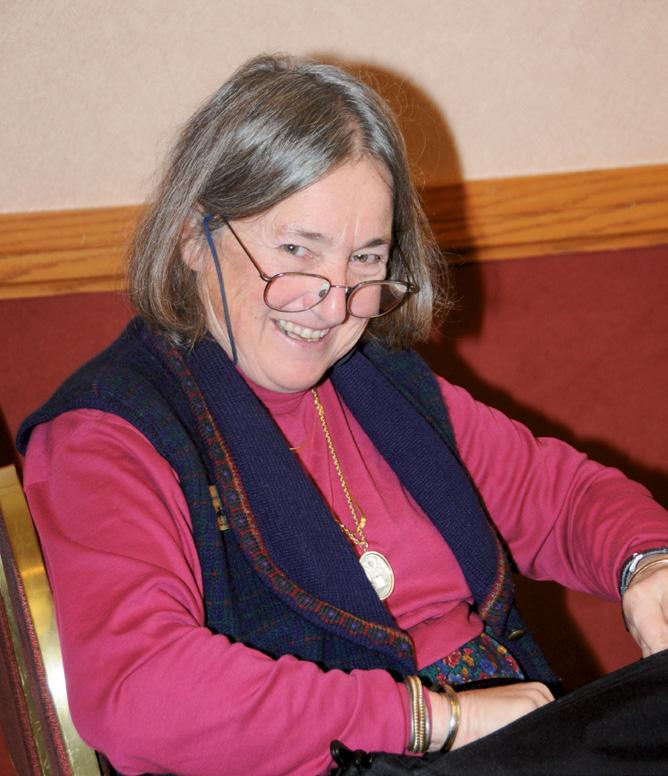
happened in 2013, even though it was a whole new world and a big learning curve for everyone, it was such a success right out of the gate. Of course I was incredibly proud to be a part of it as chair of the original organizing committee, and then to manage it for several years. Now I think it’s proven itself to be incred ibly successful and has quickly become a flagship event for USDF.”
Not Done Yet
Even as she turns 75 this year, Malone shows little sign of slowing down. She continues to run several local dressage shows under the banner of her show-management company, Rosinburg Events. She still travels to officiate and to teach dressage lessons, manages her farm, and spends time with family, including sons Sam and Ben and her beloved Jack Russell terrier, Zeb. And she’s as busy as ever with highprofile volunteer commitments: chairing the USEF Competition Management Committee, the USEF Dressage Rules Working Group, and the USDF Regional Champion ships Committee; and serving on the USEF Legislative and Hearing Committees, the USDF Sport Horse Committee, the USDF Rules Advi sory Working Group, and several ad hoc committees.
“I have loved working with so many incredible people through the years on various committees, be cause even when we disagree, we’re all working to improve the sport,” Malone says. “I have always firmly believed that equestrian sport has to be inclusive, not exclusive.”
She hearkens back to that time when someone helped her get one step closer to her own equestrian dreams.
“You never know: When you give a kid a chance to go out and win a little walk-trot blue ribbon, that may not seem like a big deal at the time but actually serves as a pivotal moment for that child, who goes on to be tomorrow’s Olympic champion or the next leader in the sport. You never know when one small mo ment can change someone’s life— and I know, because I was that kid. If it wasn’t for some very generous people who recognized how hard I was willing to work to succeed, I wouldn’t be here today.”
A lifelong equestrian and fan of horse sport, Jennifer M. Keeler is a freelance writer and the owner of Yellow Horse Marketing in Lexington, Kentucky.
IN THE NEXT ISSUE
• Special commemorative issue: USDF celebrates 50 years
• Annual sport-horse breeding guide
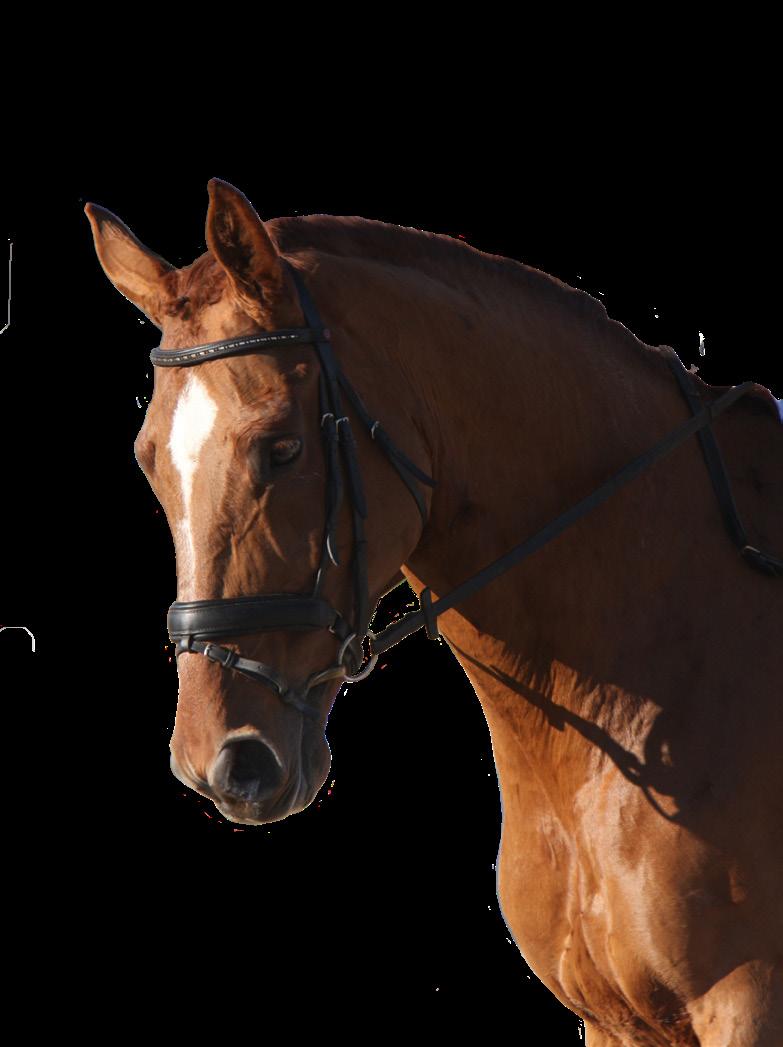
• Get a taste of the USDF L program
• Clinic with British master Carl Hester
USDF CONNECTION | November/December 2022 41
BRUCE LAWRIE
REGISTER YOUR HORSE WITH USDF! The $115 USDF Lifetime Horse Registration: • Fulfills horse registration requirements for ALL USDF award and championship programs.* • Never needs to be renewed.
Great Danes
Host nation wins dressage team gold; another Brit named Charlotte steals the show STORY AND PHOTOGRAPHS BY JENNIFER O. BRYANT
DREAM FINISH: The Danes won dressage team gold on home soil.
From left: Cathrine Laudrup-Dufour on Vamos Amigos, Nanna Merrald Rasmussen on Blue Hors Zack, Daniel Bachmann Andersen on Marshall-Bell, and Carina Cassøe Krüth on Heiline’s Danciera.

42 November/December 2022 | USDF CONNECTION
TThe last time a dressage audience went this crazy, it was in London 2012.
When Charlotte Dujardin on Valegro and the rest of Team Great Britain swept the dressage gold medals at the 2012 Olympic Games, the largely home-country
crowd roared at rock-concert levels. The Brits’ fervor re mained unmatched for a decade—until Denmark hosted the 2022 Ecco FEI World Dressage Championships.
The Event Formerly Known as WEG
Since 1990, the Fédération Equestre Internationale (FEI), the international governing body of horse sports, had held all of its disciplines’ world championships during a quadrennial equestripalooza called the World Equestrian Games (WEG). Over time the WEG concept began to buckle under the weight of financial strains, and following the hurricane-disrupted 2018 WEG in North Carolina, the FEI decided to entertain the idea of split-discipline championships.
Herning, Denmark, successfully bid to host the 2022 World Championships in dressage, para-dressage, jumping, and vaulting, which were held August 4-14 in the MCH Messecenter Herning, a well-appointed sports and entertainment complex in west-central Denmark featuring a nearly 12,000-seat outdoor stadium, a 12,500-seat indoor sports arena, and an outdoor arena.
With more than 73,000 tickets sold and 153,000 to tal visitors, the 130-acre complex easily rivaled any past WEG venue for crowds and excitement. Its compactness and walkability earned high marks from competitors and spectators alike; and competitors praised the orga nization, facilities, and footing.
A Very Special Gold Medal
The Danes’ team dressage gold medal was not only a home-country victory; it was also their first-ever dres sage team gold medal at an FEI World Championships, and Denmark’s first World Championships dressage title since the legendary Anne Grethe Jensen and Marzog won individual gold in 1986.
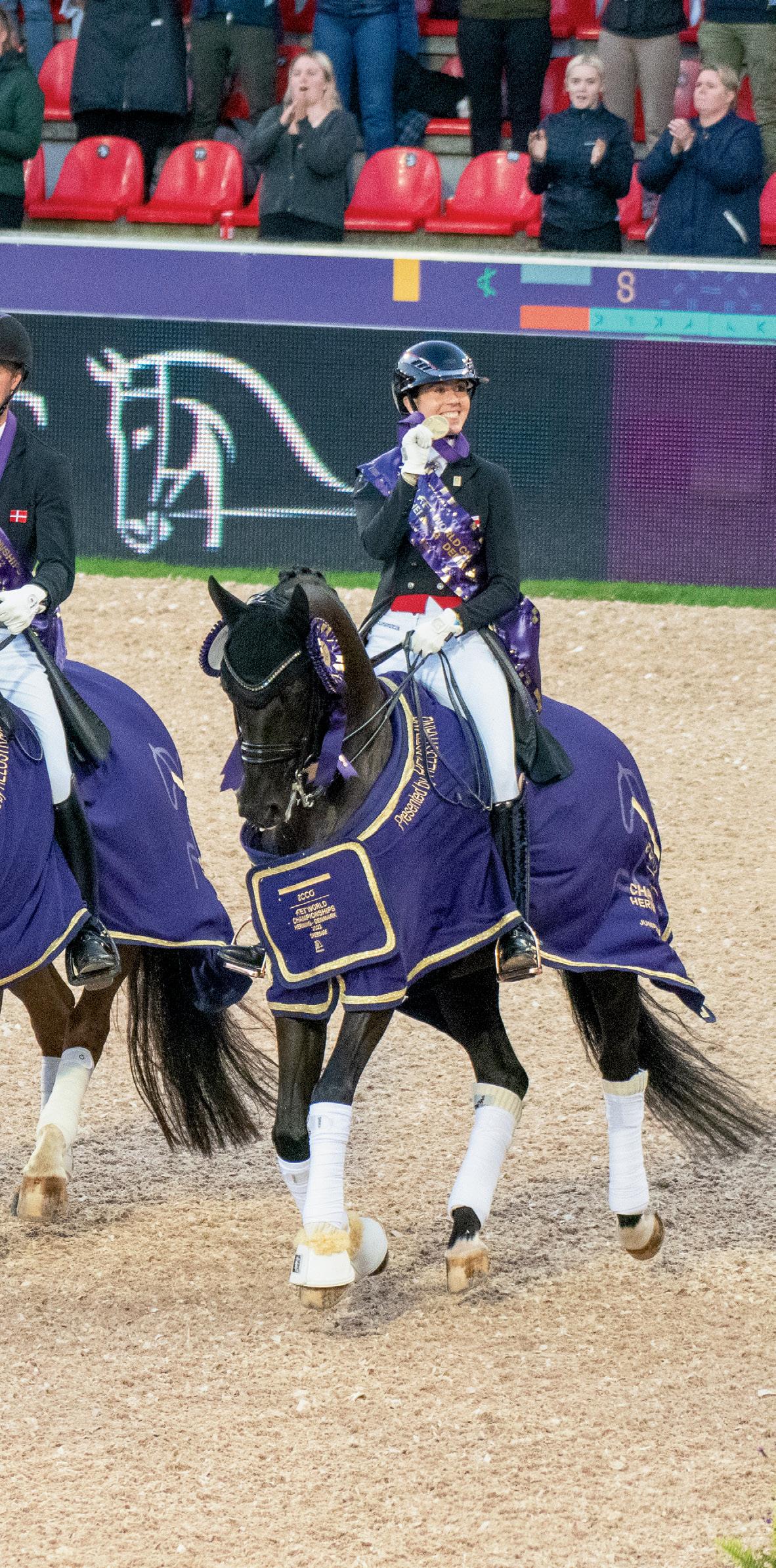
Led by present-day stars Cathrine Laudrup-Dufour on the 10-year-old Westfalen gelding Vamos Amigos (Vitalis x Blue Hors Hotline), Team Denmark danced to gold on a team total score of 235.451. Great Britain won silver on a team total of 234.223, and Germany claimed bronze on 230.791.
“I was a bit nervous; I am always nervous,” LaudrupDufour admitted after her Grand Prix test. Of her 81.864% score, which topped the individual leader board over the 92 total starters, she said: “My horse was nothing short of amazing. I feel so immensely proud for what my team members have done. We are all so proud of our achievement.”
USDF CONNECTION | November/December 2022 43
[
Grand




From the way she was jumping for joy atop the silver-medal po dium, you might have thought Brit ain’s Charlotte Dujardin had won gold herself. But this time Dujardin was ecstatic over the team results and especially with the performance of her newest elite partner, the nineyear-old KWPN gelding Imhotep (Everdale x Vivaldi), who earned a Grand Prix score of 77.407% for an individual fourth-place finish.
“I’m absolutely thrilled with Im hotep,” Dujardin said after her test. She said that “Pete” had competed only three times at the Grand Prix level prior to Herning 2022, so “I had no idea how he was going to behave in there—no idea.” Some snorting was the only obvious sign that Pete was a bit overwhelmed in Stutteri Ask Stadium, but “He was a bit scared in there,” she said. “I had to give him confidence. You could tell with the sneezing. I thought, I’ve got to give him a nice round. He’s like a deer in the headlights.”
“I love that horse,” she enthused. “He makes me smile every day from ear to ear. He’s got so much power, so much expression. He just wants to please you every day. He never runs out of energy.”
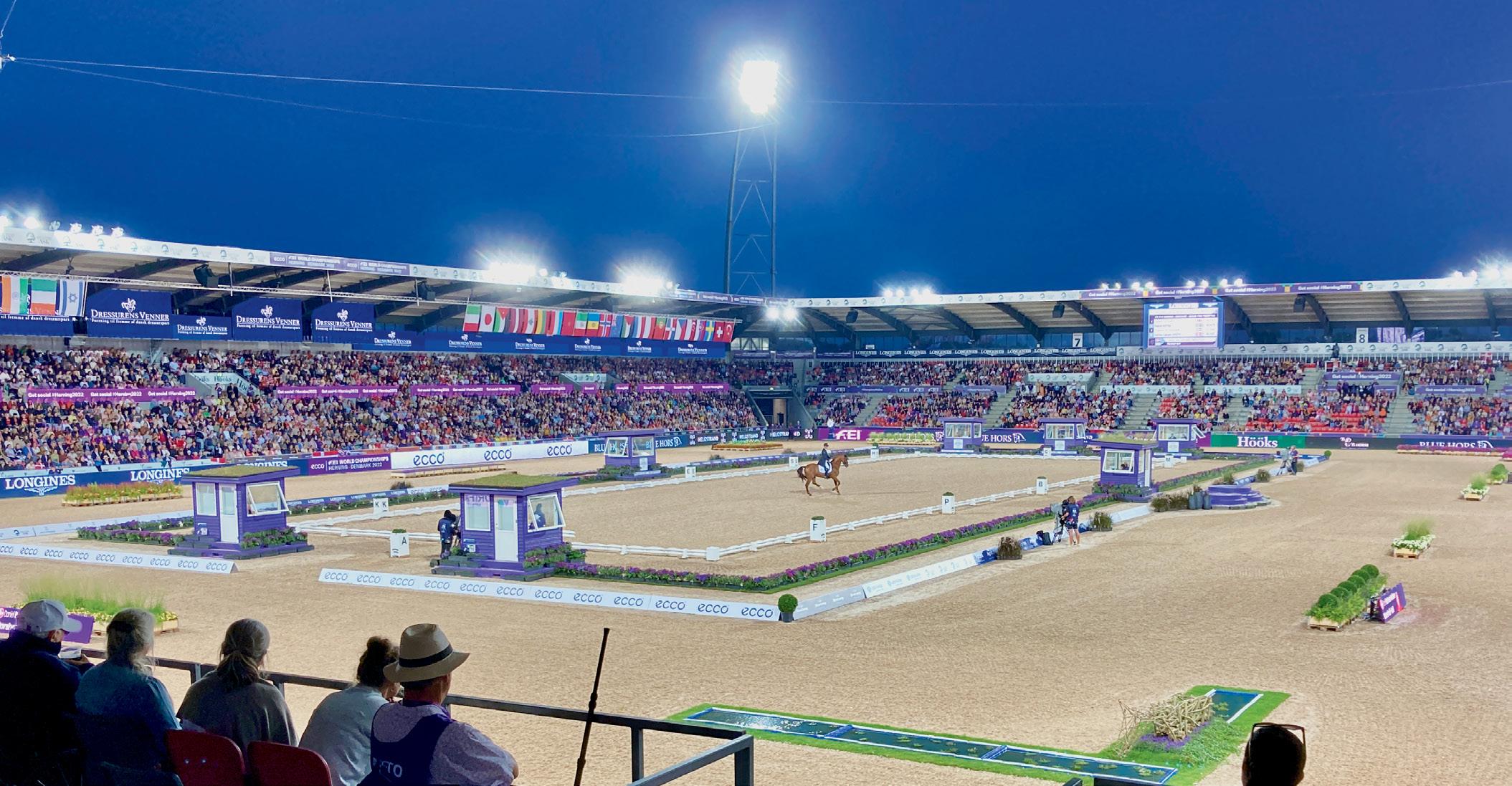
44 November/December 2022 | USDF CONNECTION
LIT UP WITH EXCITEMENT: Stutteri Ask Stadium during the Grand Prix Freestyle
Prix Team Results Gold: Denmark Cathrine Laudrup-Dufour/Vamos Amigos (Vitalis x Blue Hors Hotline) ....... 81.864 Carina Cassøe Krüth/Heiline’s Danciera (Furstenball OLD/De Niro) ........ 76.863 Nanna Merrald Rasmussen/Blue Hors Zack (Rousseau x Jazz) .................. 76.724 Daniel Bachmann Andersen/Marshall-Bell (Blue Hors Don Romantic x Michellino) ..................................................... (76.584) TEAM TOTAL 235.451 Silver: Great Britain Charlotte Fry/Glamourdale (Lord Leatherdale x Negro) ............................... 80.838 Charlotte Dujardin/Imhotep (Everdale x Vivaldi) ............................................. 77.407 Gareth Hughes/Classic Briolinca (Trento B x Royal Dancer) ....................... 75.978 Richard Davison/Bubblingh (Lingh x Picandt) ............................................... (68.851) TEAM TOTAL 234.223 Bronze: Germany Isabell Werth/DSP Quantaz (Quaterback x Hohenstein 4) .............................77.127 Benjamin Werndl/Famoso OLD (Farewell III x Welt Hit II) ............................. 77.003 Frederic Wandres/Duke of Britain FRH (Dimaggio x Rubinstein) ................ 76.661 Ingrid Klimke/Franziskus (Fidertanz 2 x Alabaster) ..................................... (75.683) TEAM TOTAL 230.791 6. USA Steffen Peters/Suppenkasper (Spielberg x IPS Krack C) 74.767 Adrienne Lyle/Salvino (Sandro Hit x Donnerhall) ........................................... 74.394 Katie Duerrhammer/Quartett (Quaterback x Dream of Glory) .................... 70.839 Ashley Holzer/Valentine (Sir Donnerhall x Ragazzo) .................................... (61.258) TEAM TOTAL .......... 220.000 G S B
Pete started out as a young horse with issues, and Dujardin got the ride after her mentor, British Olympic gold medalist Carl Hester, passed on the horse.
“Carl found him,” Dujardin said. “He was a stallion; nobody wanted him as a stallion. He had a huge canter; the trot was pretty normal. He looked really ugly, I’m not going to lie. He was dead ugly. He had this whopping head, skinny neck, upside down, back there, hind legs there,” she laughed, gesturing in opposite directions. And Pete was “the naughtiest horse to break: He was like those bulls that you let out of cages at a rodeo.” A couple of intrepid riders at Hester’s yard in England managed to stay on until Pete turned five, at which time Du jardin climbed into the saddle, “and that was when he met his match.”
“He had all that cheekiness with the bucking, but he’s not a naughty horse at all. It was all like excite ment,” she realized. “Now it’s all in your advantage, isn’t it, because he has all that power and spring work ing for you. When he can manage all that power, it’s going to be spectacu lar. He’s an incredible horse.”
Team USA: On to Paris 2024
Team USA won silver medals at the 2018 FEI World Equestrian Games and the 2020 Tokyo Olympics. Ex pectations for Herning 2022 were tempered a bit, however, by the fact that only two combinations were veterans: Team USA’s own Captain America, Steffen Peters, riding Four Winds Farm’s 14-year-old KWPN gelding, Suppenkasper; and his To kyo 2020 teammate Adrienne Lyle on Betsy Juliano LLC’s fifteen-yearold Hanoverian stallion, Salvino.

The other two horses (and one rider) were going to Herning for
their first major international com petition: Katie Duerrhammer on Kylee Lourie’s 14-year-old Deutsche Sportpferd (DSP, or German Sport Horse) gelding, Quartett; and inter national veteran competitor Ashley Holzer on her own 12-year-old Hanoverian mare, Valentine.

Duerrhammer was thrilled with her score of 70.839%, saying that breaking the 70% barrier was her goal for Herning 2022, following a personal-best Grand Prix score of 71.456% at the CHIO Aachen,
Germany, in June.
“I knew I probably wouldn’t be as on my game [in Herning] as in Aachen because it’s a lot of pres sure,” Duerrhammer said afterward. She decided that her goal for Hern ing was to “go in there and put in a ride that shows the US well, and [if] we’re a confident team and a harmonious team and we can break a 70, that would be a success to me. So I’m very happy.” Rightfully so: She and Quartett comported themselves like seasoned pros, ex
USDF CONNECTION | November/December 2022 45
TEAM LEADER: Cathrine Laudrup-Dufour and Vamos Amigos were the top Danish team scorers. They went on to win GP Special and Freestyle silver medals.
EXCITING FUTURE: Charlotte Dujardin’s mount, Imhotep, was just nine at the time of the competition
ecuting a flowing, accurate test that highlighted Quartett’s character as a horse that “wants to always do the best he can possibly do” and “a very, very honest competitor.”
(See “Katie Duerrhammer and Kylee Lourie: How Teamwork Made the Dream Work” on page 48 for more.)
Peters is always happy to talk about his partner, the 18-hand “big teddy bear” Suppenkasper. “I get a bit choked up talking about him,” he said after his Grand Prix test aboard “Mopsie,” which was Team USA’s best, scoring 74.767%. “I sit with him in the stall. He loves his cookies. He knows how to open the cookie box: He puts his nose under the lid and flips the lid. Just the sweetest, kindest horse.”
Sweet, kind, and inclined to gain weight (thus the nickname, from the German slang for a tubby indi vidual) though Mopsie may be, he’s a powerhouse in the dressage arena.
“Mopsie was pretty excited today; in the extended canter, that arena was getting extremely small!” Peters said. The horse had “lots of energy, and in there he got a tiny bit low in the neck; I couldn’t get him quite as up as I wanted. But overall it was a clean test, and I’m proud of him.”
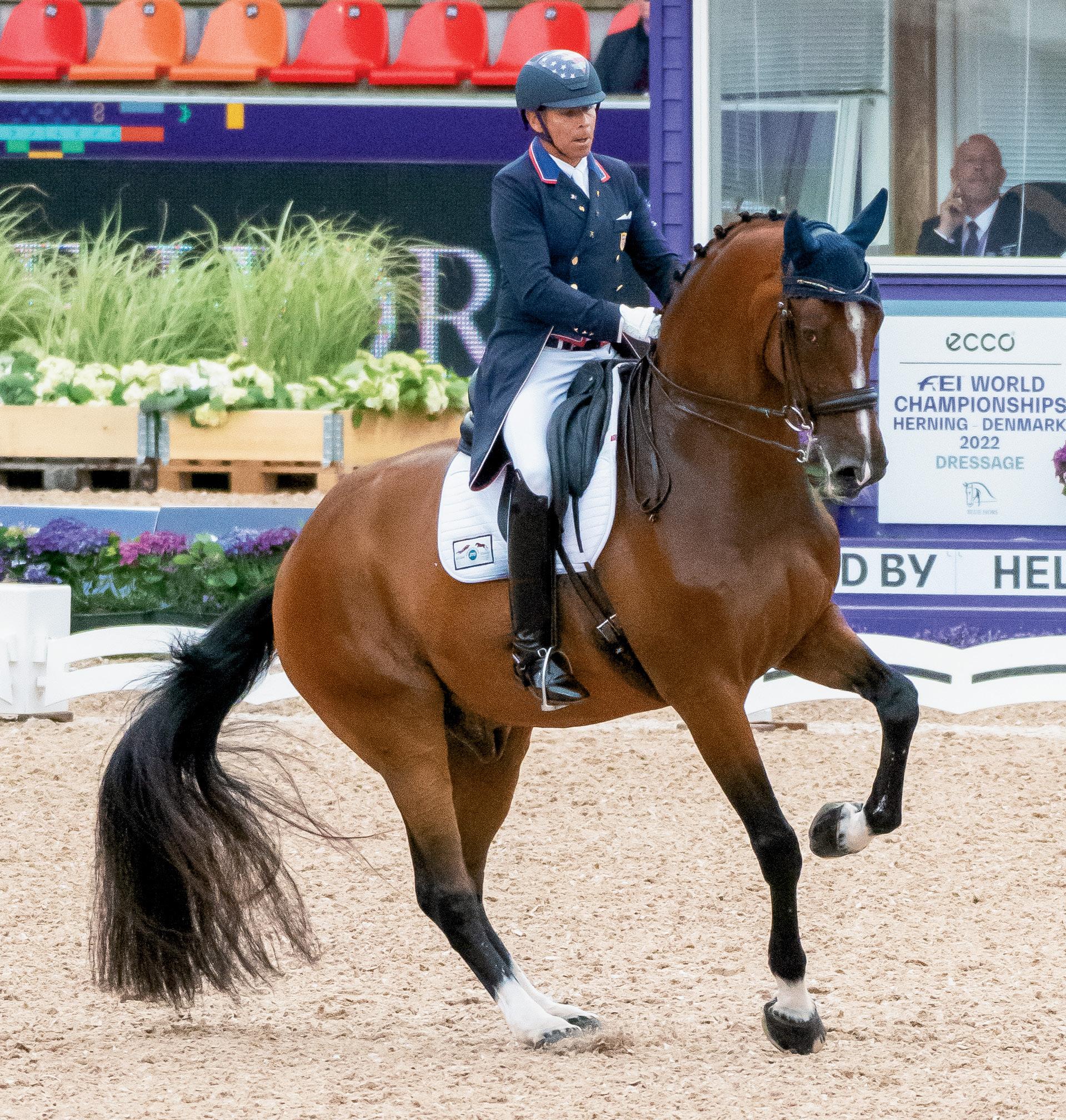
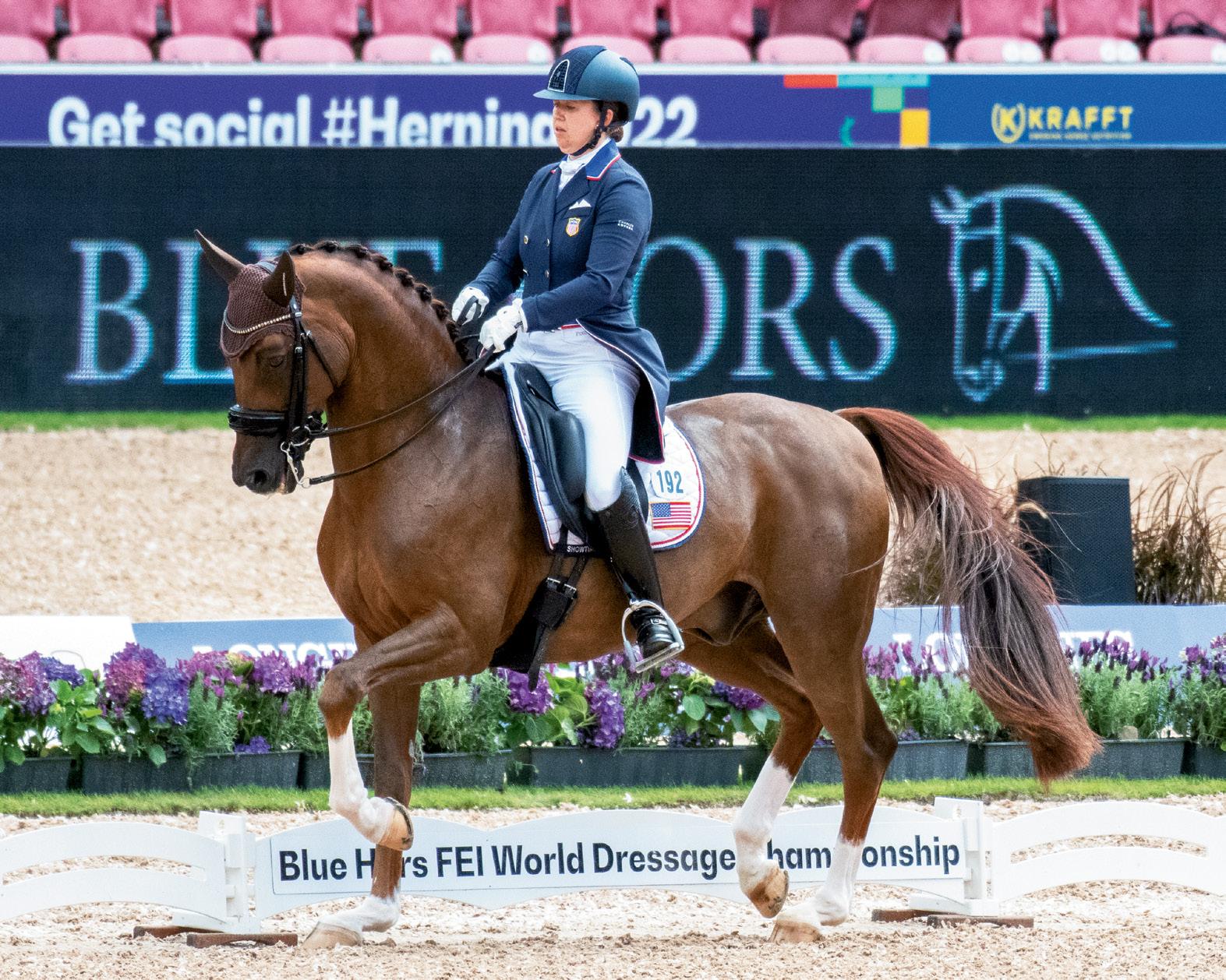
Peters is always trying to con vince Mopsie that less is more.
“When it comes to the relaxation, that was the challenge for both of us,” he said. “The extensions—I just don’t dare to push it. The piaffe and passage are always challenging. He always wants to do so much in pas sage, and one hind leg can do more than the other. Getting the regular ity, the consistency, and a bit more activity in the piaffe—that was the goal” for the team Grand Prix.
The next-best US Grand Prix finish was that of Lyle and Salvino,
46 November/December 2022 | USDF CONNECTION
LIKE SEASONED PROS: World Championships first-timers Katie Duerrhammer and Quartett
POWERFUL COMBINATION: Steffen Peters and Suppenkasper in the Grand Prix
who earned 74.394%—a score that undoubtedly would have been high er had “Vinny” not lost his balance in the canter half-pass “zigzags,” briefly trotting and then momen tarily picking up the wrong lead.


Vinny “got his leg tangled in the zigzags. That stuff happens; they are horses,” Lyle said after her ride. “But other than that, he had some really good stuff, and I am excited to move on to the Special. His piaffe-passage [tour] is always really stellar, and he is honest and giving in the ring.”
Although Team USA didn’t earn a spot on the medal podium, its sixth-place finish was actually the primary goal, according to Lyle.
“Our main goal was to qualify our country for the [Paris 2024] Olympics…so I am super excited,” Lyle said.
In Olympic dressage, nations must qualify for the Games. As George Williams, US dressage chef d’équipe for Herning 2022, explained, a top-six finish in Herning was needed to qualify for Paris 2024. (See “Backstage in Herning with Chef d’Équipe George Williams” on page 51 for our exclusive interview with Williams in Herning.)
An unfortunate meltdown in the arena put Ashley Holzer and
Valentine out of contention for the Grand Prix Special (only the top 30 individuals from the Grand Prix qualified to move on). Last to go on day 1 of the Grand Prix team competition, the mare backed off in the first piaffe, then stopped and reared in the second. Holzer expertly regrouped and continued for a good canter tour, but then rhythmic audience clapping during the final piaffe-passage tour down center line was the final nail in the coffin of Holzer’s Herning 2022 dreams. Somebody has to finish last in every class, and this time it was Holzer, on 61.258%.
Valentine is inexperienced in such large venues, Holzer said after ward, but still her reactions “caught me off guard,” she admitted after the ride. “I’ve never had her do such crazy antics, and I guess she was just tight and wasn’t really communicat ing with me properly. I thought the beginning of the test was super, really flowing, and it caught me completely off guard. But they are horses, and we have to realize that they are not machines, and they get confused. It was just something where she was tight, and I brought her back [for the piaffe] and she didn’t understand.
“I know Team USA sort of took a chance on me because she is a green Grand Prix horse,” Holzer added, “but as you can see, when she is bril liant, she is absolutely brilliant.”
Making the Cut: The Grand Prix Special
At dressage World Championships, medals are awarded for all three Grand Prix-level tests. The Grand Prix decides the team medals, and then individuals vie for medals in the Grand Prix Special and the GP Freestyle. In Herning 2022, the top 30 combinations from the GP advanced to the Special. Finishing fifteenth and nineteenth, respec tively, Peters and Lyle were the two US combinations to qualify.
The US teammates switched po sitions in the Special: Lyle finished ninth on 75.699%, and Peters was seventeenth on 73.708%.
Salvino “felt like a metronome,” Lyle said happily, “and I was just able to sit there. He felt even better than he did in the Grand Prix: a little bit looser, and more able to show himself off in the piaffe and passage today.”
Suppenkasper’s otherwise very good test had a couple of bobbles:
USDF CONNECTION | November/December 2022 47
EXPERT RECOVERY: After rather strong objections to the piaffe (left), Ashley Holzer regrouped Valentine for a lovely canter tour
Katie Duerrhammer and Kylee Lourie: How Teamwork Made the Dream Work
Talent
will only get you so far in dressage. At some point, funding is required.
Some hard-working aspiring riders make enough of an impression that a sponsor decides to give them a leg up. That’s what happened with Team USA’s Katie Duerrhammer and horse owner Kylee Lourie, of Greenwood Village, Colorado; and Wellington, Florida.
When USDF Connection met Lourie on the plane headed to Denmark, the amateur dressage rider (her day job is as the founder and CEO of the software-systems com pany Nextworld) graciously agreed to an interview.
breaking into a canter during one passage-extended trot transition, and some loss of balance during the difficult transition from passage to canter crossing center line. Still, some thought the score was a bit low, a sentiment Peters evidently shared.
“The judges saw it very differ ently, but that’s OK,” he said after ward. “That’s a part of the game, and I certainly accept it.”
Rise of the Black Stallion
TEAM EFFORT: Applauding Katie Duerrhammer’s test on Quartett were US supporters including her trainer, Adrienne Lyle (second from left), and Quartett’s owner, Kylee Lourie (third from left)

Duerrhammer, 34, had been a working student under Olympian Debbie McDonald, won team and individual gold medals at the 2008 FEI North American Young Riders Championships, then worked at a dressage facility in Europe. Back in the USA, Duerrhammer (née Katie Johnson) was taking a break from the horse business when the connections she’d devel oped paid off.
“Approximately 12 years ago, I was looking for a better trainer, and I called Debbie McDonald,” Lourie said. “She pointed me to Katie, who at the time was 21. She looked like she was 16. Our two young daughters had done Pony Club, and now they were serious about dressage. So Katie came out to be their trainer and to ride for us.” Duerrhammer, who’s originally from the San Diego area, has been with Lourie’s TyL Farm ever since.
“I really fell in love with how much I could trust her, because she put my daughters first, you know?” Lourie continued. “I decided I believed in her enough to want to see if we could get her to the Olympics, but not by buying a finished horse. So we started buying young horses.”
Quartett, Duerrhammer’s mount for Herning 2022, was actually purchased for Lourie to ride. (It was Duerrhammer’s Herning teammate Adrienne Lyle, McDonald’s protégé and today Duerrhammer’s primary trainer, who found the German-bred horse.)
“He’s so amazing for Katie,” Lourie said of “Ted.” “He just gets out there and never lets her down. He just does his job, and he’s so good for her confidence.”
After her Grand Prix test in Herning, Duerrhammer said of Lourie that “It was kind of a dream of ours to have a team horse and owner and build them togeth er. I feel like it was extra-special to have the first horse we really accomplished this on be one that she’s actually ridden a lot. When he’s at home, she rides him all the time and goes out and plays on things, and then I take him out and show him.”
“This is the beginning of Katie’s journey,” said Lourie, who also owns Paxton, Duerrhammer’s other current Grand Prix mount and her team silver-medal-win ning partner at the 2022 CDIO5* Rotterdam, Netherlands. “We’re all so happy.”
In international competition, one or two horse/rider combinations may emerge as the phenomenons of the moment: Totilas and Edward Gal; Valegro and Charlotte Dujardin; Verdades and Laura Graves. In Herning, a spectacular black stallion and his petite rider literally galloped away with the crown as dressage’s new superstars.
I’m talking, of course, about Glamourdale and Charlotte Fry.
The British duo, who were the only pair besides Denmark’s Vamos Amigos and Cathrine LaudrupDufour to break 80% in the Grand Prix, ascended to the top spot in the Special on a score of 82.508%. The 11-year-old KWPN Glamourdale (Lord Leatherdale x Negro), who’s an active breeding stallion, had one little moment—he kicked at Fry’s leg in a piaffe—that was largely forgotten when he rocketed across the diagonal in an extended canter that drew gasps of amazement from the audience, then followed up with a line of enormous two-tempis. This 16.3-hand piece of equine beefcake is like Valegro on steroids—a rivet ing combination of swagger and grace. If the late Dirty Dancing star Patrick Swayze came back as a horse, he’d be Glamourdale.
Laudrup-Dufour and Vamos
48 November/December 2022 | USDF CONNECTION
Amigos put in a top-notch test other than a slight backward tendency in one piaffe and a mistake in the two-tempis, with a steadiness and elegance that earned them the GP Special silver medal on 81.322%. Taking the bronze were another relatively new pair, the Netherlands’ Dinja van Liere on the 10-year-old KWPN stallion Hermes (Easy Game x Flemmingh) (79.407%). This exciting young Grand Prix horse is an extravagant mover who can piaffe and passage with apparent ease. He can be a spook, though, and one no ticeable startle and some resulting tension depressed his marks a bit.
“Best of Britain” Is Best in the World
Just like Patrick Swayze, Glam ourdale dominated the dance floor, right into dressage freestyle history. Which was no mean feat, consider ing that of the 15 starters—the topplacing combinations from the GP Special—all but two earned scores of over 80%.


The lone US representatives, Lyle and Salvino, delivered a stirring performance to Bruce Springsteen’s “Land of Hope and Dreams” and Carly Simon’s Working Girl anthem “Let the River Run.” Superb riding and the pair’s signature elegance and harmony earned a score of 83.704%, good enough for a sixthplace finish.
Music of the 1980s was a popular choice in Herning. Danish team gold medalist Carina Cassøe Krüth and the 11-year-old Danish Warmblood mare Heiline’s Danciera finished twelfth on a score of 82.143% to a medley of movie tunes including the themes from Flashdance and Fame. A line of two-tempis set to the cho rus from Footloose was perfection. Krüth, whose husband was one of the principal organizers of Herning 2022, fittingly also included “(I’ve Had) the Time of My Life” from the Dirty Dancing soundtrack.
British team silver medalist Gareth Hughes chose freestyle music that US dressage fans might associate with a different horse and
rider. In an echo of George Williams’ famous freestyle with the late mare Rocher, Hughes and the 16-yearold KWPN mare Classic Briolinca danced to Madonna, with songs including “Who’s That Girl,” “La Isla Bonita,” and “Material Girl.” Their outstanding, toe-tapping freestyle
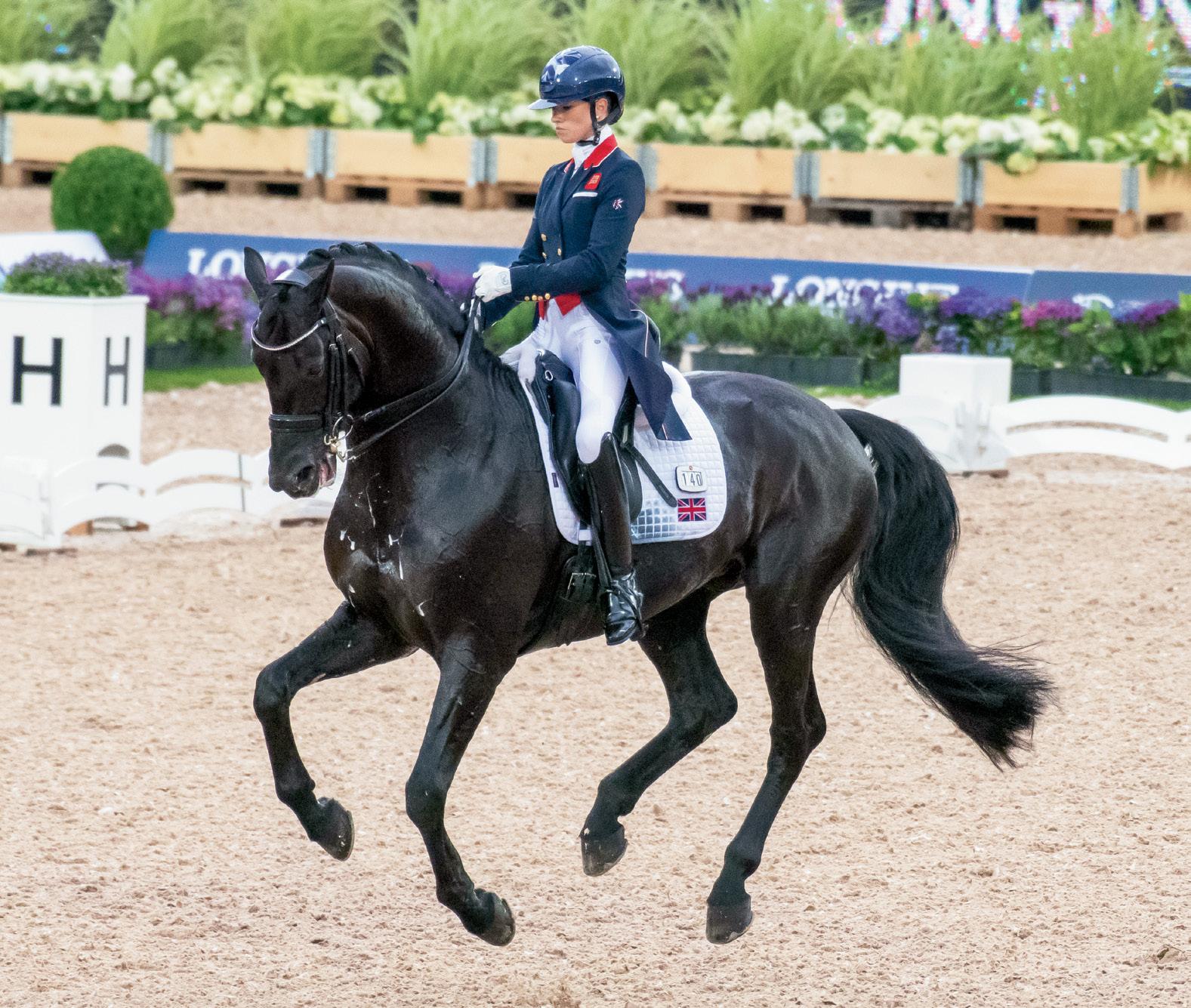
USDF CONNECTION | November/December 2022 49
AIRBORNE: Great Britain’s Charlotte Fry and Glamourdale in the Grand Prix
MAKING THE SCENE: Dutch Grand Prix Special and Freestyle bronze medalists Dinja van Liere on Hermes
HARMONY: Adrienne Lyle and Salvino in the Grand Prix Special
earned a score of 84.043% for fifth place.
Germany’s Isabell Werth put her heart into her freestyle—literally. The legendary competitor rode to ’80s radio staples including “Straight from the Heart” and “It’s a Heart ache.” In a clever touch, Werth rode a piaffe pirouette straight into a can ter pirouette to the strains of Bonnie Tyler’s “turn around” refrain from “Total Eclipse of the Heart.” Werth’s ninth-place finish (83.339%) was a strong showing for her newest Grand Prix mount, the 12-year-old DSP stallion DSP Quantaz.
The evening’s biggest disappoint ment was summed up by the audi ence’s collective gasp of horror early
in the promising performance of Spain’s Alejandro Sanchez del Barco on the 11-year-old PRE stallion Quincallo de Indalo (Esbelto VII x Bandolero LXVII). The highestplaced member of the Spanish team, Sanchez del Barco looked to be having the ride of his life as he went for broke in his freestyle set to the customary Spanish music. But near the end of a diagonal in an extended trot with his hair on fire, Quincallo de Indalo stumbled and nearly went down. The pair recovered and finished their freestyle apparently unhurt, but of course the problem cost them dearly and they ended up fourteenth on 78.386%.

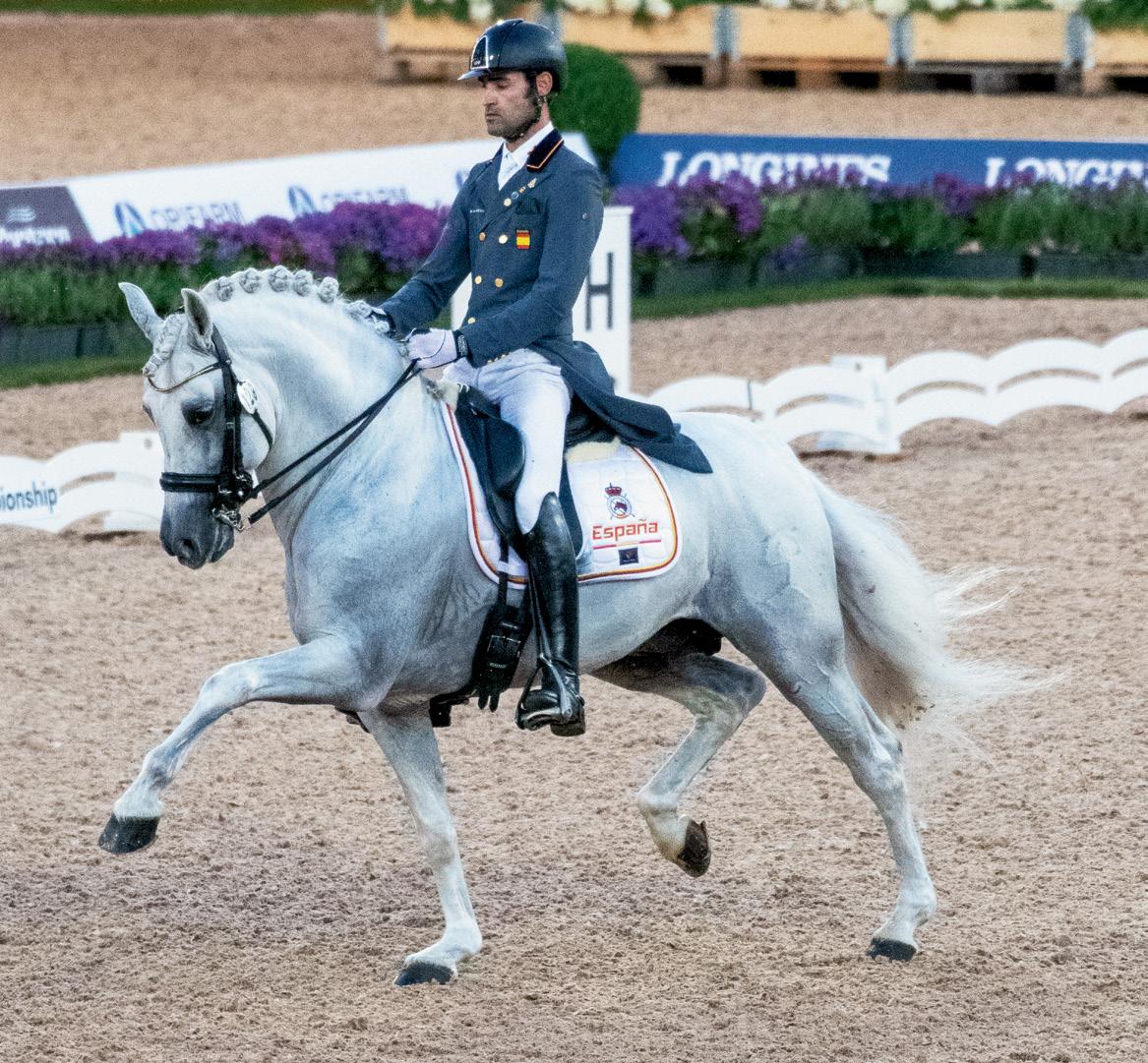
The final dressage event of Hern
ing 2022 concluded with a thrilling battle for the medals. As they had in the GP Special, Laudrup-Dufour won silver and van Liere won bronze. Van Liere’s freestyle aboard Hermes (86.900%) made the statement that she’s arrived on the international scene to stay, with a technically challenging floor plan to hip-hop stars the Fugees’ “Ready or Not” (Here I Come). One note worthy difficult move, executed su perbly: an extended canter directly into collected walk.
A delirious Danish audience sent the evening’s final rider, LaudrupDufour, out to deafening cheers after her freestyle to music from the musical Les Miserables. Her power ful performance aboard Vamos Ami gos, with just one bobble during an extended trot, earned her the silver medal on a score of 89.411%.
But again no one could top Char lotte Fry and Glamourdale. Their freestyle, entitled “Best of Britain,” showcased the stallion’s enormous gaits and jaw-dropping extended can ter. Glamourdale’s foot-perfect routine to “God Save the Queen,” “Another One Bites the Dust,” “Bittersweet Symphony,” and “Hey Jude” had the audience mesmerized. Fry clinched
50 November/December 2022 | USDF CONNECTION
Grand Prix Special Results Gold Charlotte Fry/Glamourdale (GBR) .......................................................... 82.508% Silver Cathrine Laudrup-Dufour/Vamos Amigos (DEN) 81.322% Bronze Dinja van Liere/Hermes (NED) ................................................................ 79.407% 9. Adrienne Lyle/Salvino (USA) 75.699% 17. Steffen Peters/Suppenkasper (USA) 73.708% COULD’VE
BEEN A CONTENDER: Alejandro Sanchez del Barco of Spain was having a fantastic freestyle aboard Quincallo de Indalo (left) when a dramatic stumble knocked him out of the running
Backstage in Herning with Chef d’Équipe George Williams
If it has something to do with dressage, George Williams is probably involved. The Wellington, Florida resident’s roles range from USDF president to US Equestrian (USEF) national dressage youth coach to—as of this year—USEF high performance and pathway development advisor.
It was in the latter capacity that Williams was in Denmark for the Ecco FEI World Equestrian Games Herning 2022, serving as chef d’équipe of the US dressage team. USDF Connection caught up with Williams during the rest day be tween the Grand Prix Special and the GP Freestyle. We asked how he’s settling into the role and what it means to be a chef in this very high-profile kitchen.
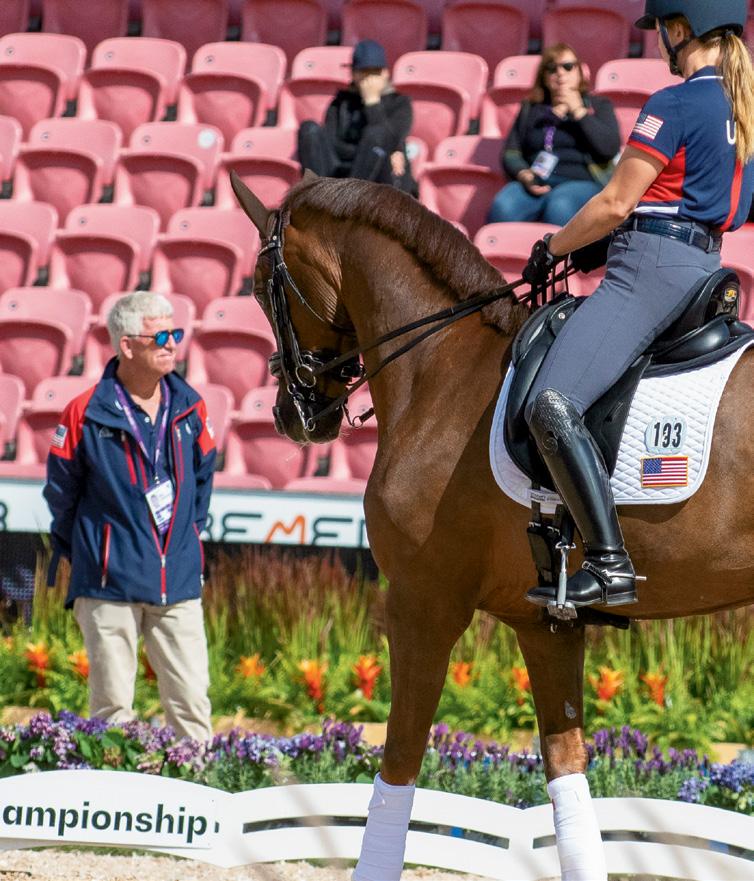
He’s not the team coach. “There really is no coach,” Williams explained. “My role is much more a program advi sor. It oversees a lot of different things—all the emerging athletes, horses, and youth, and the [USEF] Developing pro gram…not really overseeing per se, but as an advisor to those programs.”
Williams has been involved behind the scenes for a long time. “I’ve always played a role [with the US dressage teams], being on the committees,” he said. “When USEF had the High Performance Dressage Committee, I chaired that. A lot of what I do [in my current role] is just an outgrowth of that.”
Building the structures that build the teams. There are “layers” to the process of selecting a team to represent the US in international competition, Williams explained. There is a committee of selectors; “I’m not one because I’m now in a position where I make recommendations to the selectors. I was a selector for years.” In his current role, he works with the selectors on such things as “details in the qualifying pro cedures that still need to be worked out. Observation events and how we handle observation events—how we’re going to use those observation events to get the most out of them. What’s fairest for the athletes.”
In an advisory capacity, accompanied by the US dres sage team veterinarian and the USEF dressage managing director, Williams conducts what are called “home visits” with members of the US elite and pre-elite lists. “We go talk to the riders to see where they’re at—to get a sense of what their plans are. Is a World Championships in their plans? Are they thinking of waiting until 2023? What about World Cup? We try to also meet with their trainers.”
The chef’s role. A chef d’équipe—French for “team leader”—is appointed for each US equestrian team at an international event. Williams described the role as that of a team manager. Working alongside the USEF dressage staff member in attendance, “Our job is to make it such that the athletes have as little to worry about as possible and really focus on competition.”
On site at a competition, the chefs are “the ones who interact with the organizers. Going to chefs’ meetings, de termining the order of go, bringing questions to the organiz ers… We’re also responsible for making sure the organizers provide a level playing field.” It’s a position, Williams said, that when things run smoothly, “it can be that you don’t have a
lot to do. You have to watch everything to make sure nothing goes wrong that needs addressing.”
Williams said that his days in Herning were “pretty quiet because we have a really good group of experienced competitors. Obviously Katie [Duerrhammer] is newer to this, but she is surrounded by three very experienced competitors. My job is to make certain they are very comfort able with what they need to know, from the warm-up to the competition— that they’re on time, they know what the process will be, where the bit check will be afterward. If they have special requests about any of that, I take those forward to the stewards. It’s not really run ning interference, but it’s being ready to help them in many different ways.”
STANDING WATCH: Herning 2022 US dressage chef d’équipe George Williams looks on during Katie Duerrhammer’s arena-familiarization session
Goal achieved. In Herning, “the most important thing [for Team USA] was qualifying for Paris [the 2024 Olympics],” Williams said. The US dressage team finished sixth—and a top-six finish was required to qualify.
Had that not happened, the USA would have had to win team gold or silver at the 2023 Pan American Games in Chile, Williams explained. To accomplish that, “We probably would have to send our top Grand Prix horses. This gives us more options and allows us to send our top horses to Europe” to gain experience. “For us, at that level, it’s really crucial.”
Keeping up with the Europeans. “Isabell [Werth], Cathrine [Laudrup-Dufour], Lottie Fry—any of those that are based in Europe, they are able to compete on a far more regular ba sis,” Williams said. “They’re constantly competing. We come in and do a couple of shows. It is a challenge.”
The winter show circuit in Florida is a tremendous help, he said, but the level and volume of competition in Europe are still such that US riders need firsthand exposure to that environment.
“It’s extremely instructive on that level, even just being at the competitions, getting to see the top group and see where the top horses are currently,” he said. “It’s one thing to watch videos, but when you see them in person….it’s keeping our eye on the ball and knowing what we have to be doing. It’s crucial that we don’t get left behind in any way.”
USDF CONNECTION | November/December 2022 51
Anne Gribbons: The View from K, H, and B in Herning
5* dressage judge Anne Gribbons, of Chuluota, Florida, was the US member of the ground jury at Herning 2022 (at K for the Grand Prix, H for the Special, and B for the Freestyle). USDF Connection caught up with her by phone after the competition to get her insights on the dressage performances.

FEI
USDF Connection: At every one of these international events, it seems as if somehow the horses and riders manage to keep improving. Is that how it seems to you?
Anne Gribbons: Absolutely true, even if it will probably get better, although it’s sort of hard to imagine. In Herning in par ticular, there was such a variety of horses—not in quality, but in motion. In the two top horses, for example, there was such a stark contrast between extremely good and extremely good; they both had such a special way of moving. Cathrine’s horse, Vamos Amigos, has more of what I think of as a Dutch way of moving—almost like high, articulated joints and lots of shoulder coming up, but not necessarily going forward. A compact way [of moving], with the hind leg right under, and he’s in total bal ance within his frame all the time, which makes his transitions so correct and so right on, and the pirouettes easier, and the in
Grand Prix Freestyle Results
Gold Charlotte Fry/Glamourdale (GBR)
Silver Cathrine Laudrup-Dufour/Vamos Amigos (DEN)
Bronze Dinja van Liere/Hermes (NED)
6. Adrienne Lyle/Salvino (USA)
and out of piaffe. Everything is so balanced, so precise and ac curate. So that’s one type of horse.
Then you have the other one, Glamourdale, that is all elastic ity, reach, volume, and ground cover. They are like two different, both fabulous, fantastic worlds. When you have them coming one right after the other, I’ll tell you, it’s very exciting for a judge to ap preciate their specific nature and way of moving and character.
Glamourdale comes off the ground like he’s propelled—like an airplane, like he’s actually taking off and he’s not going to land. That huge volume and elasticity in everything he does also make the connection sometimes more difficult—in particular in the tran sitions, which he handled beautifully, but sometimes you went, “Oh, I don’t know how that’s going to end.” But that made it that much more exciting, and of course he pulled it off.
She [rider Charlotte Fry] was aware she also could have won the Grand Prix team test, but the pirouettes caught her. That’s what made the difference to me, at least. [The top pairs] did ev erything, they never made a mistake; but when you got down to those minute details in balance, collection, and transitions, the transitions right now are what win or lose the test.
It’s those little glitches here and there. You could say, in the freestyle, [the top two horses] were both wonderful in all the movements, but sometimes in the contact, Cathrine’s horse was sometimes a little bit like, not really in the hand; he backed off or got a little shy off the bit or behind it, and that’s all it takes.
You can’t afford any mistakes—not at the top. That’s how good the sport has become.
Dinja van Liere’s horse, Hermes, who won two individual bronze medals, is also an extravagant mover. And he’s young.
He got better with every test. And that’s another thing: There were nine or 10 horses [in Herning] that were nine. That’s young for being in a championships. Yes, many of the horses were young, but they could handle it. They were probably brought along correctly because they didn’t look stressed, or overridden, or anything.
I have never seen an audience be so boisterous while a test was going on. I thought that wasn’t supposed to be OK to do, and yet it was obvious that many of the horses were used to it—except for Cathrine’s horse, when the audience would
the gold medal on a score of 90.654%.
“I’ve never had that feeling before, where you enter the arena and the crowd is going crazy before you’ve even started,” Fry said after ward. “As soon as the music started, it was just the most insane feeling. He was just dancing to his freestyle, and I felt like I could just sit there and enjoy it. It was the best feeling in the world. I’ve never been in an arena like that, and I’ve never ridden a test like that.”
52 November/December 2022 | USDF CONNECTION
.......................................................... 90.654%
89.411%
86.900%
83.704%
GRAND ENTRANCE: With the other ground-jury members, Anne Gribbons (third from left) was delivered to the arena each day by horse-drawn carriage
start shushing. But for the others, the audience would clap and clap, all the way down the final center line. It spooked some of the horses.
This was a problem. There was a lot of talk about it with the JSP [FEI Judges Supervisory Panel] and the judges. Some of the horses, when they started to clap they would spook and consequently could not do the last halt. That was not just in the freestyle; [it happened] even before, in the regular tests. Some of the horses couldn’t take that, and when they got to the halt they never stood still. Now there is the judges’ dilemma. We had strong discussions about it: What do you do? Because yes, a dressage horse is supposed to totally focus on the rider and blah blah, and it should stand still never mind what, but they are horses. Some of them were actually fright ened, and a frightened horse you can’t control. A frightened horse is actually a dangerous horse, to himself and others.
This is really a dilemma because we have to settle some thing about that. There was lots of discussion: Should you give them the [score of] 1 or 2 that they deserve because there was no halt; they never stood still? Which is what you’d get if you showed no halt; you could even get a zero. What a horrible thing that would be for the score. Or do you have to take that [the horse’s reaction to the noise] into consider ation? Then there comes the next question: How much into consideration? Who should we forgive and who shouldn’t we? It’s a real dilemma.
And then a third thing: Should you make the audience al ways be quiet, so it’s like being at church? That kills the sport too. Enthusiasm is something that we encourage in the audi ence, right? They should be involved. They were very enthusi astic and that was very nice, but on the other hand it wasn’t fair to all the horses.
Let’s talk about the US riders. Adrienne Lyle and Salvino had a lovely freestyle. I was a little sorry to see them not place higher. Did you feel they ended up where they should have? I think they probably did at that particular competition. Her riding is impeccable; it always is. She is unbelievable. She ended up with an 83.704%—still pretty darn high.
Now that’s not bad. As a matter of fact, in the Special we
Welcoming a New Generation
Dressage is kinder to older athletes than most sports, but in Herning the dressage riders on the medal podi ums were noticeably on the younger side. Van Liere joked about having an “oh s&*^” moment during the Grand Prix Special medal ceremony, when she realized that at 32 she was the oldest medalist (LaudrupDufour is 30 and Fry is 26).
“I’m still a lot younger than some
already had five scores over 80. Then we had how many in the freestyle?
There were 13 out of 15 with scores over 80. Only two were below 80.
Have we ever had that before? Incredible. Adrienne did as good a job of her riding as ever, but I don’t think he was quite as good as he was in the [2020 Tokyo] Olympics. There was a little lack of that spirit and bounce. He did his job beau tifully, and they were right in there.
Steffen’s [Peters] horse [Suppenkasper] stayed right in there too. And Katie [Duerrhammer]—I was just floored. She clocked around like she had done this many times before. She looked secure; she looked confident. The horse [Quartett] was happy to be there. I was really happy with her ride. There was wonderful harmony. That’s a very promising rider, I think.
Then of course Ashley [Holzer, whose mare Valentine balked in her Grand Prix test]. We felt horrible for her. We’ve all been at some important show where the horse said, “Not to day.” That’s exactly what the horse did. Ashley has lots of experi ence and is a very cool rider; she just made the most out of it to get through the test. You could see it: “Just get through the test so we don’t get eliminated.” At least we had a team [because all four horses completed the Grand Prix]. It was really unfortunate because she had been going quite well in Europe.
For the US, I suppose it was a disappointment not to medal but a great relief to have qualified for the Paris Olympics.
I have been in this game for long enough to know that it al ways goes in waves. The only team that used to always come out on top was the Germans. Now, between the Danes, the Germans, the Brits, the Americans, the Dutch, there are five or six teams that can take over at any championships. It’s more exciting from that point of view. And the Spanish are starting to knock on the door.
Every team is not going to have a top championship every time any more. Nobody has that kind of grip on it any more.
For [the US], qualifying was the game, and they qualified. Good! Time to get together for the next two years. And we have lots of talent coming up. I think we’ll have a whole new wave.
of the other riders!”, van Liere said with a laugh.
According to Laudrup-Dufour, the horses are changing, as well, with today’s top horses possessing an innate athleticism, balance, and power that enable them to climb the levels quickly—Glamourdale is 11, and Vamos Amigos and Hermes are just 10. The Danish medalist attrib uted the advances to generations of selective sport-horse breeding.
“You can really tell now that the
horses are born to do this,” LaudrupDufour said. “It makes it so much fun for us riders because we can really just dance and play. You can dance with them; you don’t have to tell them.”
Patrick Swayze—who was a horseman himself—would be proud.
Jennifer O. Bryant is the editor of USDF Connection.
USDF CONNECTION | November/December 2022 53
Scenes from Herning
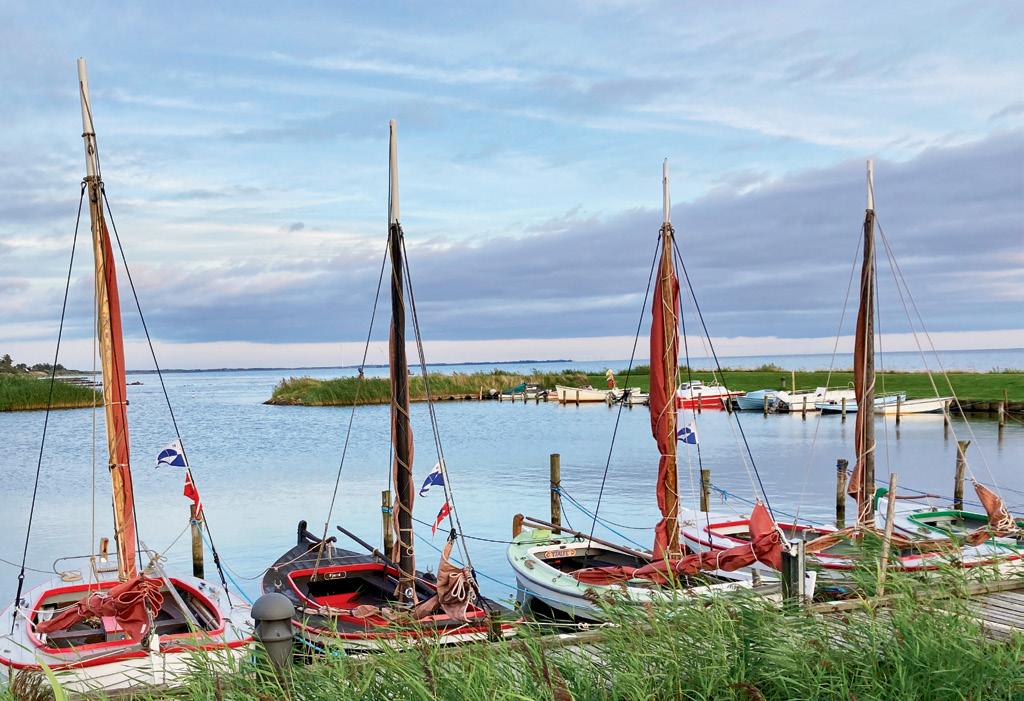

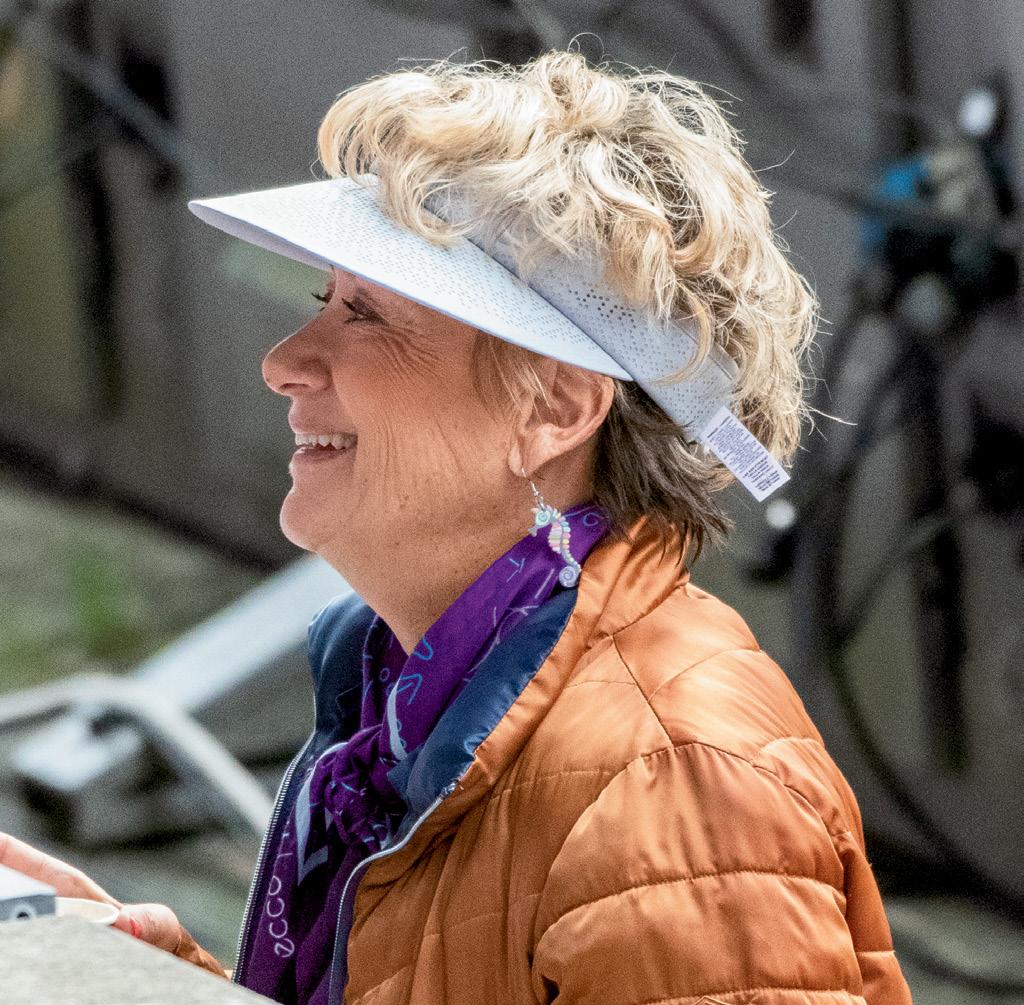
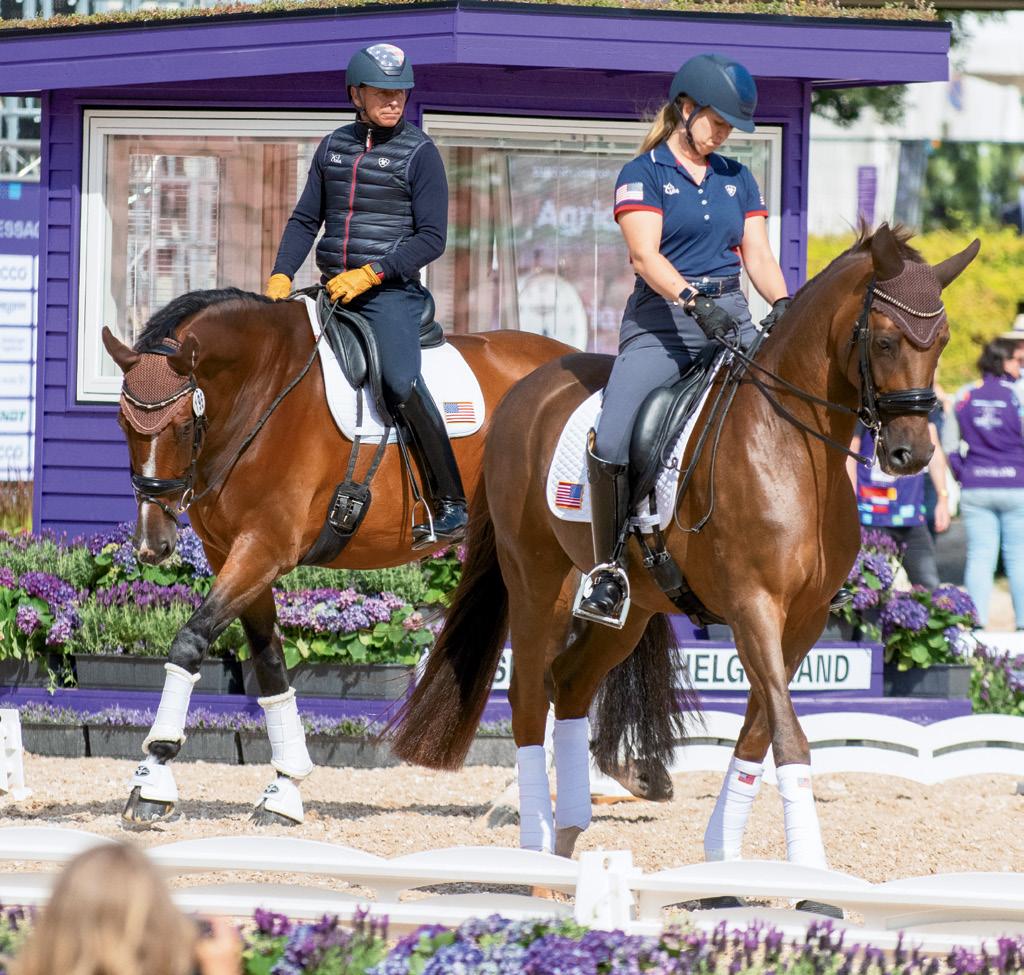

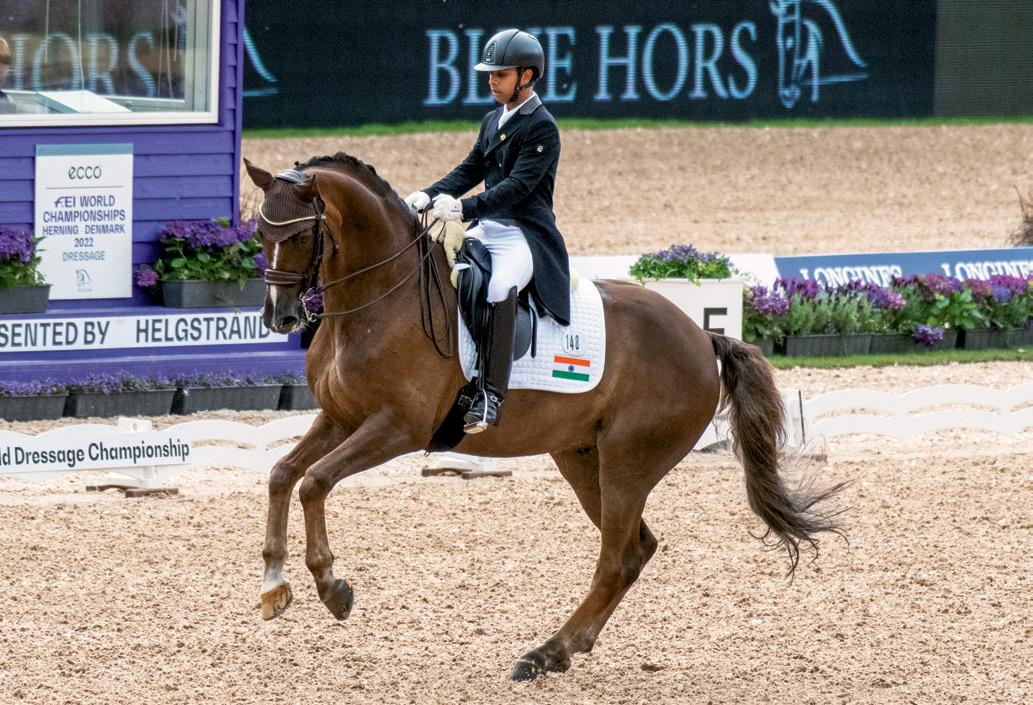 F rom charming towns and bucolic farmland to thrilling equestrian competition, Denmark was a feast for the senses during the Ecco FEI World Championships Herning 2022.
Anush Agarwalla on Sir Caramello OLD was the first pair to represent India at a dressage World Championships
World Championships draw a global list of competitors. Rider Caroline Chew of Singapore jogs Tribiani at the dressage horse inspection.
Steffen Peters and Katie Duerrhammer during an arena-familiarization session
US FEI 5* dressage judge Janet Foy was the FEI technical delegate for the dressage competition
Hotel Ringkøbing, one of the media hotels, is situated in a charming fjordside town
Sailboats moored at Ringkøbing Fjord, adjacent to the North Sea
F rom charming towns and bucolic farmland to thrilling equestrian competition, Denmark was a feast for the senses during the Ecco FEI World Championships Herning 2022.
Anush Agarwalla on Sir Caramello OLD was the first pair to represent India at a dressage World Championships
World Championships draw a global list of competitors. Rider Caroline Chew of Singapore jogs Tribiani at the dressage horse inspection.
Steffen Peters and Katie Duerrhammer during an arena-familiarization session
US FEI 5* dressage judge Janet Foy was the FEI technical delegate for the dressage competition
Hotel Ringkøbing, one of the media hotels, is situated in a charming fjordside town
Sailboats moored at Ringkøbing Fjord, adjacent to the North Sea
54 November/December 2022 | USDF CONNECTION
The home-country fans were ecstatic at the Danes’ dressage team gold medal. Fans cheer the silver-medal-winning Grand Prix Special performance of Cathrine LaudrupDufour on Vamos Amigos.
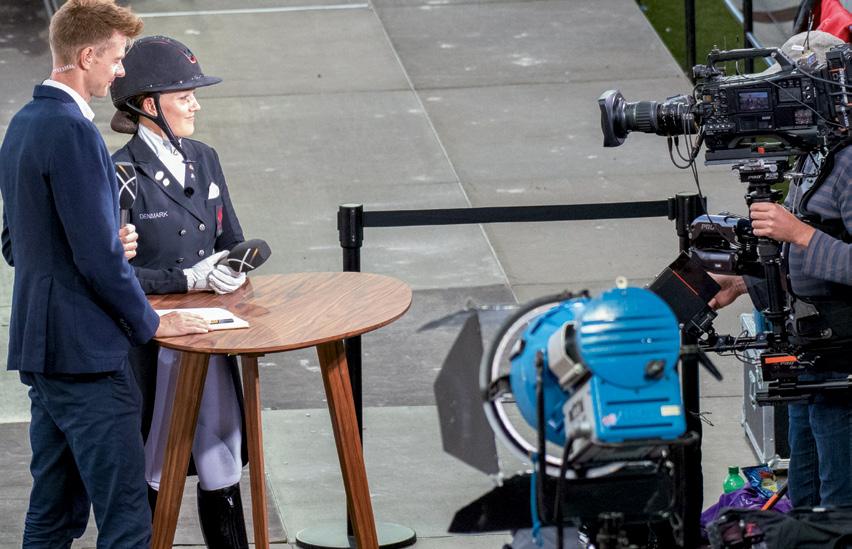
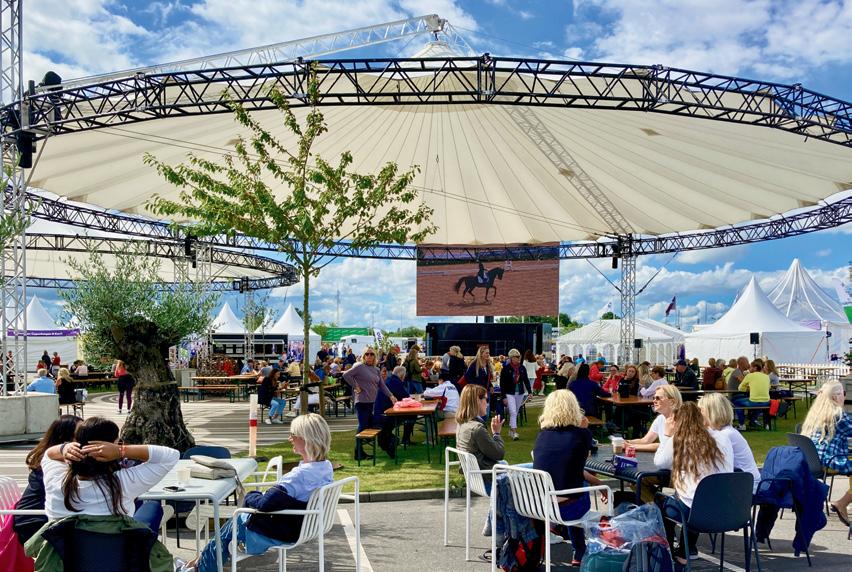

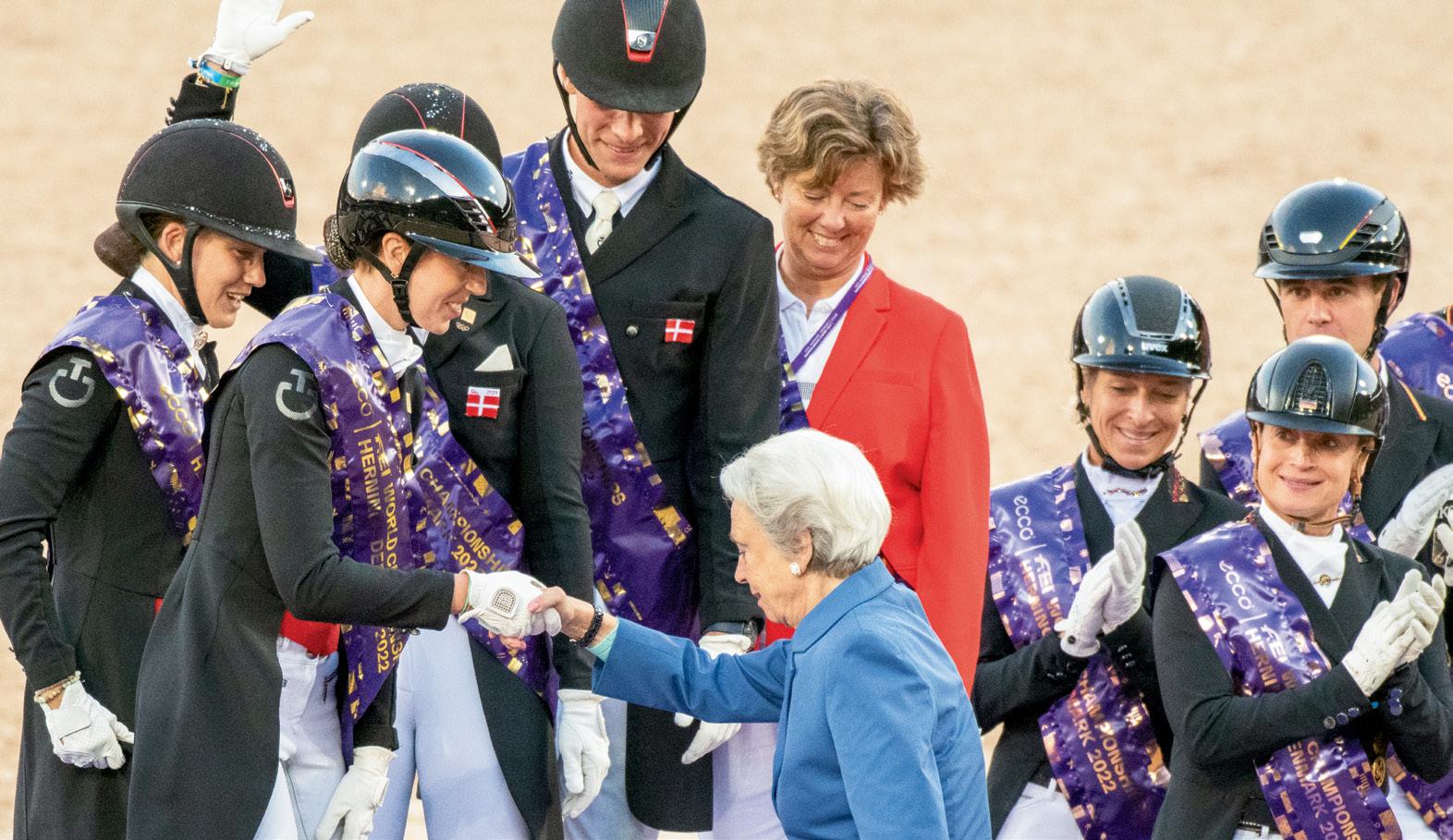


National pride is everywhere in the stands. Two Swedish fans leave no doubt as to their favorites.

A Danish Warmblood foal show and auction drew spectators to the Jyske Bank Boxen indoor sports arena during the Herning 2022 events
Children play on a pony made entirely of Legos at the Herning 2022 trade fair
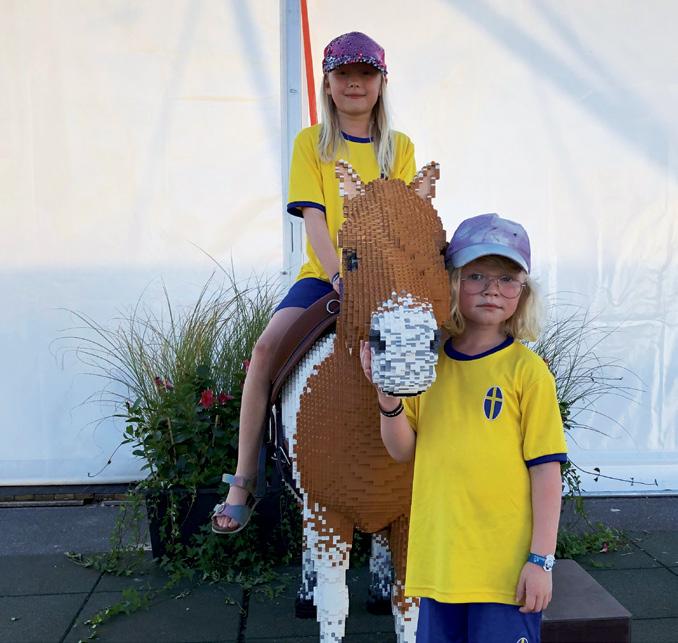
A rider and her young charge enjoy the Lego booth at the Herning 2022 trade fair. Lego is headquartered in Billund, Denmark, about an hour from Herning; and Lego stakeholders also have interests in equestrian sport in their country.

Lavish horse boxes were on display at the trade fair
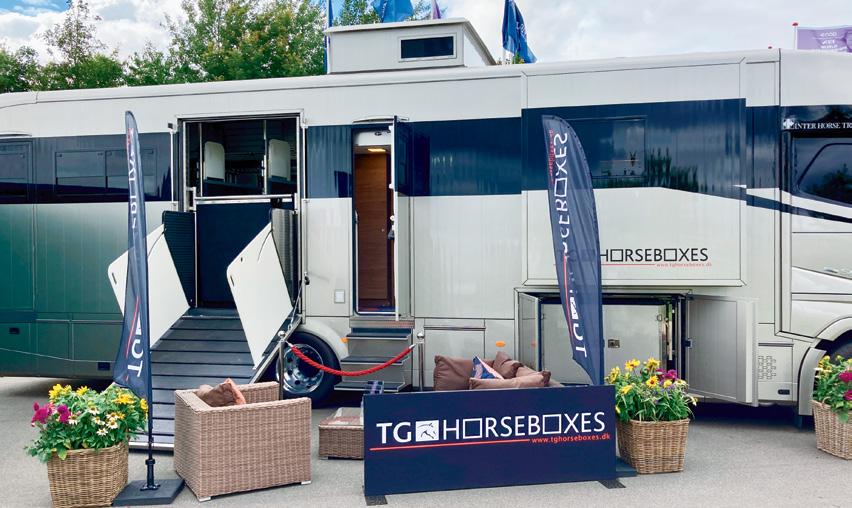
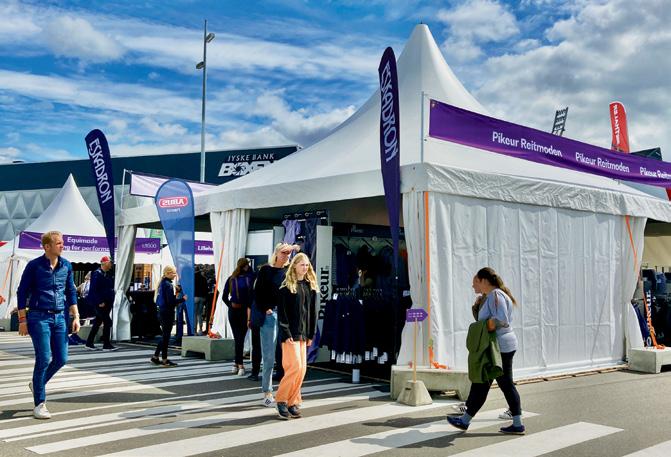 Dotted with the ubiquitous wind turbines, much of the area outside Herning looks like this
Cathrine Laudrup-Dufour prepares to give an interview to Danish TV
Danish rider Carina Cassøe Krüth helps HRH Princess Benedikte of Denmark onto the goldmedal podium during the team medal ceremony. Looking on are Danish dressage chef d’équipe Anne-Mette Binder (red blazer) and members of the bronze-medal-winning German team.
Visitors to the Herning 2022 trade fair
Trade-fair visitors watch dressage competition on a jumbo screen
LEGO PONY PHOTO CREDIT: AZUSA KITANO/JAPAN EQUESTRIAN FEDERATION
Dotted with the ubiquitous wind turbines, much of the area outside Herning looks like this
Cathrine Laudrup-Dufour prepares to give an interview to Danish TV
Danish rider Carina Cassøe Krüth helps HRH Princess Benedikte of Denmark onto the goldmedal podium during the team medal ceremony. Looking on are Danish dressage chef d’équipe Anne-Mette Binder (red blazer) and members of the bronze-medal-winning German team.
Visitors to the Herning 2022 trade fair
Trade-fair visitors watch dressage competition on a jumbo screen
LEGO PONY PHOTO CREDIT: AZUSA KITANO/JAPAN EQUESTRIAN FEDERATION
USDF CONNECTION | November/December 2022 55
US Para-Dressage Powers up at World Championships
Scores and medal count rise in Herning 2022
BY KIM MACMILLAN
The US para-dressage team traveled to the 2022 Orifarm Healthcare FEI World Para-Dressage Cham pionships with two goals: to prove that its team bronze medal at last year’s 2020 Tokyo Paralympic Games was not a onetime thing, and to qualify for the 2024 Paris Paralym pics. Those were lofty ambitions, considering that three of the four athletes competing in Herning, Denmark, in August were mounted on horses that they had been rid ing for fewer than nine months.
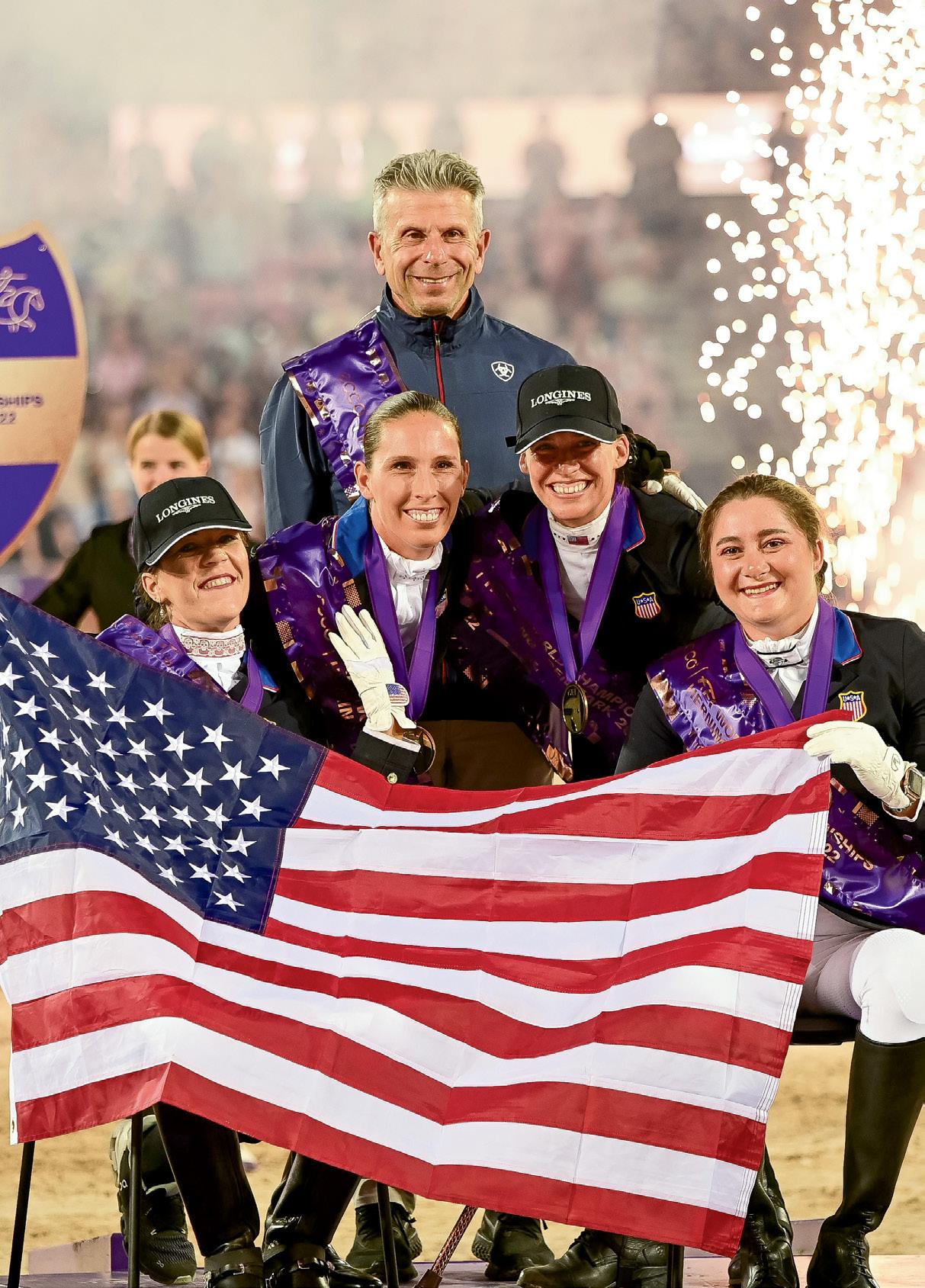
But Team USA was up to the challenge, earning not only team bronze in Herning (and punching its ticket to Paris in the process), but also with Grade III athlete Rebecca Hart taking home an individual bronze medal and Grade IV athlete Kate Shoemaker winning freestyle silver on a personal-best score. Hart, Shoemaker, and teammates Roxanne Trunnell and Beatrice de Lavalette all finished seventh or better in every class, with scores of 71% or higher; and nine of the 12 total US team rides earned fourth-place finishes or higher, with an average percentage north of 74%.
The team finish at Herning 2022—US para-dressage’s best ever at a World Championships—was the culmination of a decade of intense focus on improving our country’s para-dressage program. Team USA has been rising steadily in the international standings: finishing eighth at the 2010 Alltech FEI World Equestrian Games (WEG) in Kentucky, seventh at the 2012 London Paralympic Games, eleventh at the 2014 WEG in Normandy, twelfth at the 2016 Rio Paralympics, fifth at the 2018 WEG in North Carolina, and finally reaching the medal podium in Tokyo 2020. Leading the program since 2017 has been US Equestrian national para-dressage technical advisor and chef d’équipe Michel Assouline (see “The Game-Changer,” July/August).
Meet the Medalists
The Adequan® US para-dressage team members for Herning 2022 were:
• Beatrice de Lavalette, 24, Loxahatchee, Florida (Grade II), riding Sixth Sense, a 2010 Oldenburg gelding (Sir Donnerhall I x Florencio I) owned by Elizabeth and Nicolas de Lavalette
• Rebecca Hart, 38, Loxahatchee, Florida (Grade III), riding El Corona Texel, a 2009 Dutch Warmblood gelding (Wynton x Goodtimes) owned by Rowan O’Riley
• Kate Shoemaker, 35, Wellington, Florida (Grade IV), riding Quiana, her own 2014 Rhineland mare (Qua terstern x Rubinstern Noir)
• Roxanne Trunnell, 37, Royal Palm Beach, Florida (Grade I), riding Fortunato H2O, a 2016 Oldenburg stallion (Floriscount x Rascalino) bred by Kendra Hansis and owned by Lehua Custer.
Beatrice “Bea” de Lavalette, a University of San Diego student and a motivational speaker, was the youngest and
56 November/December 2022 | USDF CONNECTION ALLEN MACMILLAN/MACMILLAN PHOTOGRAPHY
CELEBRATION: Fireworks are a backdrop for the bronze-medal US para-dressage team in Herning 2022. Chef d’équipe Michel Assouline stands with riders Roxanne Trunnell, Kate Shoemaker, Rebecca Hart, and Beatrice de Lavalette.
newest member of Team USA, and her equine partner was also one of the three newest in Herning. Born into a horsey family, de Lavalette was an avid horse-ball player when she lost her lower legs in the 2016 Brussels airport bombing. She was riding again within five months, and she made her US team debut as a para-dressage athlete in January 2020.
De Lavalette competed as an individual at the 2020 Tokyo Paralympics riding Clarc. She’s been paired with her Herning 2022 mount, Sixth Sense, since December 2021.

“I really couldn’t be happier with my personal and team successes, even though I didn’t medal individually,” de Lavalette said. “This was my first World Champion ship. From what I learned about myself, my horse, and my riding, I will be on the podium the next time. Being a part of Team USA with Rebecca, Kate, and Roxanne makes me want to do my very best. I learned a lot about how my horse is affected by the competition arena and what I must improve with my riding.”
The most experienced team member in Herning, Rebecca “Becca” Hart, was also the athlete who’s been paired the longest with her mount. Hart, a seven-time US para-dressage national champion, is a veteran of four Paralympic Games and three WEGs. She is a 2018 WEG individual bronze and freestyle silver medalist and a 2020 Paralympic team bronze medalist. Hart, who grew up in Erie, Pennsylvania, has hereditary spastic paraplegia, a muscle-wasting disease, but maintains an active lifestyle: Besides dressage, she enjoys kayaking, sailing, camping, and rock climbing; and she works for Starbucks Coffee Company, which is now one of her sponsors. She has been paired with mount El Corona Texel since 2017.
In their team test in Herning, “‘Tex’ was truly in sync with me, and I was able to really enjoy it in the moment,” Hart said. “Tex was the last horse to go for the team, and I’m so proud of him for laying down a ride that could anchor the bronze for team USA. It was a very special moment for me.” The pair went on to earn Grade III individual bronze on a score of 73.147%.
“I loved riding in Denmark with my fellow Tokyo teammates, Kate, Bea, and Roxie,” Hart added. “We know each other well and have been in high-pressure scenarios before. I am wildly proud of this group for being able to bring home medals for the US. We proved that it wasn’t a fluke. We have put the time and energy into growing para in the US. I have been involved for the last 20 years, and it’s phenomenal to see that growth.”
Kate Shoemaker, a team alternate for the 2014 WEG, won Grade III Freestyle bronze at the 2018 WEG and team bronze in Tokyo 2020 riding Solitaer 40. She

Para-Dressage Competition Format
Tohelp ensure that para-dressage athletes compete against others of similar levels of physical disability, specially trained experts called classifiers evaluate their mobility, strength, and coordination. Each athlete is designated as one of five grades, with Grade I being the most impaired and Grade V being the least.
There are FEI para-dressage team, individual, and free style tests for each of the five grades. In Herning 2022 and at other World Championships, all athletes ride their grades’ team and individual tests. The team test decides the individual medals in each grade, and the individual test determines the team medals. Both tests also serve as quali fiers for the freestyle final, with the riders with the top eight combined scores in each grade making the cut.
USDF CONNECTION | November/December 2022 57 ALLEN MACMILLAN/MACMILLAN PHOTOGRAPHY
WORLD CHAMPIONSHIPS DEBUT: Beatrice de Lavalette and Sixth Sense
TEAM LEADER: Grade III athlete Rebecca Hart and El Corona Texel were the most experienced US pair at Herning 2022
found Quiana, her Herning 2022 mount, in Europe last December after an exhaustive search.
A native of Eagle, Idaho, Shoe maker is a licensed veterinarian whose Wellington, Florida practice specializes in equine sports medi cine. She has white-matter muscle lesions that cause motor-control dysfunction, weakness, and spasms on the right side of her body; and she wears a leg brace and uses special rein stops to assist in riding. She also competes in able-bodied dressage.
Of Team USA’s performance in Denmark, Shoemaker said: “There was no weak ride. Our team average
of 75% came from three rides all within a point of each other. It truly was a team effort, or the bronze would have ended up in British hands. I’m so proud of my team mates for pulling off the unexpected with a team of younger horses com pared to Tokyo. Looking forward to Paris is very exciting!”
With “Q,” Shoemaker also achieved the best result of any US para-dressage rider in Herning: the Grave IV freestyle silver medal—on a personal-best score of 80.275%.

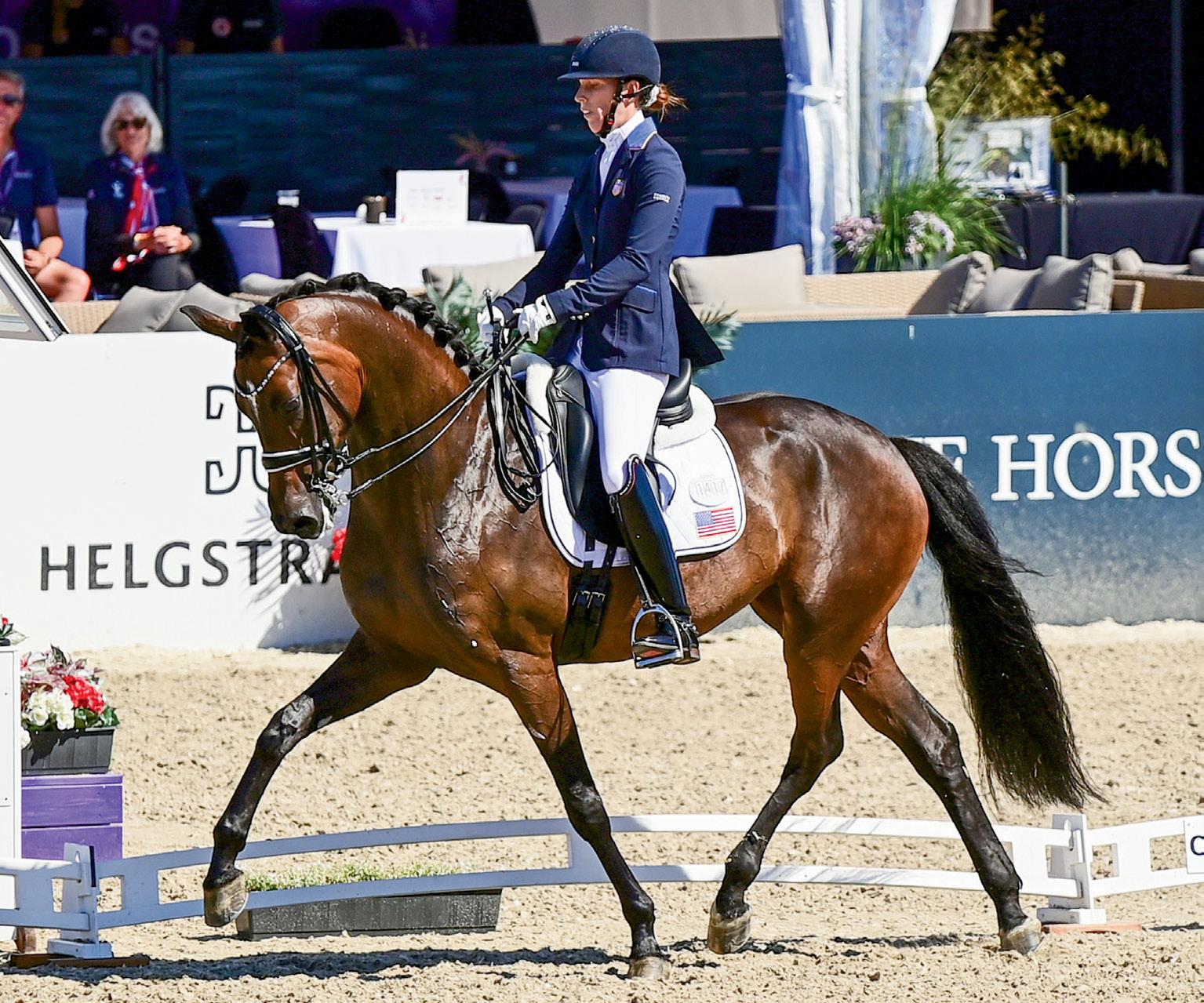
When Shoemaker’s US-based coach, Lehua Custer, told her the freestyle score, the rider was in disbelief.
“Lehua casually said something like, ‘You got an 80.’ My response was, ‘From one judge or overall?’” Shoemaker said afterward. “I knew I needed 79% or higher to be guar anteed a medal, as there were only two riders left to go….It was a very special moment, and to finish silver was icing on the cake!”
Custer not only is Shoemaker’s coach; she’s also the owner of For
tunato H2O, Roxanne Trunnell’s mount for Herning 2022. It’s an improbable pairing: “Tuna” is only six years old; he’s an active breeding stallion who had never been a paradressage mount; and Trunnell has been riding him only since February, with limited training time in the lead-up to the World Champion ships because of Tuna’s breeding schedule. But when it’s right, it’s right, and Trunnell felt an immedi ate connection with the handsome chestnut, telling reporters that he felt similar to Dolton, her 2020 Paralympic mount, with whom she held the FEI world number-one pa ra-dressage ranking for 26 months. With Dolton, Trunnell had won Grade I Individual and Freestyle gold in Tokyo, breaking many score records along the way.
As a result, “I felt oddly calm about taking such a young stal lion into a World Championship venue—something that was poten tially very scary for a young horse,” Trunnell said. “The reason I believe Dolton performs as well as he does
58 November/December 2022 | USDF CONNECTION ALLEN
MACMILLAN/MACMILLAN
PHOTOGRAPHY; JENNIFER BRYANT
DOUBLE MEDALIST: Kate Shoemaker on Quiana won Grade IV Freestyle silver as well as team bronze
IN SYNC: Grade I athlete Roxanne Trunnell and her newest partner, the six-year-old stallion Fortunato H2O
Team Medals Gold Netherlands 230.225 Silver Denmark 229.751 Bronze USA ....................................... 225.335 G S B
is because of that connection that I have created with him. I had hoped that Tuna would respond the same way and that he wouldn’t let the atmosphere affect him if I was com municating to him that everything was fine.”
In the BB Horse Arena at the MCH Messecenter event complex in Herning, “Tuna never took a wrong step,” Trunnell said. “It was like he was saying, ‘Check out how hand some I am! I totally got this show.’ It definitely helped calm my nerves about doing this show with him!” she added with a smile.
Trunnell noted that Tuna proved himself more than capable of producing the scores needed to be an international para-dressage contender. “Tuna, in my opinion, is going to be a major superstar in the para-dressage world,” she said.
Before a virus put her into a coma and caused brain swelling, which ultimately landed her in a wheelchair, Trunnell, a native of Washington state, competed in able-bodied dressage and earned her USDF bronze medal and was well on her way to her silver. She holds a master’s in psychology with a focus in equine-assisted psychothera py. She is a two-time Paralympian and a veteran of two WEGs.
On to Paris
“When I started with the US,” said Michel Assouline, “they were num ber eleven on the world stage.” He pointed with pride to the USA’s as cent in international para-dressage competition, and especially to the team’s bronze medal in Herning, which he said “proved that [the team bronze in] Tokyo was not just a fluke.”
Outgoing USEF director of sport Will Connell noted, however, that
Kristi Wysocki: Impressions from the Judge’s Box
Both dressage and para-dressage have risen in quality since the 2018 FEI World Equestrian Games in North Carolina, but para-dressage has “moved to a new stratosphere,” according to FEI 5* para-dressage judge Kristi Wysocki.
Wysocki, of Coupeville, Washington, was a member of the para-dressage ground jury at the Ecco FEI World Equestrian Games Herning 2022. Postcompetition, she shared her thoughts with USDF Connection in an exclusive interview.

“Some of the riders who really struggled four years ago have improved their scores by as much as ten percentage points,” Wysocki said. “All the riders have pushed themselves and are excelling at levels I’m not sure some of them have even imagined before now.”
In Herning, Wysocki said, she was struck by what she called “true sport”: a new level of camaraderie among all of the athletes, not just within teams. And the harmony between the para-dressage horses and their riders, she said, was almost palpable: “The rider almost just thinks the next step, and the horse is right there for them. There were moments that literally took your breath away, and as a judge there is nothing that can beat that.”
the bronze-medal score in Hern ing was higher than that required to medal in Tokyo just one year ago, which “demonstrated that the standard of competition continues to grow, and we must keep pace with that…. Our top athletes need to campaign in Europe in 2023, and we need to grow the sport from grass roots up through the pathway. There is much work to be done.”
“I think para-dressage is catching the attention of the world,” said US FEI 5* para-dressage judge Kristi
Online Extra
For complete results, additional photos, and more from Herning, go to YourDressage.org
Wysocki, who was a member of the ground jury in Herning. “There haven’t been a lot of sponsorships or owners reaching out to help these athletes, but that is changing…. Top dressage trainers are starting to get involved, too. The next few years are just going to be amazing.”
Photojournalist Kim MacMillan and her husband, photographer Allen MacMillan, own and operate Loon Creek Enterprises, an 84-acre equine breeding facility and grain farm in northeastern Indiana.
USDF CONNECTION | November/December 2022 59
COURTESY OF KRISTI WYSOCKI
AT THE OFFICE: US para-dressage judge Kristi Wysocki in Herning, Denmark
NAYC Dressage Returns to Michigan
 BY ANDREW RYBACK
BY ANDREW RYBACK
Top North American youth competitors vie for prestigious medals PHOTOGRAPHS
PHOTOGRAPHY
YOUNG RIDER TEAM MEDALISTS: Regions 3/9 (gold), Region 7 (silver), and Regions 6/8 (bronze) 60 November/December 2022 | USDF CONNECTION
he 2022 FEI North American Youth Championships (NAYC) in dressage took place August 9-14 at the Great Lakes Equestrian Festival grounds, Flintfields Horse Park, in Traverse City, Michigan.

The NAYC is the only Fédération Equestre Inter nationale (FEI) championships held annually on the North American continent. In dressage, youth aged 14 through 21 compete in Junior and Young Rider divisions for team, individual, and freestyle medals. Qualifying to represent their country at the NAYC is for many young dressage competitors the pinnacle of their equestrian careers before they graduate to the adult ranks. Learn
more about the qualifying process under the Youth tab on the USDF website, usdf.org.
The USDF salutes the riders, ages 14 to 21, who rep resented the United States in the USDF North Ameri can Youth Dressage Championships at the 2022 NAYC: Region 1 Juniors: Emily Bansky/Vincento, Lucinda Donaldson/Audi, Lucas Garvey/Everest, Franki Kesner/ Il Divo, with alternates Taiwan Parrish/Saracchi Region
Young Rider: Quinn Ridgway/Dramatika V Region
Juniors: Allison Berger/Bellini, Kayley Knoll man/JP Zeppelin, Nicole Lang/Jagger DG, Abigail Taft/ Innsbruck SSH, with alternates Emma Hannon/Zenith Interagro
Young Riders: Alicia Berger/Floriano
1
2
Region 2
HB, Julia McDonald/Lehndorff van de Vogelzang Region 3 Juniors: Emma Stephens/De Nouvelle Vie, Madison Sumner/Briar Region 3 Young Riders: Mary Claire Piller/Oreo, So phia Schults/Conocido HGF Region 4 Juniors: Ella Fruchterman/Holts Le’Mans, Kylee Kment/Honor, Lexie Kment/Montagny von der Heide Region 4 Young Riders: Averi Allen/Superman, Bianca Schmidt/CK Sir Shimmi Region 5 Juniors: Audrey Allen/Hugo Boss, McKenzie Miller/Gallardo SW, Katherine Nayak/Gaspacho, Kali Riddell/#Hashtag Region 5 Young Riders: Elizabeth Petersen/Captain Brownie, Olivia Williams/Ronaldo Region 6 Young Rider: Jessica Beck/Elewaard Region 7 Juniors: Emme Chisholm/Improv, Maggie Elizabeth Evans/Fuengirola, Josephine Hinnemann/ Copa Cabana MRF, Anna Yost/Irieno-S Region 7 Young Riders: Lily-Rose Bacon/Warm Night, Lucienne Bacon/Do Re Mi, Ellanor Boehning/Sir Ju nior, Erin Nichols/Handsome Rob AR Region 8 Juniors: Leah Drew/Jazzbeat, Gabriel Ep stein/Bandito, Emily Jackowski/Havanna 133, Quentin Sloan/Finn, with alternates Leah Drew/Harmonious P Region 8 Young Riders: Brenna Donovan/Scandal LWF, Gemma Starn/Diamond First Choice, Megan Tursi/So Speciale Edition Region 9 Junior: Zainab Shah/Dr. Schiwago 9 Region 9 Young Riders: Sydney Lipar/Zerragamo, Sydney Schultz/Dunkirk. T USDF CONNECTION | November/December 2022 61
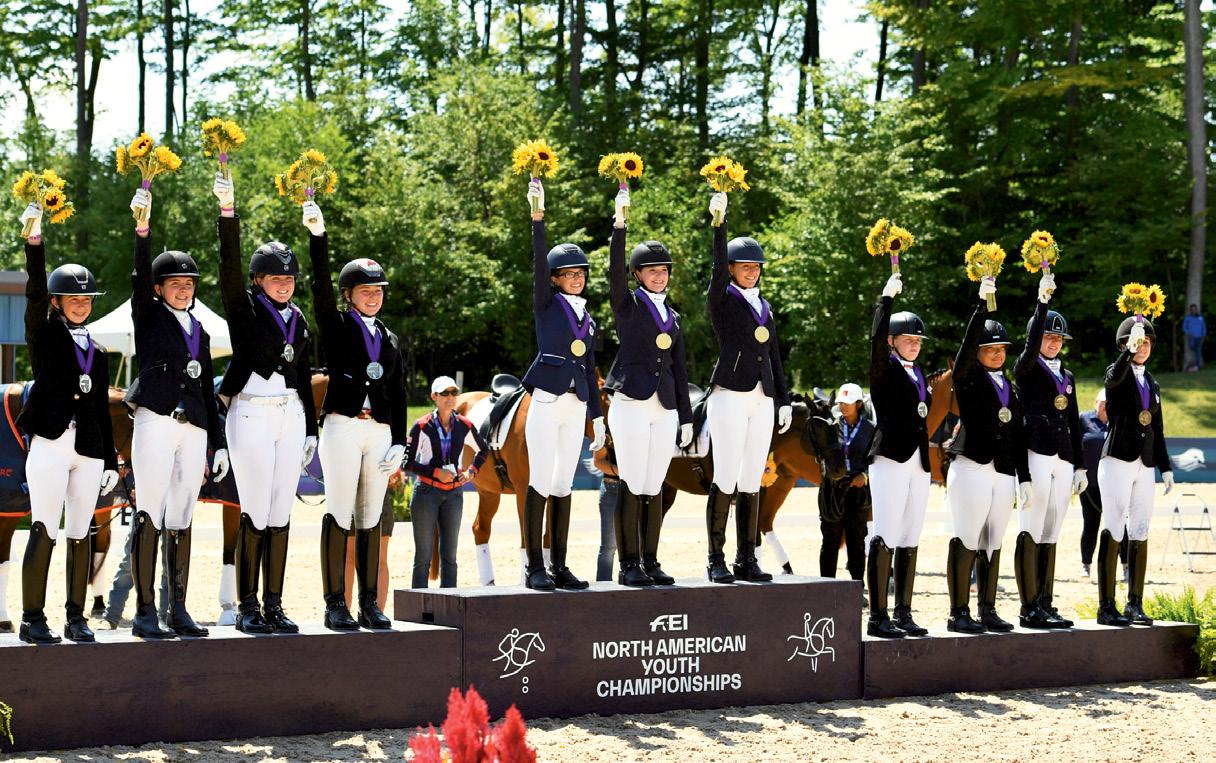
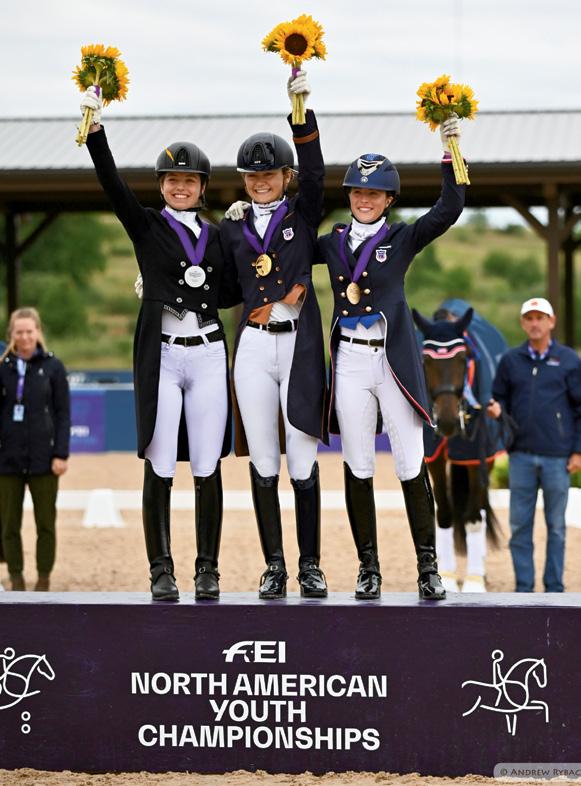

Results Young Rider Team Gold: Regions 3/9 Sophia Schults/Conocido HGF 67.647 Sydney Lipar/Zerragamo ........................................ 67.265 Sydney Schultz/Dunkirk.......................................... 64.441 Mary Claire Piller/Oreo ........................................ (62.265) TEAM TOTAL 199.353 Silver: Region 7 Erin Nichols/Handsome Rob AR 70.147 Ellanor Boehning/Sir Junior 65.088 Lucienne Bacon/Do Re Mi ..................................... 63.383 Lily-Rose Bacon/Warm Night .............................. (61.735) TEAM TOTAL 198.618 Bronze: Regions 6/8 Gemma Starn/Diamond First Choice .................... 66.971 Megan Tursi/So Speciale Edition 66.853 Brenna Donovan/Scandal LWF ............................. 63.735 Jessica Beck/Elewaard .......................................... (59.529) TEAM TOTAL .........................................................197.559 Young Rider Individual Gold Erin Nichols/Handsome Rob AR (Region 7)....... 69.000 Silver Gemma Starn/Diamond First Choice (Region 8).... 68.206 Bronze Ellanor Boehning/Sir Junior (Region 7) ................ 67.117 Young Rider Freestyle Gold Erin Nichols/Handsome Rob AR (Region 7) 74.465 Silver Ellanor Boehning/Sir Junior (Region 7) 72.545 Bronze Sophia Schults/Conocido HGF (Region 3) ........... 70.925 Junior Team Gold: Region 4 Kylee Kment/Honor 69.364 Ella Fruchterman/Holts Le’Mans 69.303 Lexie Kment/Montagny von der Heide .................. 67.121 TEAM TOTAL ........................................................205.788 Silver: Canada Anna Swackhammer/Fabienna GV....................... 69.242 Alison Campbell-Wright/Slapstick ....................... 66.394 Kiara Williams-Brown/Herdeiro Santana 64.000 Olivia Tomljenovic/Valkira .................................. (63.333) TEAM TOTAL ........................................................ 199.636 Bronze: Region 7 Maggie Elizabeth Evans/Fuengirola .......................67.727 Anna Yost/Irieno-S .................................................. 66.636 Josephine Hinnemann/Copa Cabana MRF .......... 64.818 Emme Chisholm/Improv (63.030) TEAM TOTAL ......................................................... 199.181 Junior Individual Gold Ella Fruchterman/Holts Le’Mans (Region 4) ...... 69.294 Silver Anna Swackhammer/Fabienna GV (Canada) ..... 69.029 Bronze Kylee Kment/Honor (Region 4) 68.971 Junior Freestyle Gold Ella Fruchterman/Holts Le’Mans (Region 4) ...... 72.300 Silver Madison Sumner/Briar (Region 3) ......................... 71.515 Bronze Lexie Kment/Montagny von der Heide (Region 4)71.385 Congratulations to our talented youth! JUNIOR TEAM MEDALISTS: Region 4 (gold), Canada (silver), and Region 7 (bronze) YOUNG RIDER INDIVIDUAL MEDALISTS: Erin Nichols (gold), Gemma Starn (silver), and Ellanor Boehning (bronze) JUNIOR FREESTYLE MEDALISTS: Ella Fruchterman (gold), Madison Sumner (silver), and Lexie Kment (bronze) 62 November/December 2022 | USDF CONNECTION
Special Awards
Six awards presented at the 2021 FEI North American Youth Championships (NAYC) recognized special excel lence in the dressage division, both in and out of the saddle and by volunteers as well as competitors.
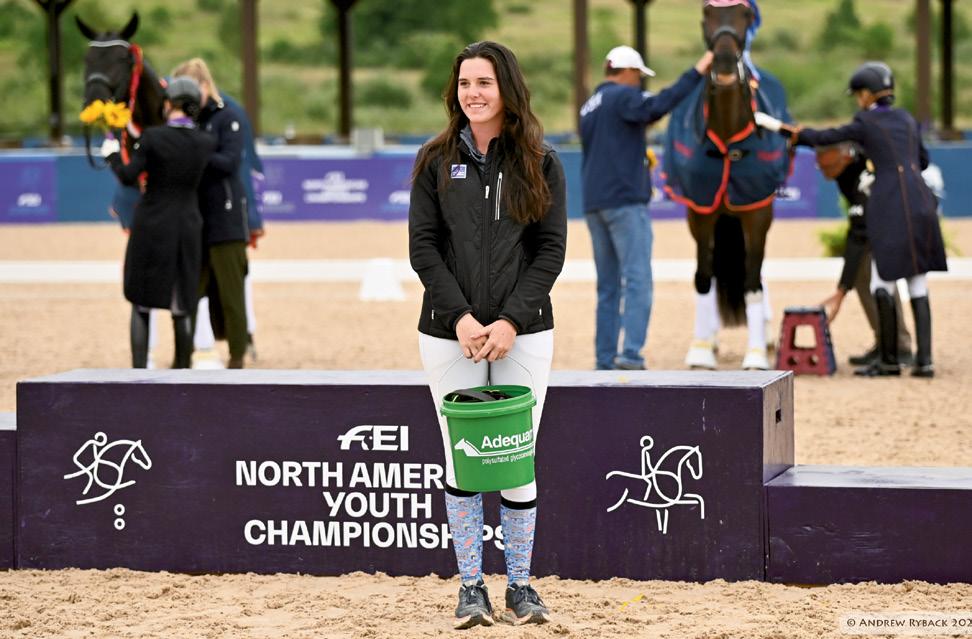
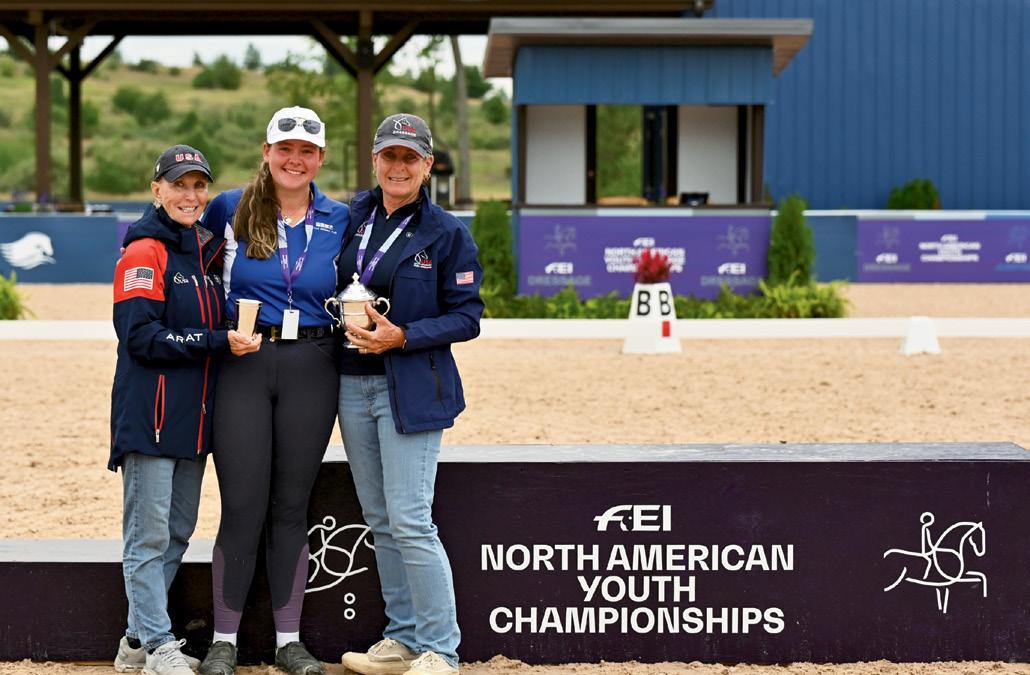
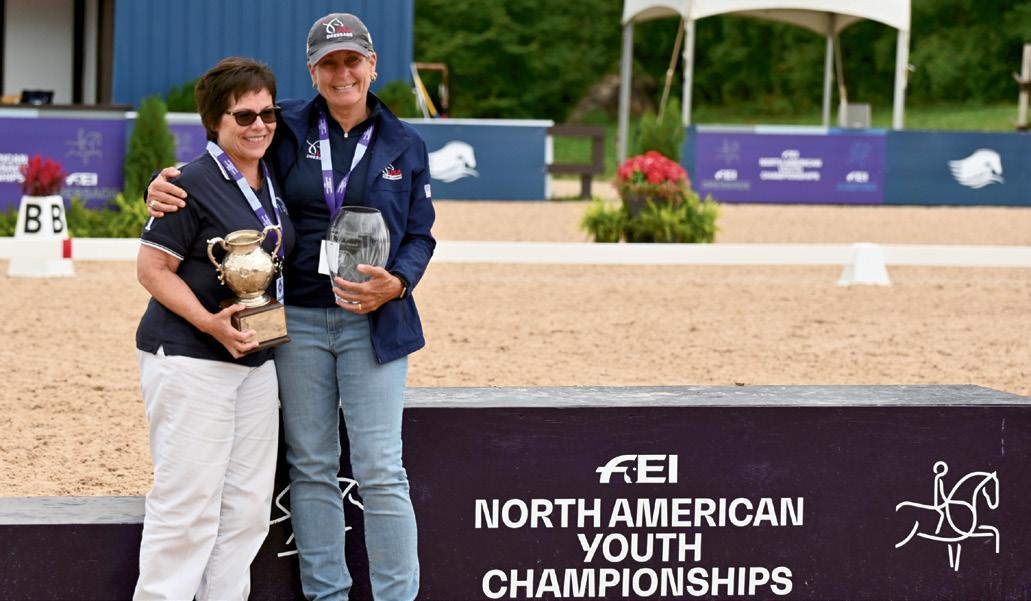
JUNIOR EXCELLENCE: USDF FEI Youth Committee chair Roberta Williams presents the Amanda Johnson “Pursuit of Excellence” Memorial Trophy to Region 4 Junior Ella Fruchterman. The award goes to the Junior rider who earns the highest combined average score in the three dressage tests.



OUTSTANDING YOUNG RIDER: Roberta Williams presents the Fiona Baan “Pursuit of Excellence” Memorial Trophy to Region 7’s Erin Nichols, as the Young Rider with the highest combined average score in the three dressage tests. The late Fiona Baan worked for the US Equestrian Team for nearly 30 years and was the US dressage team leader for the 1976 Olympics, the 1987 Pan Am Games, and the 1992 Olympics.
TEAM SPIRIT: Roberta Williams (right) presents the Albers Award perpetual trophy to Region 1 chef d’équipe Debbie DelGiorno. Named in memory of longtime Region 1 chef the late Patsy Albers, the award is presented annually to the dressage chef who best demonstrates the same level of dedication, enthusiasm, and team spirit shown by Albers over the years.
SPORTSMANSHIP: Region 5’s Elizabeth Petersen (center) accepts the Captain Andrew B. de Szinay Memorial Sportsman Trophy as the Young Rider demonstrating good sportsmanship, team spirit, and honor. Presenting were USEF national dressage youth-coach representative Betsy Steiner (left) and USDF FEI Youth Committee chair Roberta Williams.
SPOTLESS: For her efforts in (among others) keeping all that white on the pinto Percheron cross, Oreo, sparkling clean, Region 3 Young Rider Mary Claire Piller received the Best Turned Out award
CLASS ACT: Region 3 Junior Madison Sumner receives the Dressage Style Award from USEF national dressage youth-coach representative Betsy Steiner
USDF CONNECTION | November/December 2022 63
Leg Protection for the Dressage Horse
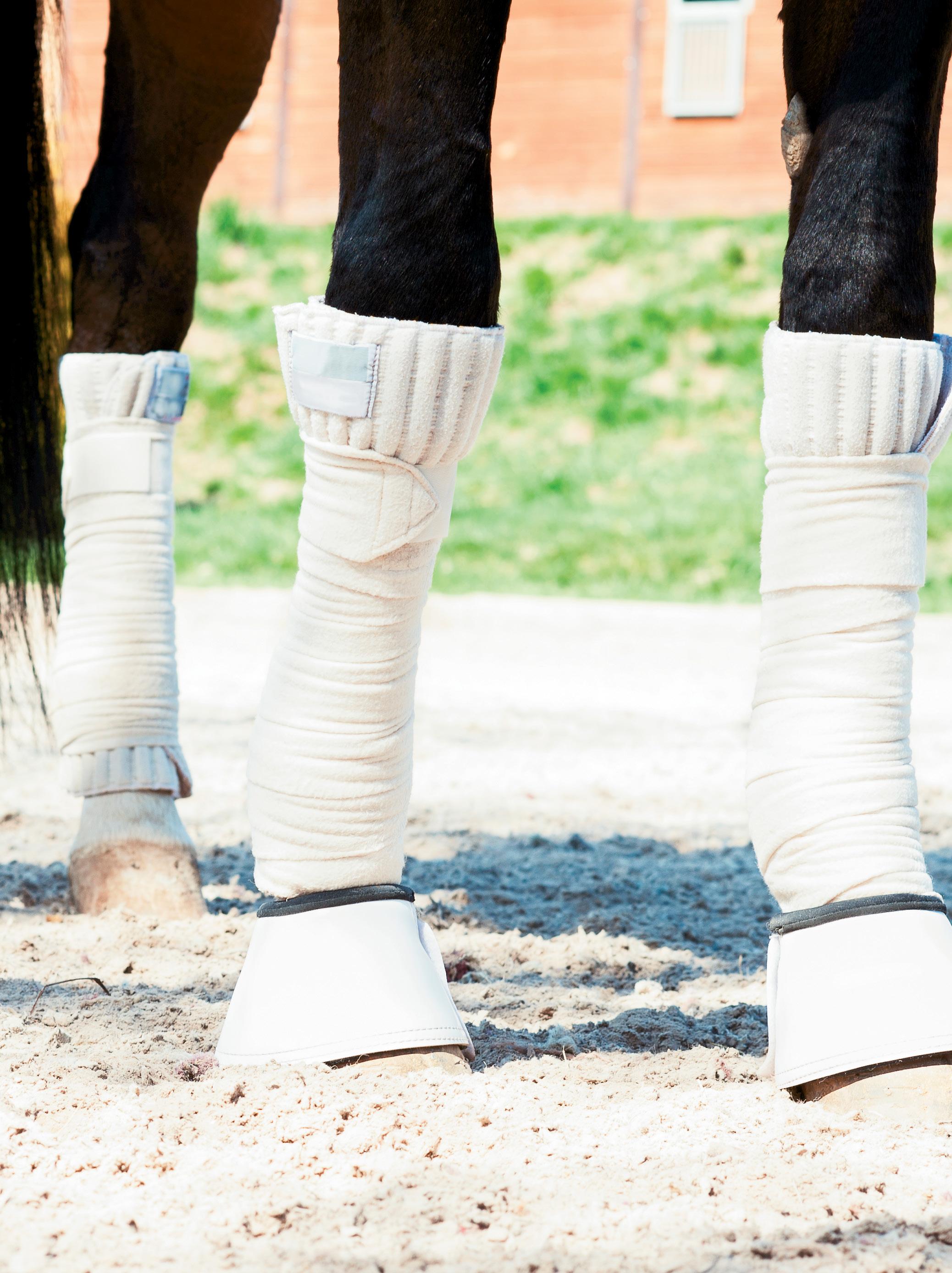
Do boots and wraps help or hinder? Experts weigh in.
BY KATIE NAVARRA
DRESSAGE AESTHETIC: Classic white looks elegant on most horses and accentuates leg movement (handy in training). This horse wears white polo wraps and bell boots; beneath the polos are added wraps designed to offer extra protection and breathability.
SHUTTERSTOCK
64 November/December 2022 | USDF CONNECTION
orses seem to relish any op portunity to hurt themselves, so naturally most owners and riders want to protect them as much as possible. And in a sport in which any compromised way of going is penal ized, there’s added incentive to bubble-wrap our equine partners, especially those precious legs and feet.
Visit any dressage barn or show and you’ll see horses sporting a variety of leg and hoof boots and bandages. Some mounts are swaddled in thick layers of wraps ex tending from below the fetlock to above the knee.

What’s best for your horse? Do boots and wraps (which are not allowed in the show ring, by the way) protect and support the tendons and ligaments, or can they do more harm than good? For guidance, we turned to a sport-horse veterinarian and three experienced dressage pros.
Practical Matters
In considering the options, “you’re not jumping them, so they don’t need that level of support, but you don’t want them to clip themselves from behind,” says Margaret “Meg” Mullin, VMD, a sports-medicine clinician at B. W. Furlong and Associates, Oldwick, New Jersey, who has been the US Equestrian Team veterinarian for various disciplines, including dressage, and who was the US para-dressage team vet at the 2022 FEI World Champi onships in Denmark. “It’s about protecting their limbs from the exuberant movement of the other legs while they’re schooling so that they don’t get cuts and nicks while they’re warming up.”
The choice of leg protection ultimately is a matter of personal preference, says Mullin, who advises consider ing the intended activity and how your horse moves. Convenience and ease of application also play a role, as do materials and environmental conditions. Let’s run down the pros and cons of the most popular options.
Bell boots, so named for their shape, protect hooves and sensitive heels against strikes and interference. They’re typically used on front feet to guard against shoe pulls and cuts caused by getting clipped by a hind foot (during training, in turnout, or both).
Bell boots may be constructed of leather, rubber, or syn thetic materials. Many come in a rainbow of colors. Some contain a layer of shock-absorbing material to cushion blows or have fleece-lined cuffs to guard against rubs. Most bell boots sold today fasten with single or double layers of hook-and-loop material for easy on and off.
There aren’t too many cons to using bell boots—al though some trainers don’t like them, as you’ll learn in
a minute. Some experts advise doing without bell boots (and leg boots, as well) if riding or turning out in snow because snow can become trapped under boots and potentially cause frostbite.
Leg boots are perennial favorites for leg protec tion because they’re easy to apply and remove thanks to hook-and-loop fastening strips, which have largely replaced the buckles and leather straps of yesteryear. Available in an array of heights, materials, styles, and designs, leg boots range from pliable, mildly protective designs to models with molded, rigid outsides intended to protect fetlocks, cannon and splint-bone areas, or both. Models may be unlined or fleece-lined.
The down side to using leg boots is that they can trap dirt, sand, or moisture next to the horse’s skin and cause rubs or skin irritation, so they ideally should be cleaned and dried after each use. A horse’s skin may be sensitive to the boot material, requiring some trial and error to find what works.
Exercise bandages go on like stable bandages but are made from materials designed to stay put during exercise. The classic dressage silhouette is four white fleece leg bandages, known as polo wraps, which fasten with hook-and-loop strips. “Polos” come in nearly end less colors, many designed to coordinate with matching saddle pads or ear bonnets. There are also exercise ban dages made from elastic material with silicone added for grip, which are designed to offer firm support, to stay put, and to absorb very little water. Bandages offer some protection but typically not as much as a tough, reinforced boot.
Because bandages fit more snugly than boots, they’re less likely to trap footing next to horses’ legs. They’re trickier to apply, however, and users must learn how to wrap them correctly so that they stay in place without slipping yet aren’t so tight they could injure a tendon. Some people consider them too time- and labor-inten sive, what with the required application, laundering, and rerolling before each use.
Like leg boots, exercise bandages need to be kept clean and dry. Polo wraps get sodden and heavy in wet conditions. No bandage is generally considered a safe option for turnout because of the risk that the bandage could slip or come unfastened, leading to the possibility of entanglement or injury.
Trainers’ Choices
For FEI-level trainer/competitor and retired USEF “R” dressage judge Laurie Falvo, using leg boots is about
USDF CONNECTION | November/December 2022 65
H
BOOTED UP: Many horses do just fine in simple leg protection, or even none at all. This horse sports basic leg boots lined with fleece for protection against rubs, and matching bell boots with fleece tops.
creating a barrier so a horse doesn’t bang himself while learning lateral work. Falvo, of Encinitas, California, favors schooling in fleece-lined gal loping boots secured with hook-andloop closures, on all four legs. She does not, however, use bell boots.
“I don’t do bell boots, and I don’t like medicinal boots [aka “sportsmedicine boots”—traditionally, a wrap-style neoprene boot with a fetlock “sling” strap] unless I have a horse coming back from an injury,” Falvo says. “I feel like medicinal boots provide too much support, and horses’ tendons and ligaments rely on those. So when you take them off for a show, I feel it sets them up for an injury.”
Some of Falvo’s clients use bell boots, but the trainer herself prefers going without, saying that horses need to “figure it out a bit.”
“If a horse is banging himself all the time, it increases the risk for injury when they are removed to show,” she says, citing an example
of a Grand Prix horse whose owner requested that leg and and bell boots be used for every ride. At a show, with the leg protection removed after warmup, the horse became unsound during the test and Falvo had to excuse herself.

“Sometimes I think it is too much protection,” Falvo says. “I put bell boots on in a stall until the horse figures out how not to rip his shoes off if they’re figuring their feet out. But for me, if they’re pulling their shoes, it is mainly because they are on their forehand. That is a shoeing and balance issue; you’ve got to talk to your shoer and get them up off their forehand.”
Brother and sister USDFcertified instructor/trainers Adam Gershberg and Emily Wyman take an individualized approach at their Apple Hill Farm, Hudson, New York. One of Gershberg’s current upper-level horses has no particular movement issues, so he trains in simple galloping boots all around plus bell boots in front.
“When you have a horse with good conformation that does not tend to interfere or knock and is a good, straight-moving horse, they are fine with minimal protection,” says Gershberg. “These horses don’t need the support of a polo, and a boot is plenty when you’re doing lateral work where they might knock themselves.”
When Gershberg rides a horse with a history of leg injuries, he uses polo wraps instead—typically on the front legs only. But even then, it depends on the horse.
“We use galloping boots most of ten because we work a lot of horses every day, and boots are a lot faster as long as horses have no problems. Boots expedite getting the horses worked,” Gershberg explains. “But if
we need polos, we use those instead. We have one horse that wears polos all around because of problems in hind and front, and he’s still going.”
Horses at Apple Hill may wear bell boots in turnout or during lungeing or riding, but Gershberg says that “for every positive, there is always a little negative. For example, some horses get a fungus or a little rub under bell boots. So you might need to give them a break from bell boots and use something for killing the bacteria.”
US 2019 Pan American Games team member Endel Ots uses leg protection on his horses, but the self-described science guy says he hasn’t seen research-backed evi dence that any wrap or boot actually protects and supports the soft-tissue structures inside the leg.
Instead, “I think of it like when I go to the gym,” says Ots, of Wel lington, Florida. “I put certain wraps on my wrist when bench-pressing or doing Arnold presses because I want to support the wrists, not so much the tendons.”
For basic protection, Ots uses traditional leg boots.
“I’m old-fashioned—a kind of classic guy,” he says, “so I am a big fan of the glossy white ones with the fleece inside. I like white because it helps me see the horse’s rhythm in their legs so I can see how they are moving.”
Ots finds using one simple, clas sic style works well, in terms of both time and cost efficiency. He must be doing something right: “We just don’t have tendon problems in our barn,” he says.
“If a horse needs a special boot, it is no problem, we get it; but I find the simplest answers are the best,” he says. “I think people often make things too complicated.”
66 November/December 2022 | USDF CONNECTION
SHUTTERSTOCK
The Science of Leg Protection
Ots is correct: There aren’t a lot of data to back up claims that boots and wraps support horses’ tendons and ligaments during exercise.
The subject has been studied, but not extensively. In a 2015 Eurodressage.com article, Belgian veterinarian and equine-surgery specialist Maarten Oosterlinck pos ited that scientific evidence of boots’ and wraps’ ability to protect and support the lower leg and protect against trauma is limited. His article highlighted a 2004 study (Kicker et al.) that found that support boots reduced fetlock extension by about 1 degree at the walk and the trot. Oosterlinck countered, however, that the findings were limited to one particular type of boot, a tendonsupport boot, and that it is unknown whether the reduction in fetlock extension is significant enough to prevent injury.
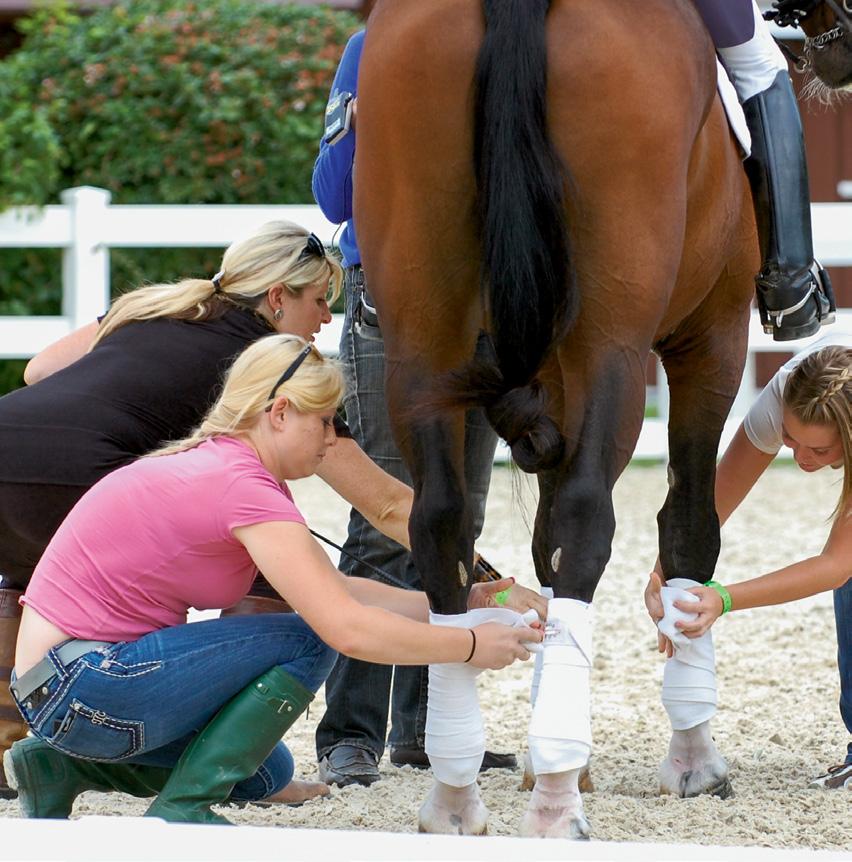
Another aspect of boot and wrap use that has come under scrutiny in recent years is that of associated heat buildup in the legs and possible resulting detrimental effects on the soft-tissue structures.
Any next-to-skin material traps heat. But that warmth may not be good for the soft tissues in a horse’s lower legs: As reported in The Horse: Your Guide to Equine Health Care, a 2021 study found that leg protection increases the leg temperature, which in turn can harm the superficial digital flexor tendon (SDFT).
Led by graduate student Luke Brock, a team of researchers from Middle Tennessee State University found that boots and wraps can interfere with the SDFT’s ability to cool the limb. Boots and wraps act as insulators and trap heat that a
bare limb naturally dissipates. The amount of heating, the researchers found, depends on various factors, including the materials and design of the boot or wrap, the intensity of the exercise session, and the ambi ent heat and humidity levels.
Of the six types of leg protection tested—traditional neoprene boots, perforated neoprene boots, plantbased neoprene boots, cross-country (galloping) boots, elastic track ban dages, and fleece polo wraps—polo wraps created the most significant heat buildup, the study found.
But before you toss your boots and wraps, know that some warmth may be OK. As veterinarian Meg Mullin sees it, increased body heat is a natural part of the exercise pro cess, and letting the legs warm up before intense work can be helpful.
“When riding, you don’t want the leg to be overly cold; we want blood flow,” she says. “So it’s not bad to have it get a little warm. Once you take them off, the heat goes down. A few minutes after taking them off, the heat is gone.”
To that end, some trainers make a point of booting or wrapping legs in cold temperatures, to help warm tendons and ligaments before and during riding. Others take steps to cool legs post-exercise.
“Polos get hot, but even the sheepskin boots that I use can get hot,” says Falvo. “I ice my horses after every ride, so hopefully it is counteracting the heat created.”
That’s a Wrap
Our dressage experts agree that sparkling white polo wraps provide a polished look and often opt for them in clinics, photo shoots, and award ceremonies. White polos, like Ots’s preferred white leg boots, accentuate the horse’s leg movement
WRAP IT UP: Applied correctly, polo wraps offer some protection, and white ones are classic in dressage. But boots and bandages aren’t permitted in the show ring, so these grooms are stripping off the polos at the end of the competitor’s warmup.
and create that classic dressage aesthetic. Just make sure you know how to apply them correctly.
“Wraps are like Goldilocks,” says Mullin. “They have to be just so; too loose or too tight can cause an issue. So that’s why some people prefer a boot—because they can’t be put on too tight. Using wraps is something you have to learn the feel, but it is not hard to learn how to put on a polo wrap well.”
Ultimately, “It doesn’t mean you’re taking better care of your horse if you’re using polos over boots,” says Gershberg. “If you have the time and like polos, great. For us, the boots work just fine for a lot of the horses.”
Katie Navarra is an award-winning writer and certified leadership coach who partners with horses to help indi viduals, business owners, and leaders amplify their professional growth through life-changing experiences.
USDF CONNECTION | November/December 2022 67
JENNIFER BRYANT












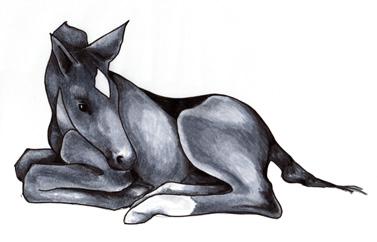



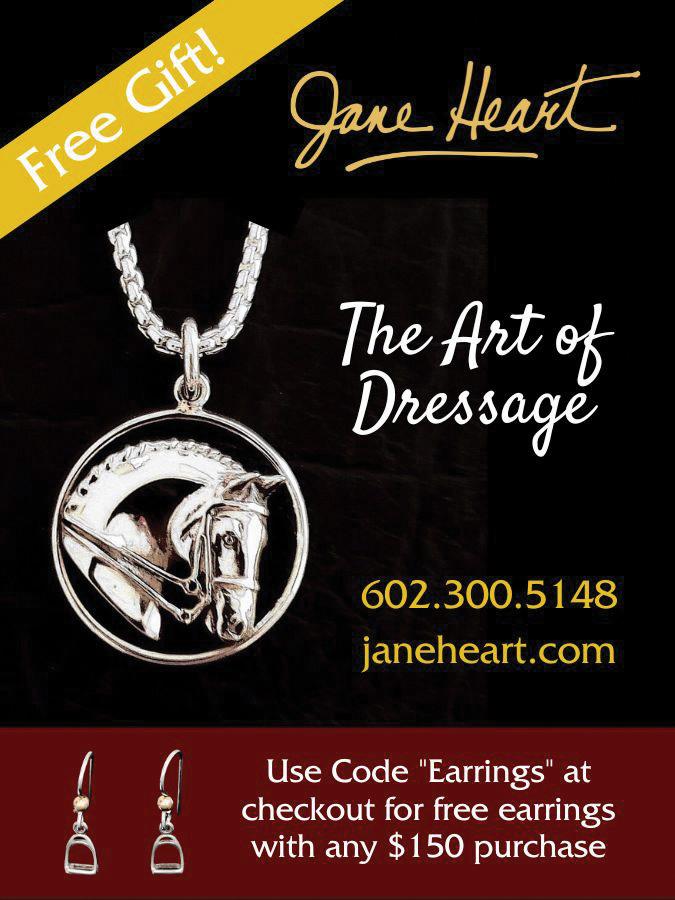

68 November/December 2022 | USDF CONNECTION RIDER'S MARKET APPAREL & ACCESORIES HORSE BEDDING BREED REGISTRY BREED REGISTRY HORSE HEALTH EDUCATION EDUCATIONDRESSAGE TESTS T aylor S elec T H or S e B edding S elect the B e S t 815.601.3002 www.taylorselect.com call / text / email SHIPPING NATIONWIDE Mention this ad and receive $100 off of your first semi load LARGE FLAKE l BLENDED FLAKE MINI FLAKE l PINE PELLETS CHOPPED STRAW ART & DESIGN PHOTOGRAPHY SALE HORSES HORSE BEDDING JEWELRY SALE HORSES EDUCATION
The Ipos Rein Sensors measure rein tension on the left and right side, giving equestrians insights to improve performance.
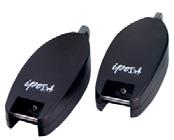
Achieve lightness and symmetry with the Ipos Rein Sensors, and quantify the ‘equestrian feel’!
Demos and more info about the FREE Online Coaches Course available on our website
USDF 2023 Member Perks Partners
DressageClinic.com
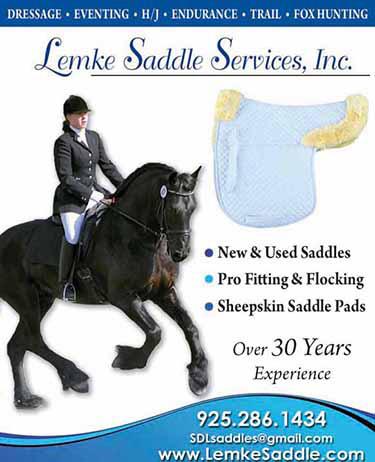
Educational videos from the top dressage trainers around the globe. 50% discount on membership
Dressage Extensions

Luxury dressage boutique certain to delight the most discerning of dressage enthusiasts.
$100 worth of free product by receiving a $50 member card two times per year

Dressage Today OnDemand
Dressage training video library with training advice and tips from the world’s most respected judges and trainers. 45% discount on membership video.dressagetodayonline.com


Horses 4 Your Consideration
The Sport Horse Marketplace for listing your horses, finding your next equine partner, and posting your equestrian business or products locally and globally.
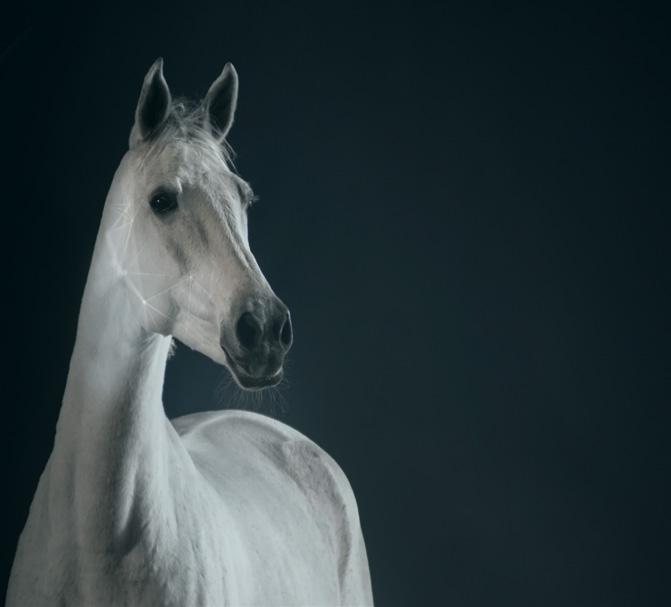
USDF Members receive a 15% discount https://www.horses4yc.com/


Horse & Country
H&C is the leading international equestrian sports network, available globally via connected TVs, mobile, and web and on leading digital and pay-TV platforms.

USDF Members receive a 15% discount on a subscription for H&C’s annual membership, H&C+ https://horseandcountry.tv/en-us/
Premier Equestrian
Full line of exceptional products including dressage arenas, footing, horse jumps, and barn and stable equipment. 5% discount on all Premier Equestrian items www.dressagearena.net
Printastic
Custom banners to fit every business need, budget, and size.
20% off all orders www.printastic.com


USRider
24/7 nationwide roadside assistance for you and your horse. Join USRider with no activation fee for a savings of $29 off the normal new membership rate www.usrider.org
To renew your membership and take advantage of these discounts, visit www.usdf.org/join
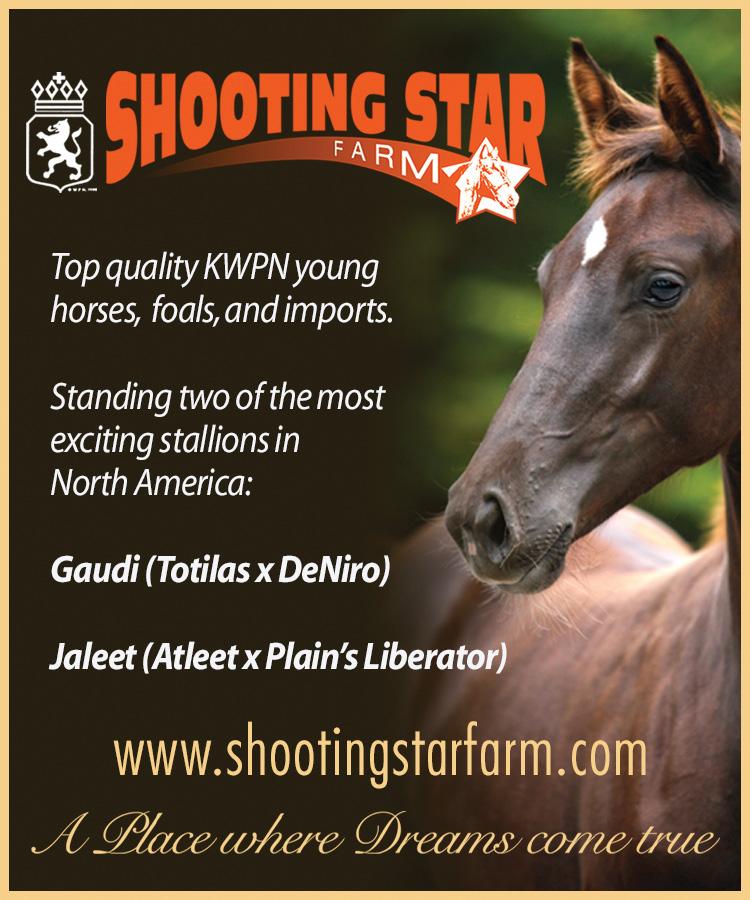
USDF CONNECTION | November/December 2022 69
www ipostechnology com TACKTACK SALE HORSES
Discounts available to 2023 USDF members
USDF OFFICE CONTACT DIRECTORY
Phone: (859) 971-2277, Fax: (859) 971-7722, E-mail: usdressage@usdf.org
Accounting (859) 271-7891 accounting@usdf.org
Address and E-mail Updates (859) 971-2277 changes@usdf.org
Adult Education Programs
All-Breeds Awards
Applications Submitted at Competitions
(859) 271-7894
(859) 971-7361
education@usdf.org
allbreeds@usdf.org
(859) 271-7880........................... affidavits@usdf.org
Breeder Championship Series (859) 271-7878 sporthorse@usdf.org
Demographics and Statistics (859) 271-7083 stats@usdf.org
Donations (859) 971-7826 donate@usdf.org
FEI Youth Clinics (859) 971-7317 jryrclinics@usdf.org
GMO Education Initiative (859) 271-7894 education@usdf.org
Group Membership (859) 971-7048 gmo@usdf.org
Hall of Fame and Lifetime Achievement Awards
Horse Performance Certificates
(859) 271-7873
(859) 971-7361
halloffame@usdf.org
horseperformance@usdf.org
Horse Registration (859) 271-7880 horseregistration@usdf.org
Human Resources/Career Opportunities (859) 271-7885 hr@usdf.org
Instructor Certification (859) 271-7877 instructorcertification@usdf.org
Insurance Certificates for Competitions (859) 271-7886 compins@usdf.org
L Education and Continuing Education (859) 971-7039 lprogram@usdf.org
Licensed Official Education (859)-271-7877 loeducation@usdf.org
Mailing Lists.................................................................................... (859) 971-7038......................... mailinglist@usdf.org
Musical Freestyle
(859) 971-7039..............musicalfreestyle@usdf.org
NAYC Criteria and Procedures (859) 971-7317 nayc@usdf.org
Nominations – Delegates, Regional Directors (859) 271-7897 nominations@usdf.org
Participating and Business Memberships (859) 271-7871 membership@usdf.org
Prize List Questions (859) 271-7896 prizelist@usdf.org
Regional Championships Program (859) 271-7886 regchamps@usdf.org
Rider Awards (859) 971-7361 riderawards@usdf.org
Safe Sport
(859)-271-7894...........................safesport@usdf.org
Score Corrections......................................................................... (859) 271-7895............ scorecorrections@usdf.org
Secretary/Manager Services
(859) 271-7895.................... competitions@usdf.org
Show Results (859) 271-7895 results@usdf.org
Sponsorship Opportunities (859) 271-7887 sponsorship@usdf.org
Sport Horse Education and Programs (859) 271-7894 sporthorse@usdf.org
Store Merchandise (859) 971-7828 merchandise@usdf.org
University Accreditation and Credit Check (859) 271-7894 university@usdf.org

USDFScores.com (859) 271-7878 reports@usdf.org
USEF/USDF Dressage Seat Medal Program & Semi-Finals ...(859)-971-7886....................................... youth@usdf.org
Year-End Awards
(859) 971-7361
Young Rider Graduate Program (859) 971-7317 youth@usdf.org
Youth Education and Programs (859) 971-7317 youth@usdf.org
For specific staff contacts visit the USDF Web site.
CONNECTION
USDF Connection wants YOU to be a contributor. Here’s how.
Air Your Views
USDF Connection welcomes letters to the editor. Please send your digital submission by e-mail to jbryant@ usdf.org. Please include your home town, state, and daytime telephone number. We’ll publish letters as space allows; all submissions are subject to editing. Unsigned letters will not be considered, although writers may re quest that their names be withheld. All letters become the property of USDF.
Ask a Question
Do you have a dressage- or USDFrelated question? Send it to “FAQ” and you may get an expert response in a future issue of USDF Connection.

Send your question, along with your full name, hometown, state, and daytime telephone number to editorial@usdf.org. Include “FAQ” in the subject line of your message.
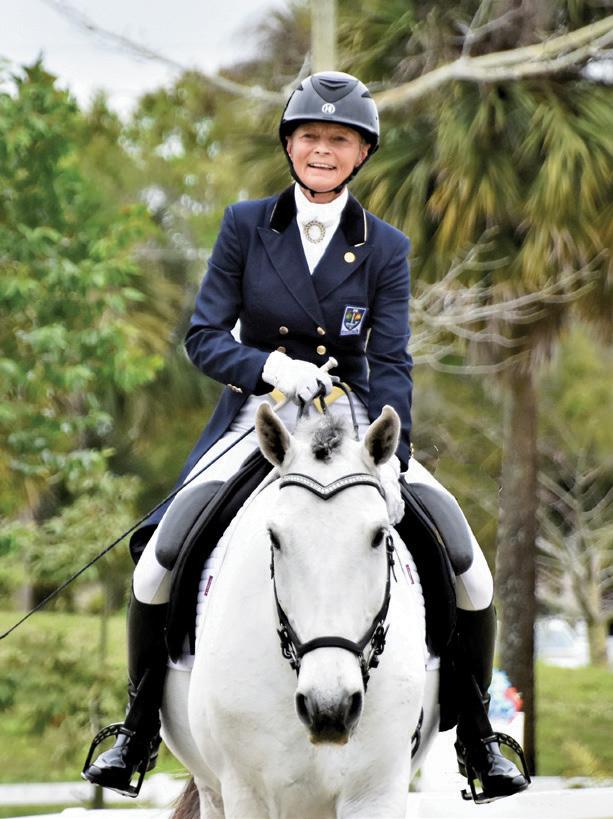
70 November/December 2022 | USDF CONNECTION NONPROFITORG. U.S.Postage PAID Dr. Hilary Clayton on Donzi MC July/August 2021 Official Publication of the United States Dressage Federation FOCUS ON HORSE HEALTH Buyer’s Guide to the Prepurchase Exam (p. 44) Handling GMO Conflict (p. 20) Raise Your Training Standards with Sue Blinks (p. 30) MAKE THE
........................................................
.........................
.......................................................................
............................
................................
.................
........................
...............................................
..........
..........................................................................
.......................................................................................
....................................................
..........................................................................
................................awards@usdf.org
Laboratories,
Warmblood Society
ADVERTISING INDEX
Sporthorse Reg.
Saddles/ Saddlery Brands Intl.
American
Tech
Technology
Jane Heart Jewelry
Performance
Lemke Saddle Services
Group
front cover
Lindinhof Equine Sports Zentrum
Performance
USDF CONNECTION | November/December 2022 71
Auburn
Inc. ............................................... auburnlabs.com ......................................... 17 Arenus arenus.com 5, 9 American
&
...... awssr.org .................................................... 68 Bates
........................... batessaddles.com .......... inside back cover Equine Design .................................................................... stradi.us ...................................................... 68 Great
Insurance
.................................. greatamericaninsurancegroup.com......... 7 Gene
genetechvet.com 1 IPOS
ipostechnology.com 69
........................................................... janeheart.com............................................ 68 Kentucky
Products.................................... kppusa.com..................... inside
.................................................... lemkesaddle.com ...................................... 69
.................................. lindinhof.com ............................................. 68 Platinum
platinumperformance.com back cover Rider Project ....................................................................... theriderproject.org ................................... 68 Shooting Star Farm .......................................................... shootingstarfarm.com .............................. 69 Sox For Horses ................................................................... soxforhorses.com ....................................... 8 Sporthorse Auctions.com ................................................ sporthorseauctions.com .......................... 68 TaylorSelect Horse Bedding taylorselect.com 68 The Dressage Foundation dressagefoundation.org 35 The Dehner Company ...................................................... dehner.com .................................................. 8 United States Lipizzan Federation ................................. uslipizzan.org............................................. 68 World Cup Finals ............................................................... omaha2023.fei.org ................................... 27 USDF Circle of Friends 15 Horse Registration ............................................................................................................................... 41 Member Perks Partners ..................................................................................................................... 69 Membership Renewal .......................................................................................................................... 21 Store Merchandise ........................................................................................................................ 36-37 United States Dressage Federation Official Page USDF Vimeo @USDF @USDFOfficial GET CONNECTED with #USDF YOUR CONNECTION TO DRESSAGE EDUCA TION • COMPETITION • ACHIEVEMENT
My Dressage
(Try to) Keep Calm and Carry On
Robert Dover’s mount got his tongue over the bits— moments before their Olympic Games test, and with a team medal on the line
By Robert Dover
Prior to the 1992 Olympics, I was riding Lectron, a beauti ful black stallion owned by Walter and Mary Anne McPhail and formerly ridden by their daughter, Melinda. Lectron had been hard for her to bring along to the Grand Prix, so it was decided that I would train and compete him for a year or two.

tightened Lectron’s noseband after warm-up, a thing we traditionally did prior to riding a test because he tended to stretch the leather with his strong jaws. The stallion had a nervous twitch that only showed itself when he flexed his head and neck in a certain way, which made him look the most beautiful from the ground but caused him to feel anxious. I yelled up the hill to where our coach, Herbert Rehbein, stood, and asked if I should quickly get off and tighten the noseband myself. Herbert waved and called back that he thought we looked fine as we were, and so off we went to the stadium.
Lectron felt great as we trotted around the outside of the arena. The bell rang, and I made a small circle in front of the stands before enter ing the arena.
best to navigate my horse through the test without mistakes. The prob lem was that pressure on the reins would force the bits upward. Usually they would contact the roof of the horse’s mouth, but in this case, they would have pinched the underside of Lectron’s tongue, with unknown consequences. My only chance was to push my hands forward and try not to touch his mouth at all while guiding him through the test using only my legs and seat.
Lectron began to bloom in his physique and became highly competitive, placing well in the international competitions leading up to the Olympics in Barcelona. We were actually a top-ten favorite as we came to the first day of the Games! Back then, each horseand-rider combination had to go into the “Ten-Minute Ring” before going to the main stadium. In that small space, no one but the rider, not even the horse’s groom, was allowed to touch the horse. With only a minute left before we were due in the Olympic stadium, I remembered that we had not
Just then, Lectron twitched his head, and as he did, his tongue went up and over the two bits of the double bridle, something that he had never done before and could not have happened had I tightened his noseband just one hole more. This was the veritable rider’s nightmare!
My thoughts came rapid-fire: Should I get off and try quickly to put his tongue back under the bits? Should I stop and give him rein and hope he does it himself? Should I excuse myself and walk out of the stadium in disgrace? Should I just forge on and hope for the best?
I chose to hope for the best and rode down the center line with Lectron’s tongue hanging out the right side of his mouth. Michael Poulin and Graf George had already gone, and their score of 62% was not good enough to help the United States to a medal. I had to try my
Lectron was a kind and gentle stallion, and he tried his best to listen to my cues. Other than his tongue being out, which brought down the scores from those judges who could see it, he proceeded to do quite a good test. I left the arena with a heavy heart, feeling I had let down my team, the owners, my horse, and myself. But as luck would have it, my score of 64%, which equaled the score of my teammate Charlotte Bredahl on Monsieur, combined with the 69% score of Carol Lavell on her great horse, Gifted, was enough to give us the bronze medal! Yes, the bar for an Olympic dressage medal was way lower back in 1992, but the lesson I learned was that sometimes when we feel we are failing, we can push on and produce miraculous results, both for ourselves and for others.
Adapted from The Gates to Brilliance by Robert Dover. Used by permission of Trafalgar Square Books, HorseAndRiderBooks.com.
KARL LECK
72 November/December 2022 | USDF CONNECTION
WALKING A TIGHTROPE: With Lectron’s tongue over the bit, Robert Dover dared not touch the reins in his Grand Prix test at the 1992 Olympics
Be as one...the secret to ignite your dressage performance
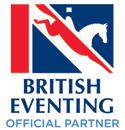
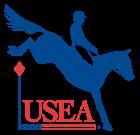



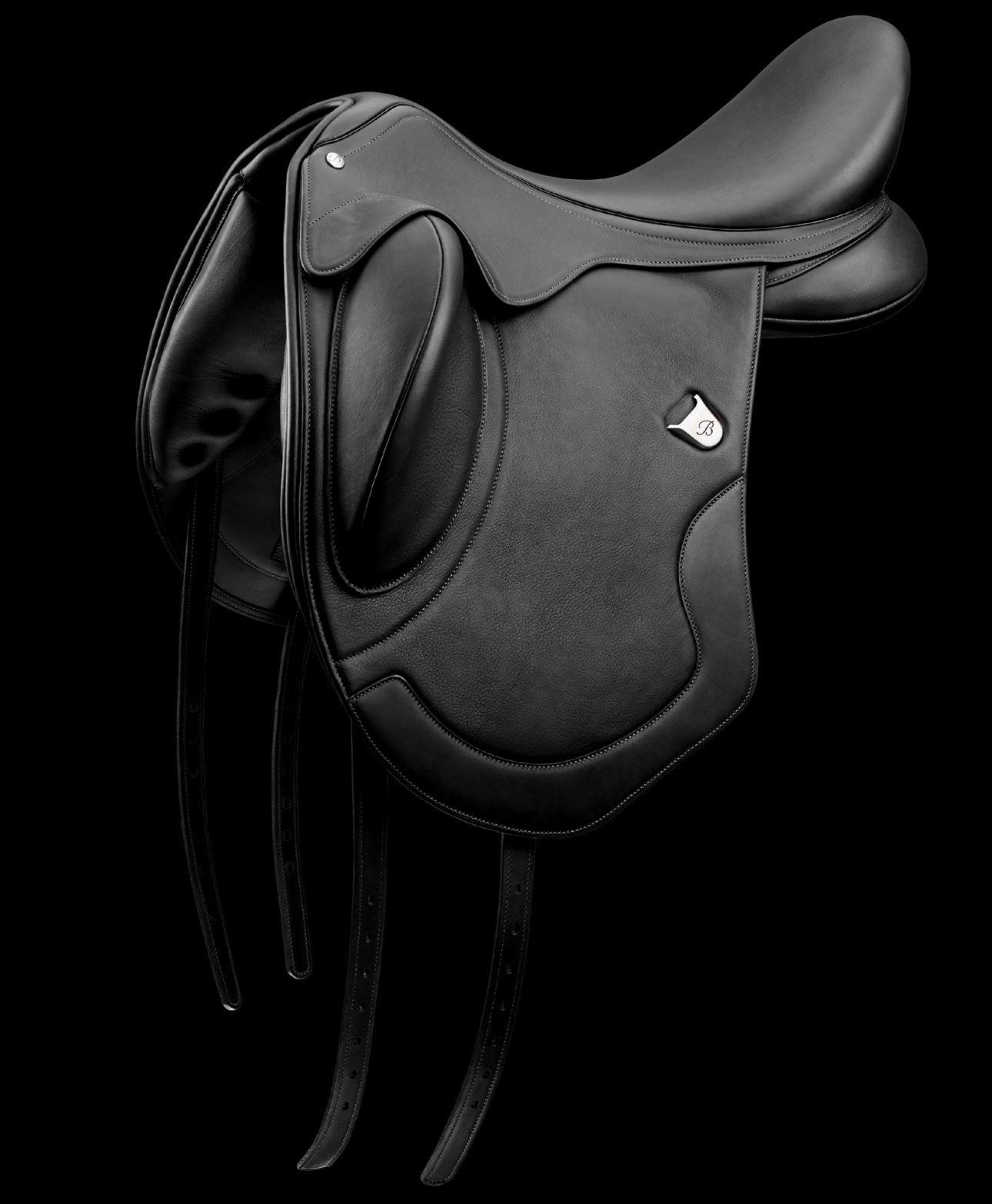

For more information visit batessaddles.com @batessaddles Official Saddle of the United States Eventing Association Official Partner of the German Equestrian Federation (FN) Official Partner of British Eventing
A gold medal doesn’t happen overnight. It takes passion, dedication, hard work and the right nutrition to reach your goals. For over 25 years, Platinum Performance® has been improving the lives of horses by impacting health, from the inside, through advanced nutrition. No matter the level of achievement we seek, the love and care for our horses start from a place deep inside of us all.
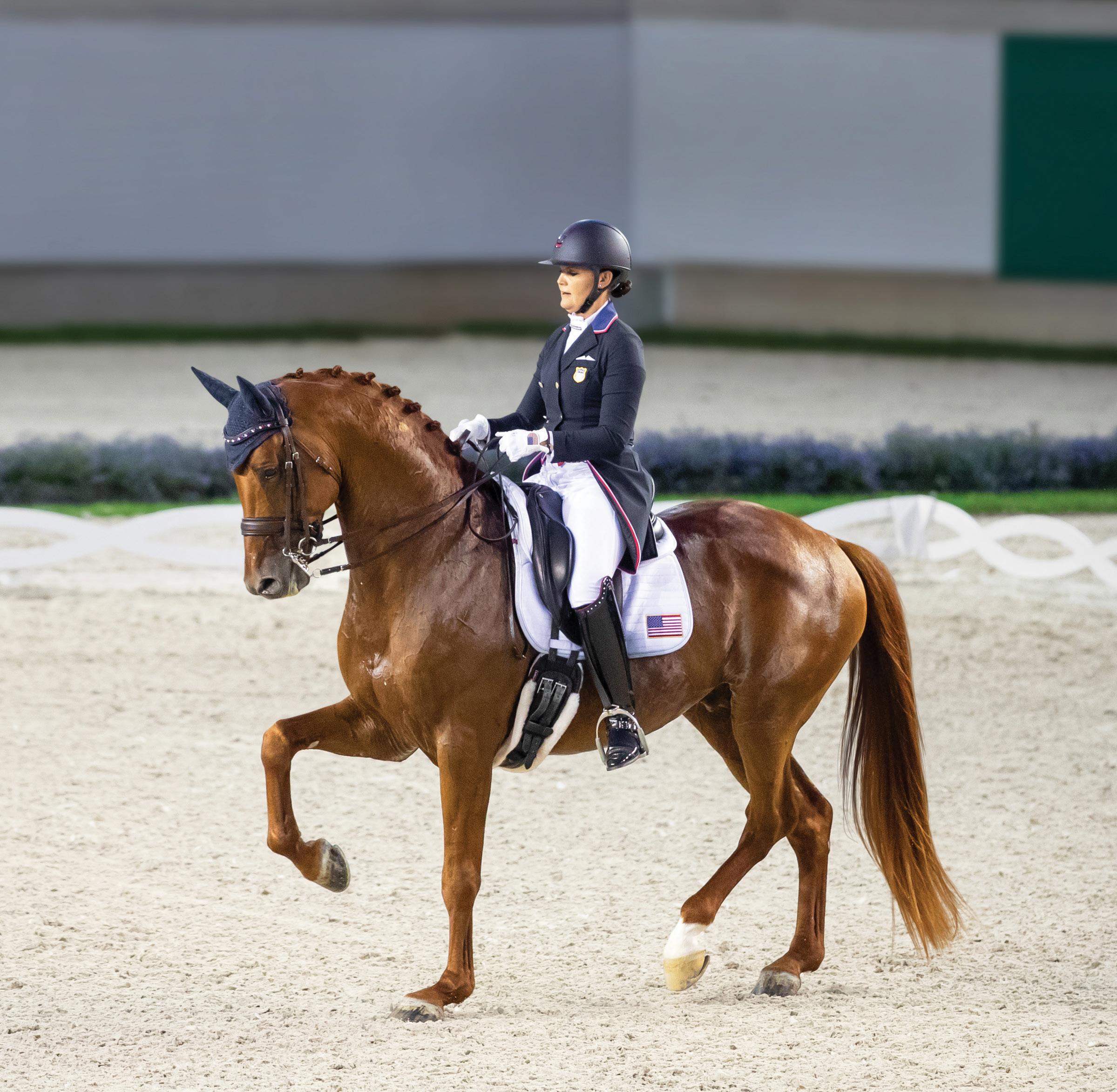
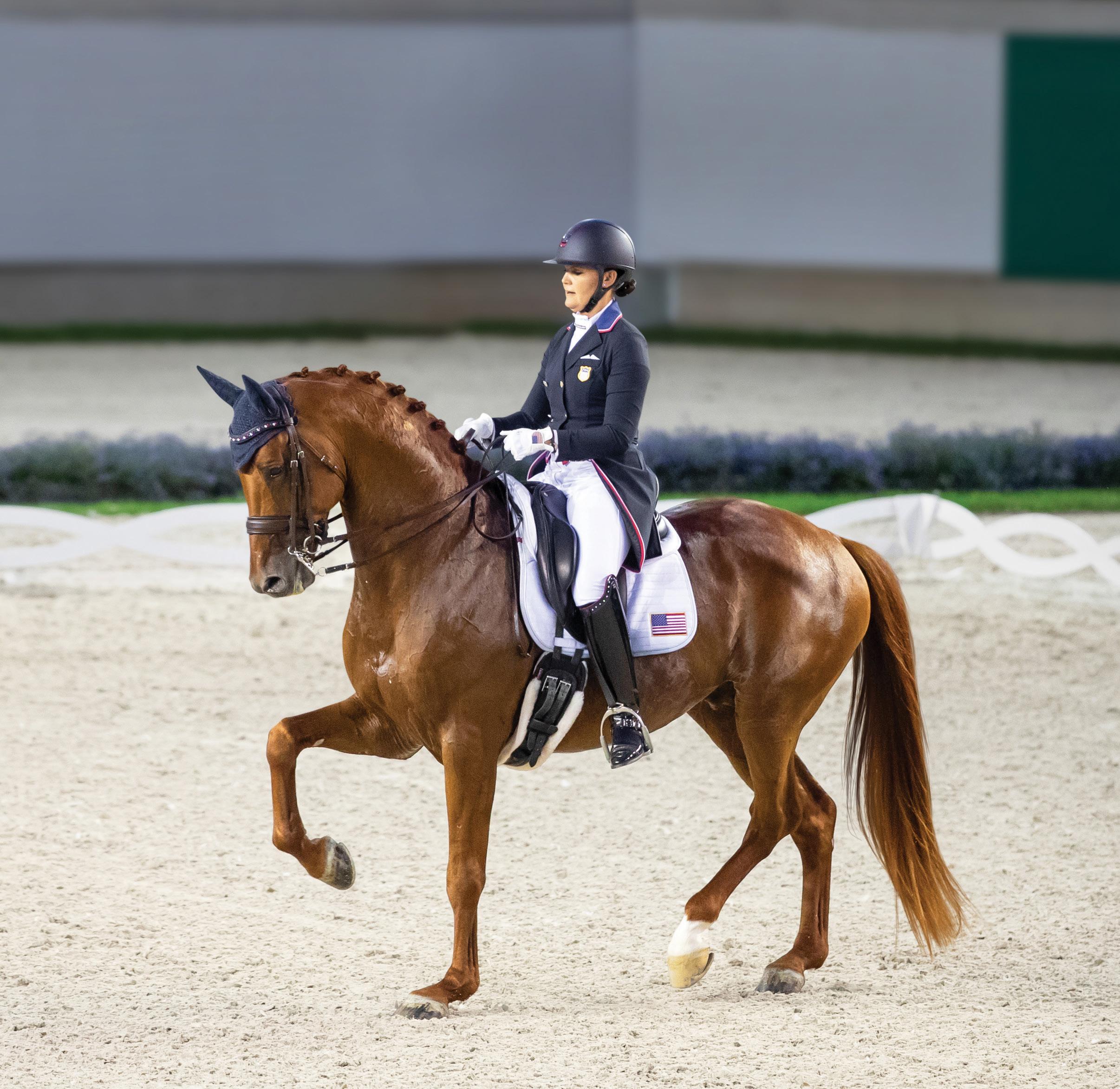
THE POWER OF NUTRITION STARTS WITHIN.
PlatinumPerformance.com | (800) 553-2400
The nutrition supporting Sarah’s team includes:
• Platinum Performance® CJ
• Healthy Weight Sarah Tubman is a sponsored endorsee and actual client.
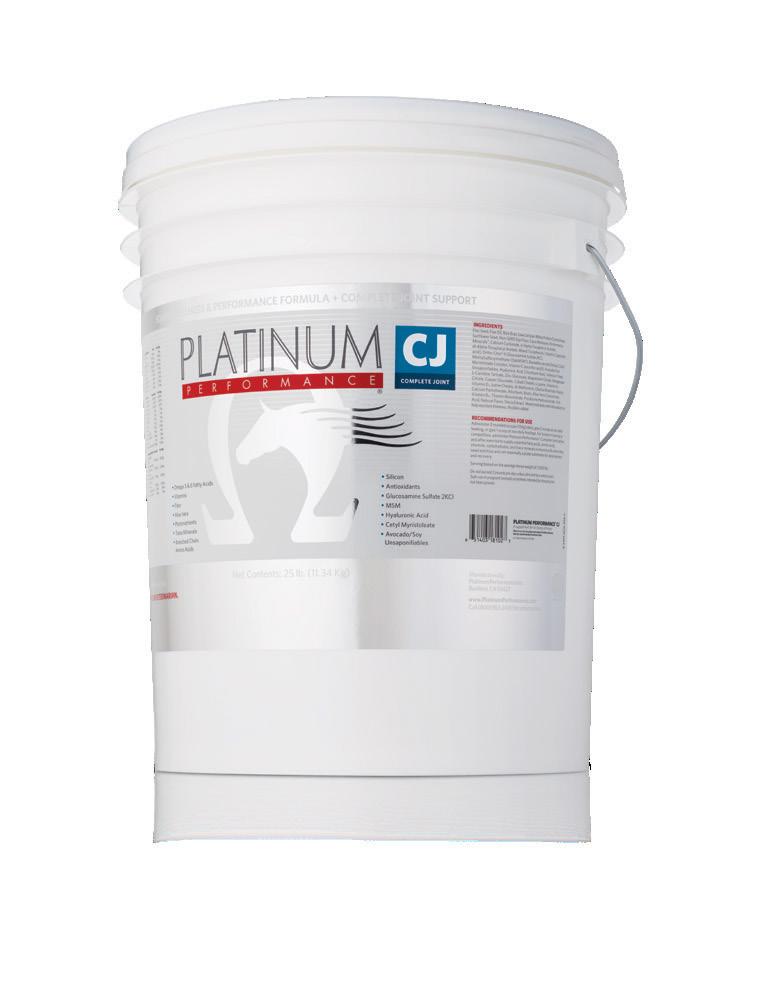
©2022 PLATINUM PERFORMANCE®








































































































































































































































































































































 By Nadine Schwartsman
By Nadine Schwartsman







































 F rom charming towns and bucolic farmland to thrilling equestrian competition, Denmark was a feast for the senses during the Ecco FEI World Championships Herning 2022.
Anush Agarwalla on Sir Caramello OLD was the first pair to represent India at a dressage World Championships
World Championships draw a global list of competitors. Rider Caroline Chew of Singapore jogs Tribiani at the dressage horse inspection.
Steffen Peters and Katie Duerrhammer during an arena-familiarization session
US FEI 5* dressage judge Janet Foy was the FEI technical delegate for the dressage competition
Hotel Ringkøbing, one of the media hotels, is situated in a charming fjordside town
Sailboats moored at Ringkøbing Fjord, adjacent to the North Sea
F rom charming towns and bucolic farmland to thrilling equestrian competition, Denmark was a feast for the senses during the Ecco FEI World Championships Herning 2022.
Anush Agarwalla on Sir Caramello OLD was the first pair to represent India at a dressage World Championships
World Championships draw a global list of competitors. Rider Caroline Chew of Singapore jogs Tribiani at the dressage horse inspection.
Steffen Peters and Katie Duerrhammer during an arena-familiarization session
US FEI 5* dressage judge Janet Foy was the FEI technical delegate for the dressage competition
Hotel Ringkøbing, one of the media hotels, is situated in a charming fjordside town
Sailboats moored at Ringkøbing Fjord, adjacent to the North Sea










 Dotted with the ubiquitous wind turbines, much of the area outside Herning looks like this
Cathrine Laudrup-Dufour prepares to give an interview to Danish TV
Danish rider Carina Cassøe Krüth helps HRH Princess Benedikte of Denmark onto the goldmedal podium during the team medal ceremony. Looking on are Danish dressage chef d’équipe Anne-Mette Binder (red blazer) and members of the bronze-medal-winning German team.
Visitors to the Herning 2022 trade fair
Trade-fair visitors watch dressage competition on a jumbo screen
LEGO PONY PHOTO CREDIT: AZUSA KITANO/JAPAN EQUESTRIAN FEDERATION
Dotted with the ubiquitous wind turbines, much of the area outside Herning looks like this
Cathrine Laudrup-Dufour prepares to give an interview to Danish TV
Danish rider Carina Cassøe Krüth helps HRH Princess Benedikte of Denmark onto the goldmedal podium during the team medal ceremony. Looking on are Danish dressage chef d’équipe Anne-Mette Binder (red blazer) and members of the bronze-medal-winning German team.
Visitors to the Herning 2022 trade fair
Trade-fair visitors watch dressage competition on a jumbo screen
LEGO PONY PHOTO CREDIT: AZUSA KITANO/JAPAN EQUESTRIAN FEDERATION






 BY ANDREW RYBACK
BY ANDREW RYBACK






















































